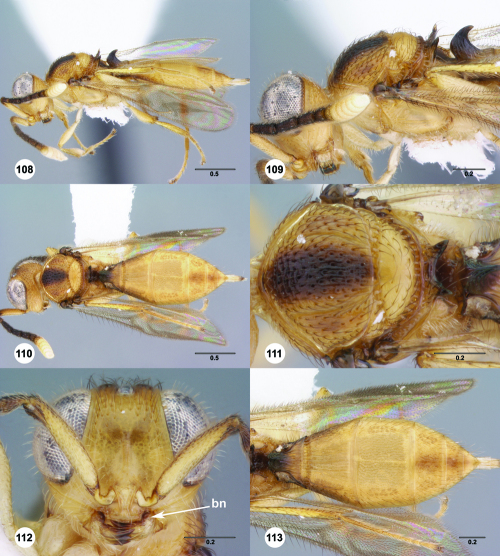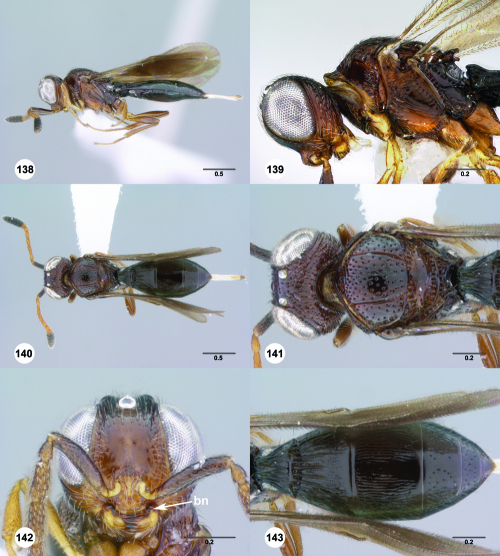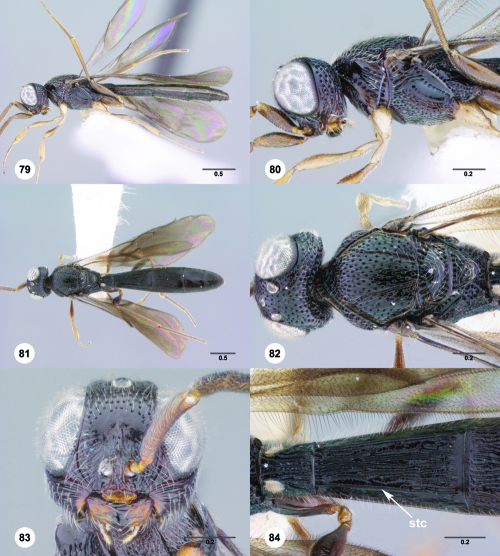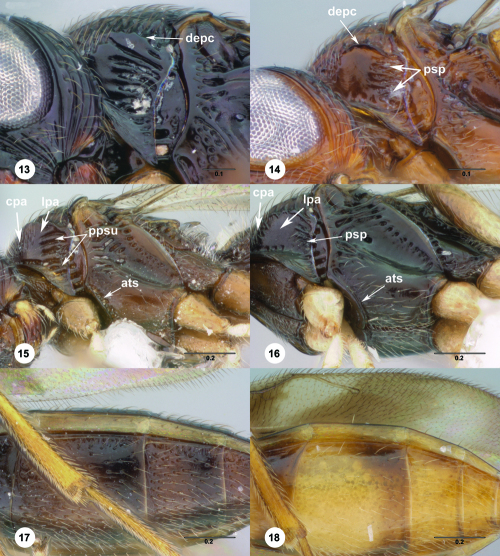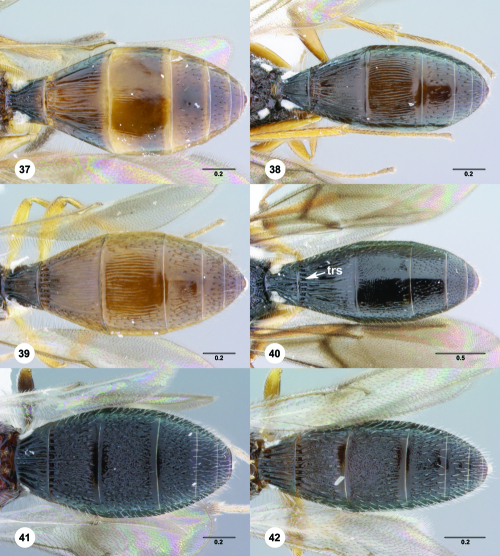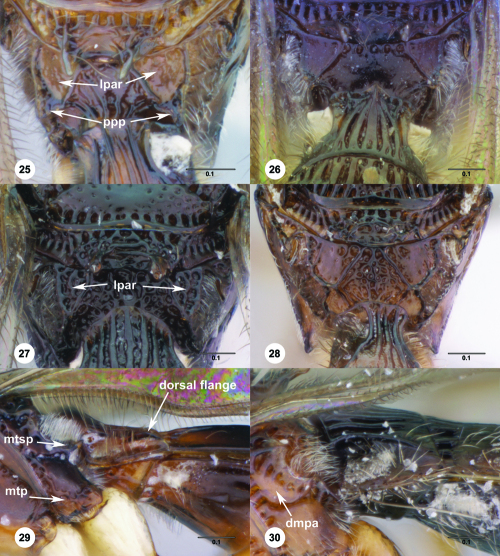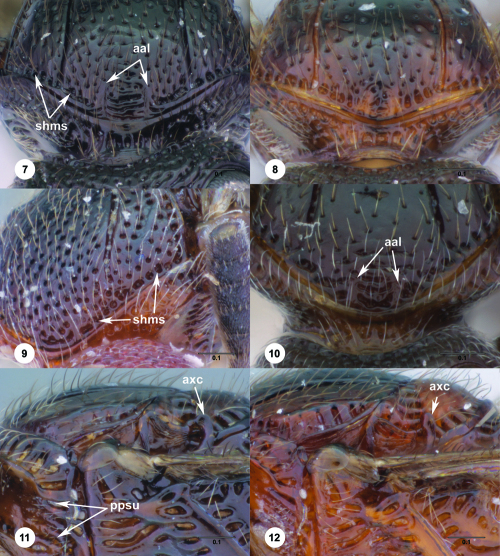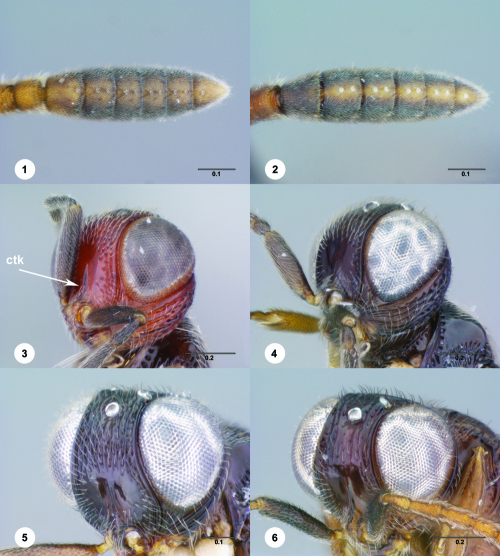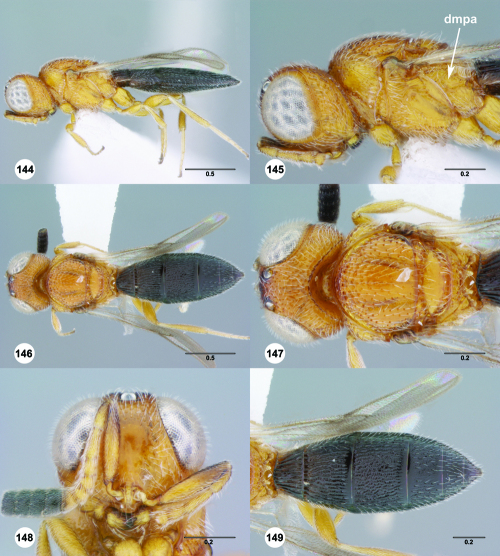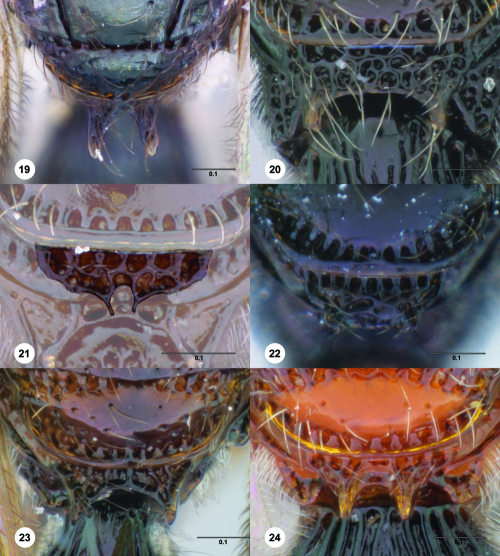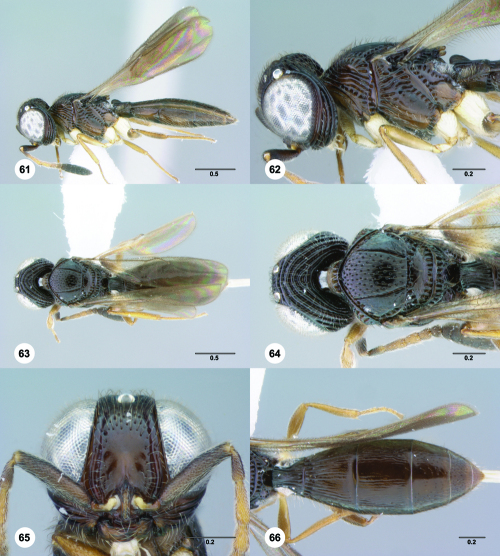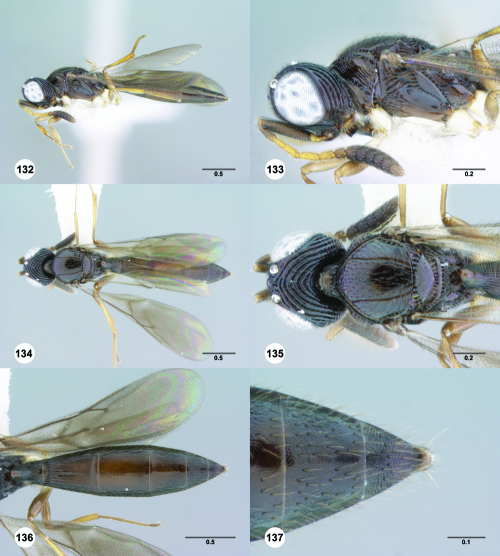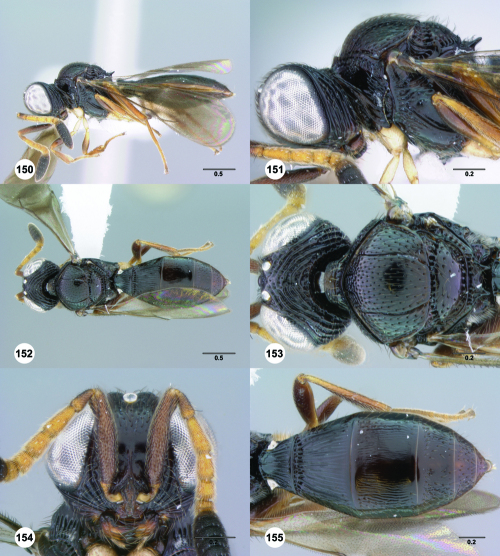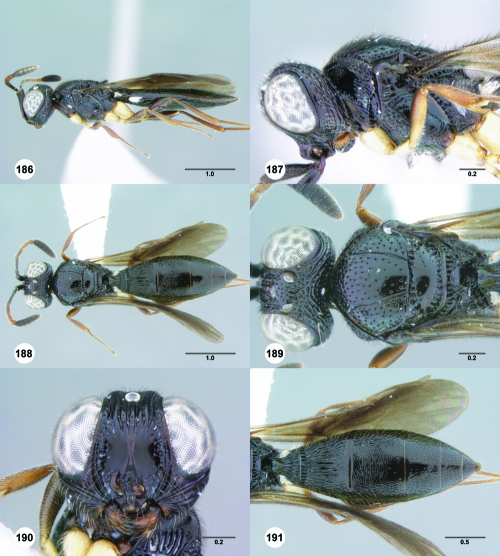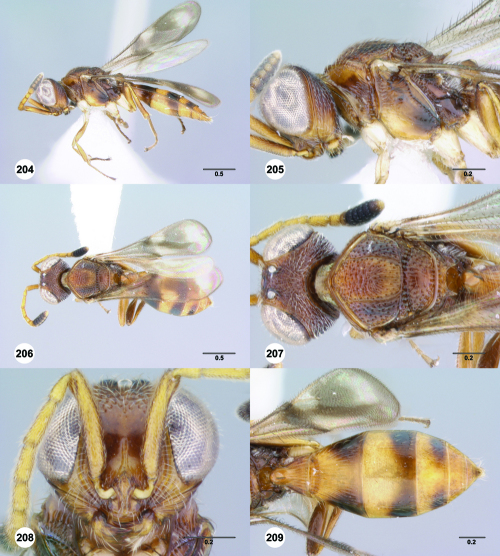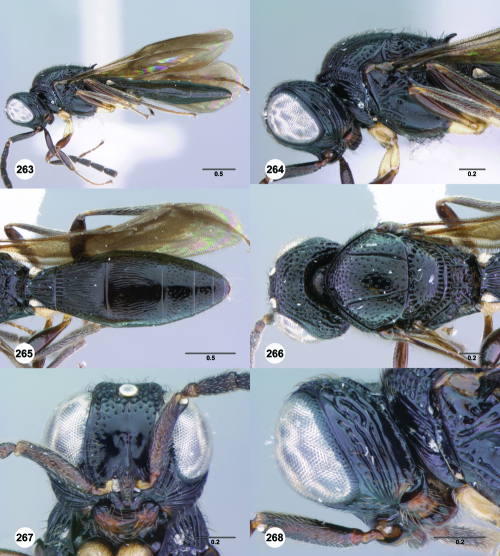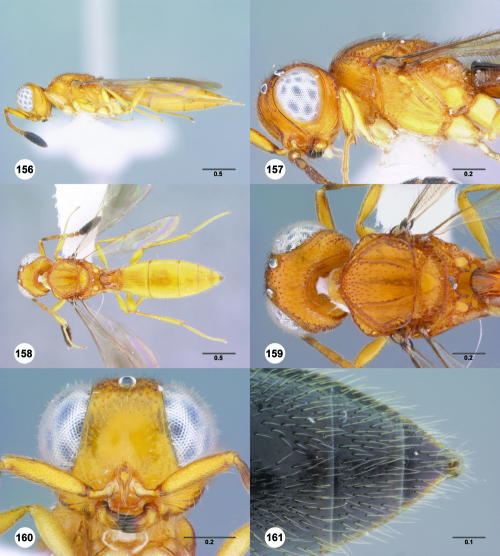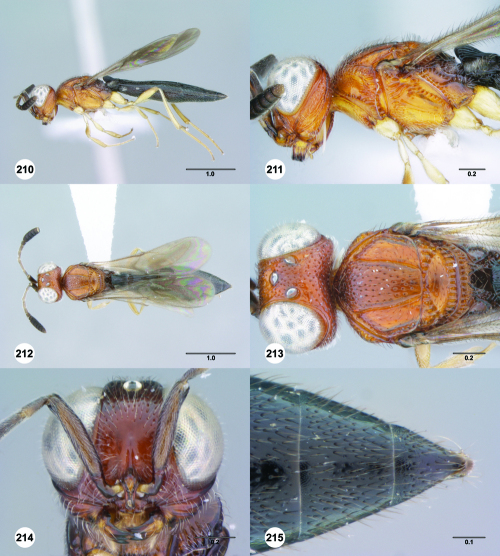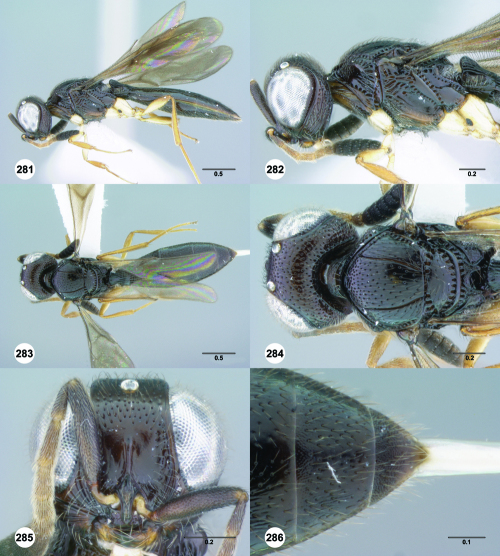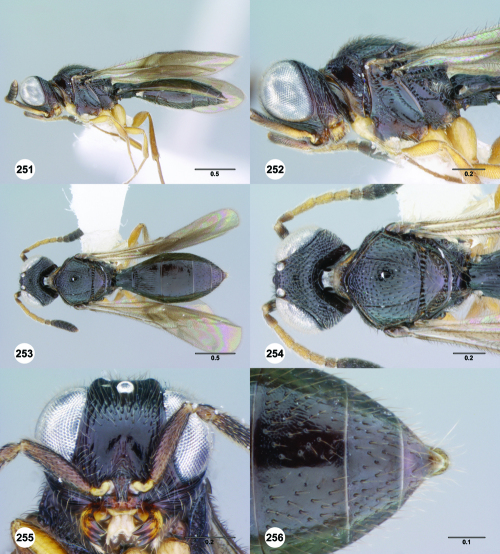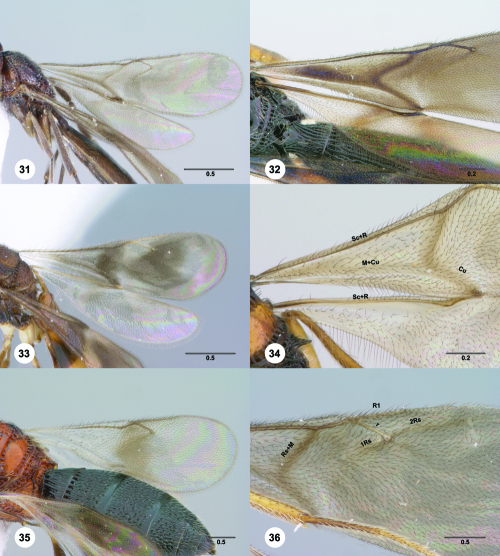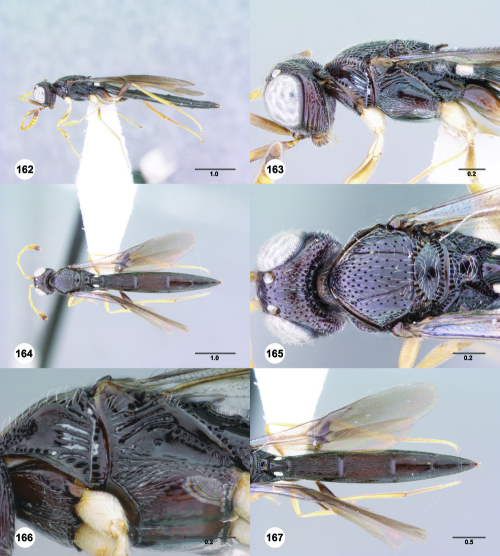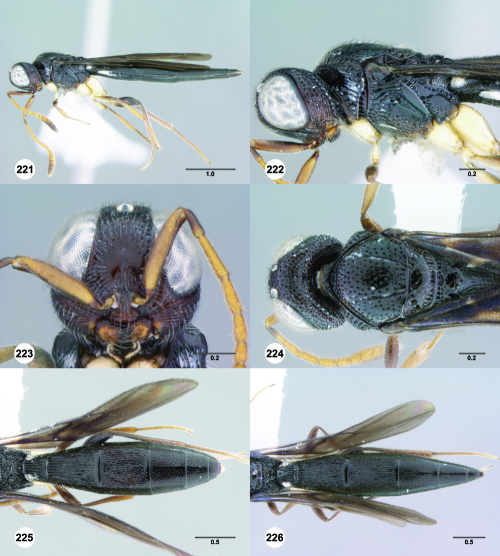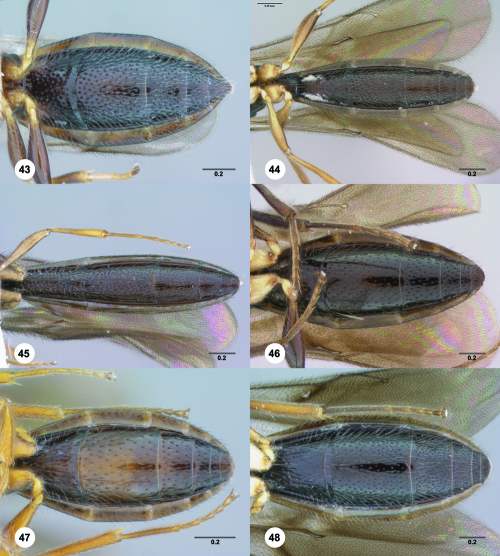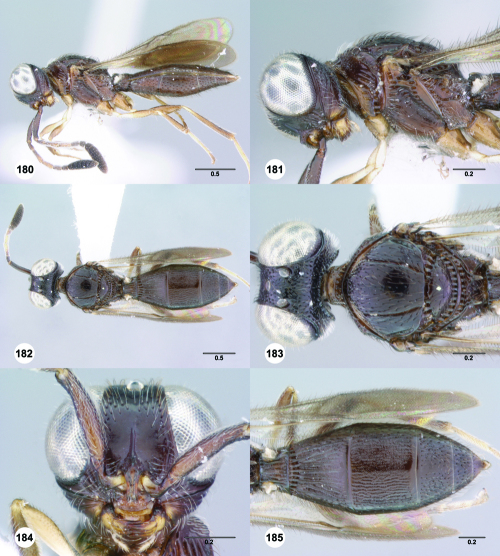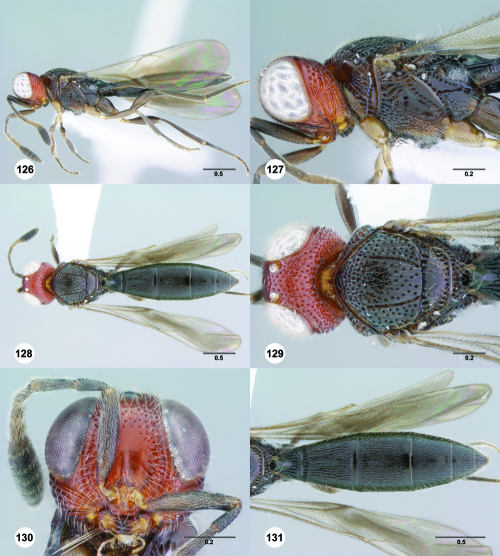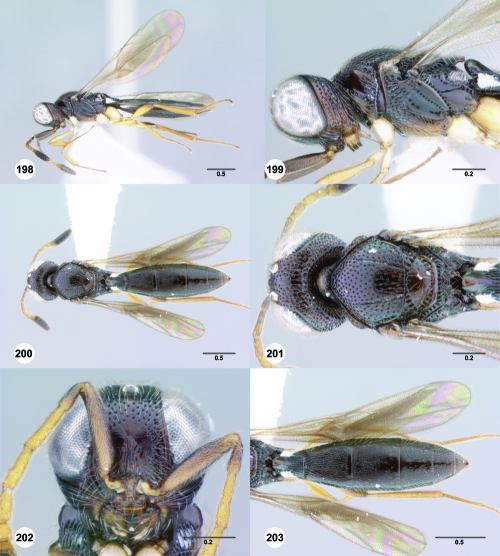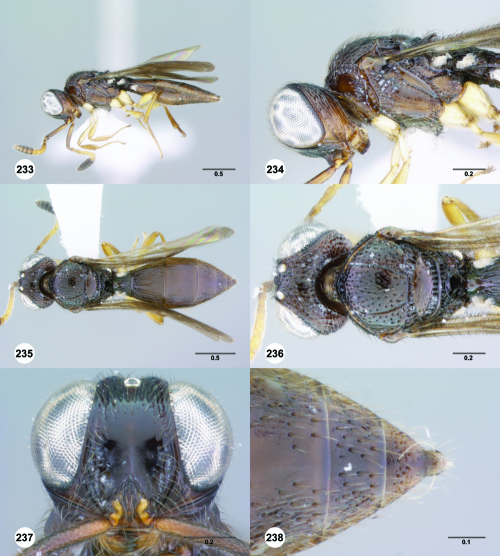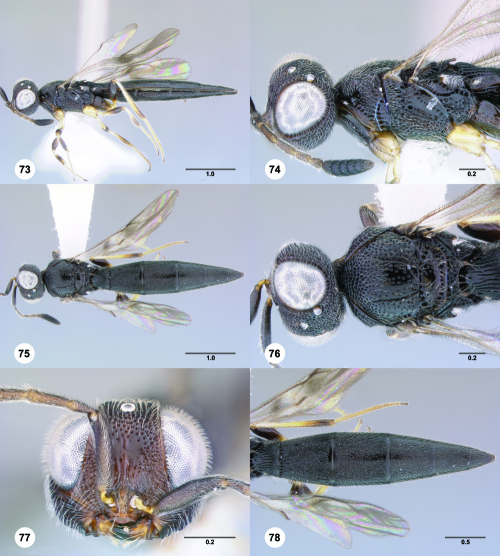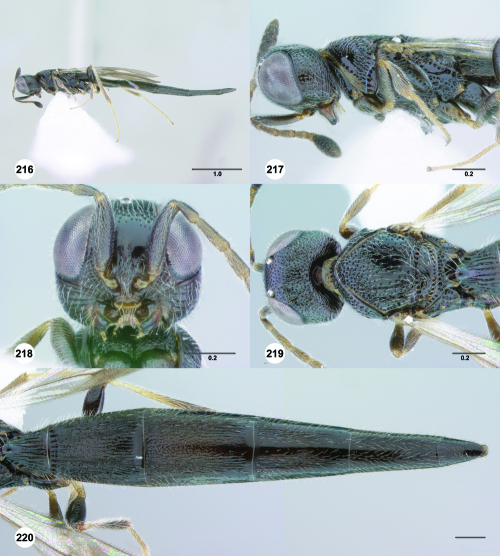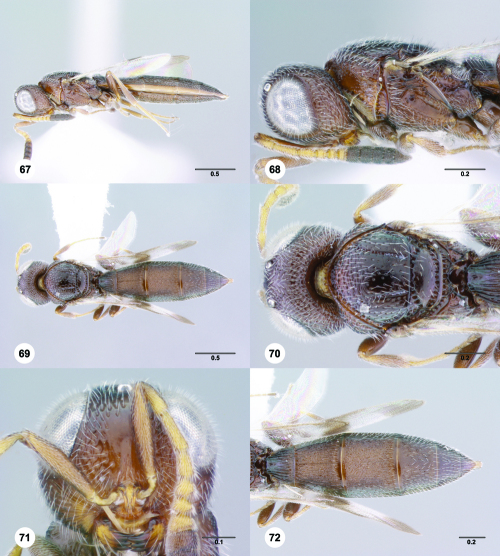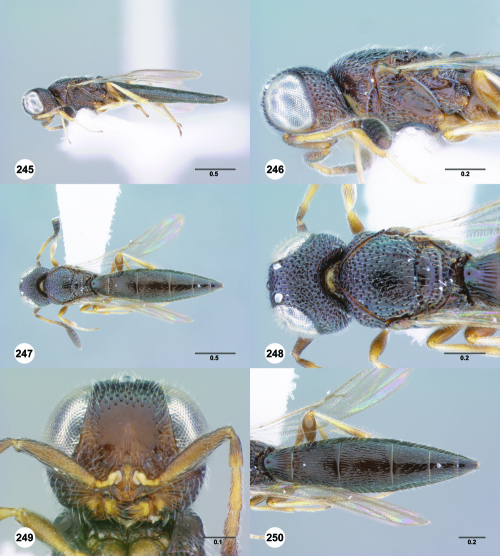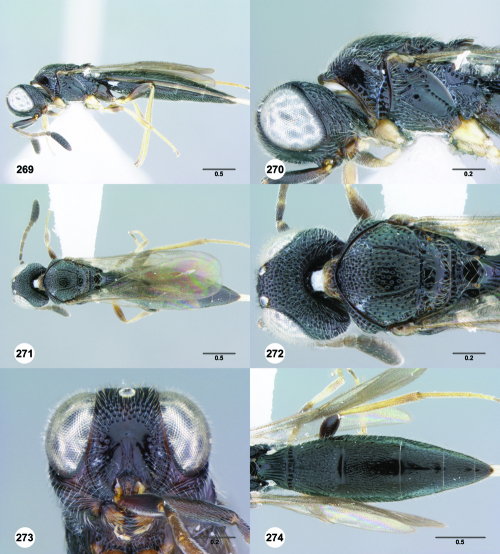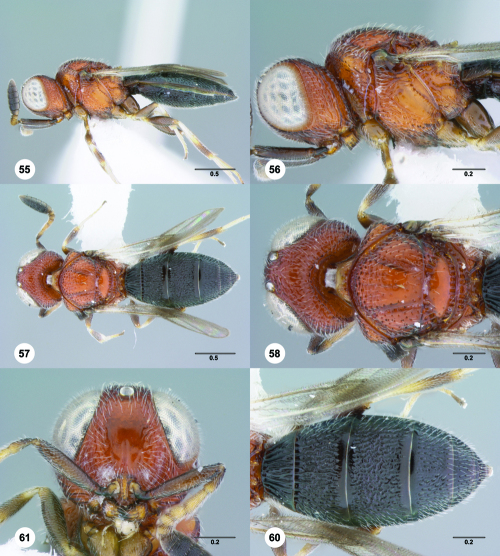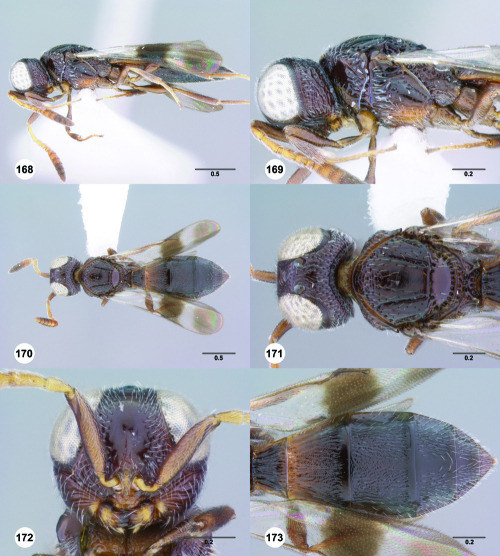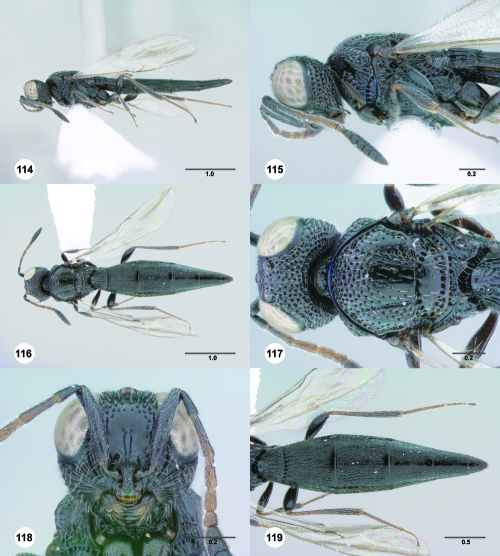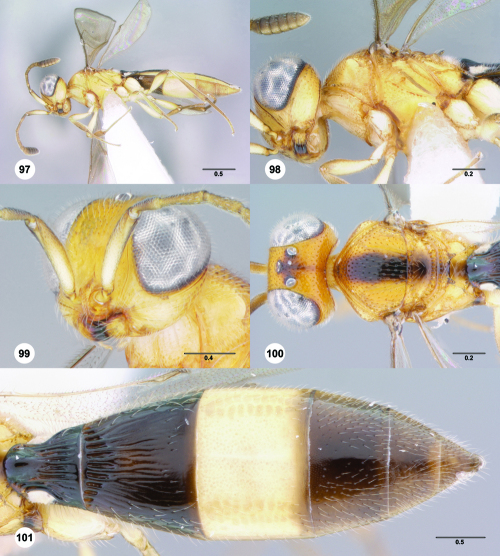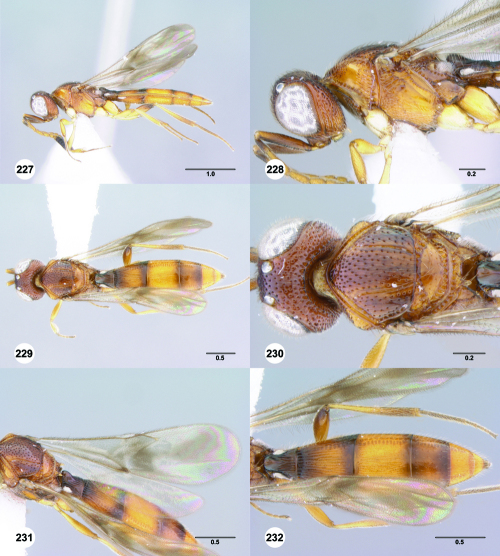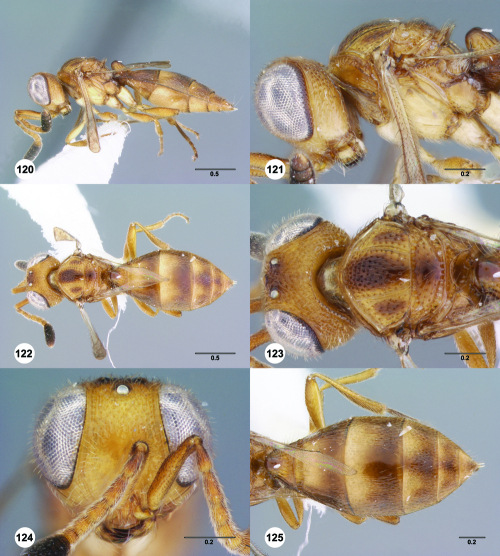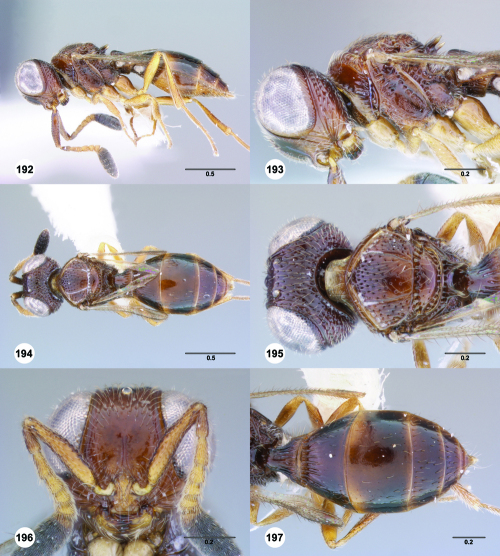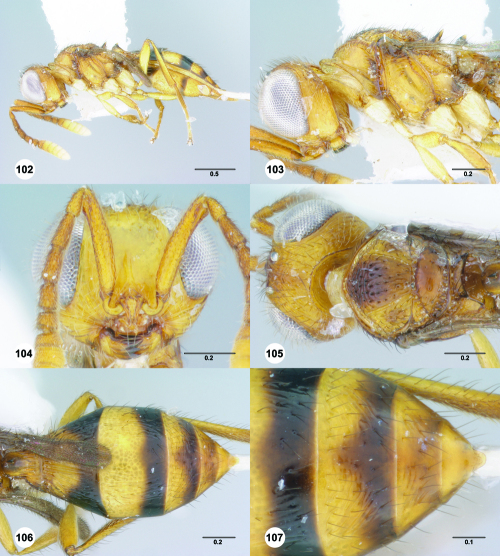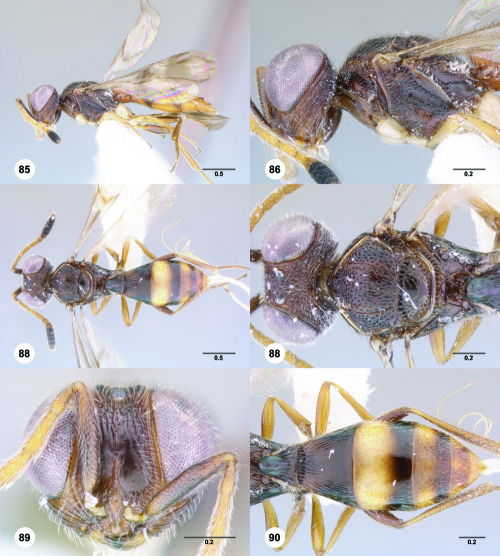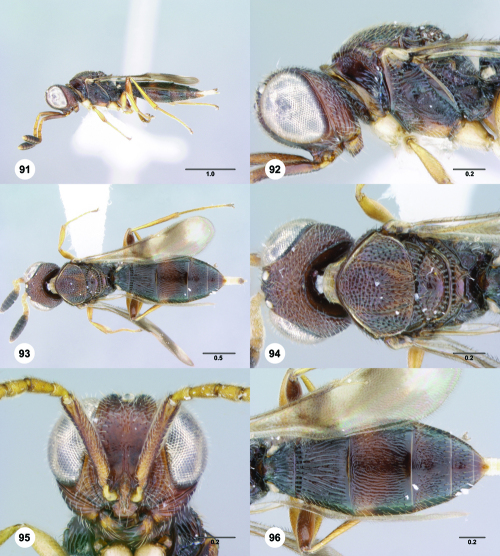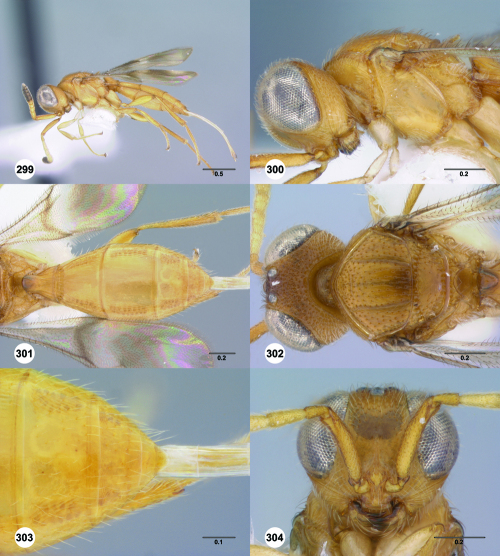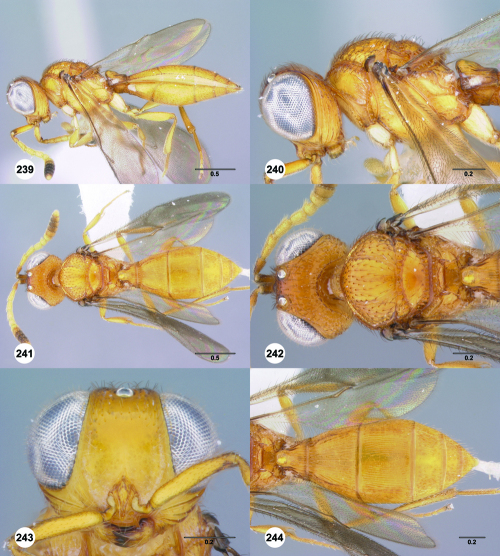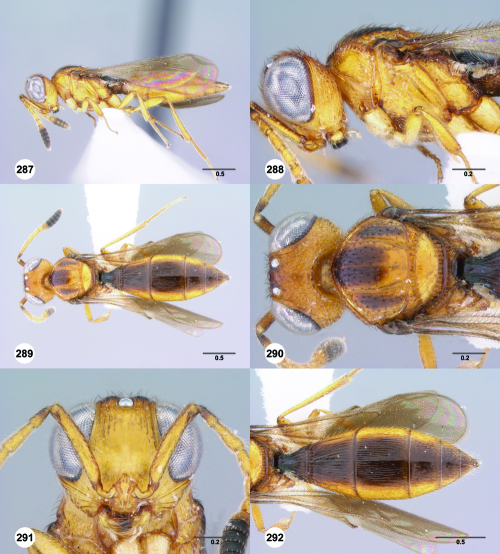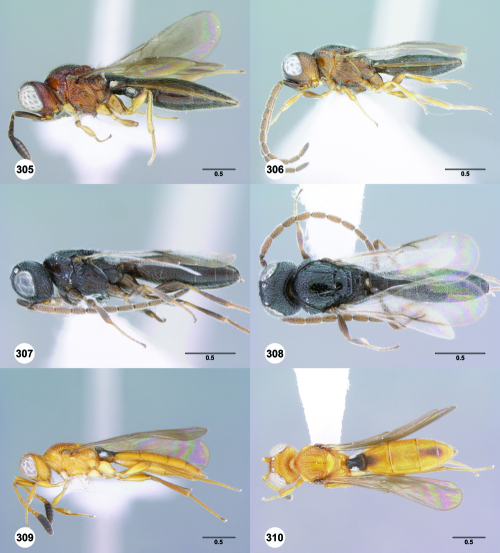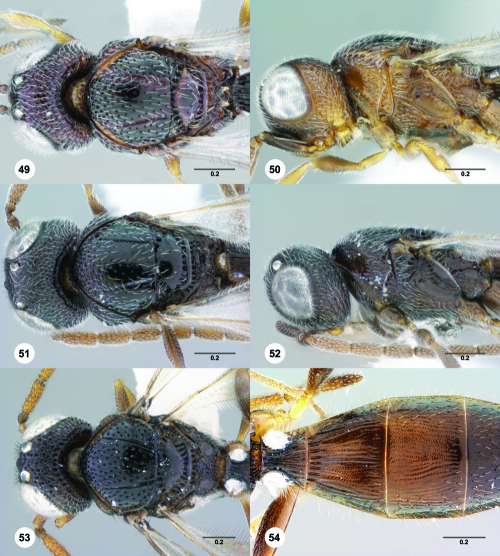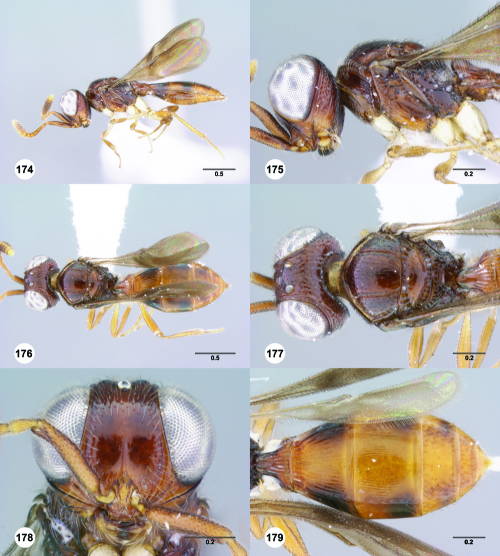Abstract Abstract
The species of the genus Trichoteleia Kieffer (Hymenoptera: Platygastridae) are revised: 42 species are recognized, of which two were previously named and are redescribed: Trichoteleia afo Talamas, sp. n., Trichoteleia albidipes Kieffer, Trichoteleia bicolor Talamas, sp. n.; Trichoteleia bidentata Talamas sp. n.; Trichoteleia carinata Talamas, sp. n.; Trichoteleia cincta Talamas & Masner, sp. n.; Trichoteleia delilah Talamas, sp. n.; Trichoteleia eburata Talamas, sp. n.; Trichoteleia echinata Talamas, sp. n.; Trichoteleia fisheri Talamas & Masner, sp. n.; Trichoteleia funesta Talamas, sp. n.; Trichoteleia halterata Talamas & Masner, sp. n.; Trichoteleia hemlyae Talamas & Masner, sp. n.; Trichoteleia irwini Talamas & Masner, sp. n.; Trichoteleia janus Talamas, sp. n.; Trichoteleia jiro Talamas, sp. n.; T. ketrona Talamas, sp. n.; Trichoteleia levii Talamas & Johnson, sp. n.; Trichoteleia longiventris Talamas & Masner, sp. n.; Trichoteleia minima Talamas, sp. n.; Trichoteleia nify Talamas & Masner, sp. n.; Trichoteleia oculea Talamas, sp. n.; Trichoteleia orona Talamas & Masner, sp. n.; Trichoteleia parvipennis Talamas & Masner, sp. n.; Trichoteleia pauliani (Risbec); Trichoteleia picturata Talamas, sp. n.; Trichoteleia prima Talamas, sp. n.; Trichoteleia prolixa Talamas, sp. n.; Trichoteleia quazii Talamas, sp. n.; Trichoteleia ravaka Talamas, sp. n.; Trichoteleia rugifrons Talamas & Masner, sp. n.; Trichoteleia solocis Talamas, sp. n.; Trichoteleia sphaerica Talamas, sp. n.; Trichoteleia subtilis Talamas & Masner, sp. n.; Trichoteleia tahotra Talamas & Masner, sp. n.; Trichoteleia takariva Talamas, sp. n.; Trichoteleia tezitra Talamas, sp. n.; Trichoteleia tigris Talamas, sp. n.; Trichoteleia tonsa Talamas, sp. n.; Trichoteleia warreni Talamas & Masner, sp. n.; Trichoteleia xantrox Talamas, sp. n.; Trichoteleia zuparkoi Talamas & Masner, sp. n. A neotype is designated for Trichoteleia albidipes and a lectotype is designated for Trichoteleia pauliani.
Keywords: Platygastridae, Scelionidaem, Trichoteleia, key, revision, monograph, database, endemicity, Madagascar
Introduction
The richness and endemicity of Madagascar’s fauna and flora is well documented in a wide variety of organisms. The genus Trichoteleia is an example that fits this pattern with 42 species known only from Madagascar and the surrounding islands. More than half of the species treated in this revision are represented by five or fewer specimens, and many are known from singletons, suggesting that more species remain to be discovered. The extraordinary explosion of species presented in this paper highlights the importance of faunal exploration in Madagascar and other regions with rapidly vanishing biodiversity.
The genus Trichoteleia was described by J. J. Kieffer (1910) to contain one species, Trichoteleia albidipes Kieffer, which was based on a single male specimen collected in Madagascar during an expedition of the German zoologist Alfred Voeltzkow. Alan Dodd described 6 species as Trichoteleia between 1914 and 1920, all of which were eventually transferred to Calliscelio Ashmead (Galloway 1976, Masner 1976), Styloteleia Kieffer (Dodd 1929, Masner 1976) and Baryconus Förster (Masner 1965). Masner (1976) transferred Alloteleia pauliani Risbec to Trichoteleia. At the time of that publication Masner was unable to locate the holotype of Trichoteleia albidipes in Berlin, and all of the platygastroids described by Kieffer from the Voeltzkow expedition are now considered to be lost.
The goal of this paper is to reevaluate the generic concept of Trichoteleia, to provide characters by which it may be unambiguously identified, and to document its species. This work is conducted as part of the Platygastroidea Planetary Biodiversity Inventory and represents a step toward revision of the Scelionini sensu lato and resolution of the relationships between its constituent genera. The contributions of the authors are as follows: E.J. Talamas: character definition, generic concept development, species concept development, imaging, key development, manuscript preparation; L. Masner: generic concept development, species concept development, manuscript preparation, key preparation; N.F. Johnson: character definition, species concept development, manuscript preparation, key development. The responsible authors of the new species are indicated by their names in the heading of each description.
Materials and methods
This work is based upon specimens deposited in the following collections, with abbreviations used in the text: CASC, California Academy of Sciences, San Francisco, CA1; CNCI, Canadian National Collection of Insects, Ottawa, Canada2; MNHN, Muséum National d’Histoire Naturelle, Paris, France3; OSUC, C.A. Triplehorn Insect Collection, Columbus, OH4; UCDC, R. M. Bohart Museum of Entomology, Davis, CA5; USNM, National Museum of Natural History, Washington, DC6.
Abbreviations and morphological terms used in text: A1, A2, ... A12: antennomere 1, 2, ... 12; claval formula: distribution of the large, multiporous basiconic sensilla on the underside of apical antennomeres of the female, with the segment interval specified followed by the number of sensilla per segment (Bin 1981); S1, S2, ... S6: metasomal sternite 1, 2, ... 6; T1, T2, ... T7: metasomal tergite 1, 2, ... 7. basal node on mandible: dorsal enlargement at base of mandible, usually with apically adjacent notch (bn; Figs 112, 142); sublateral tergal carina: longitudinal carina at the junction of dorsal and lateral faces of a metasomal tergite (stc; Fig. 84); pronotal setal patch: patch of setae along posterior pronotal sulcus (psp; Figs 14, 16); posterior vertex: area between the posterior ocelli and the occipital carina; transverse sulcus on T2: transverse sulcus along anterior margin of T2 (trs; Fig. 40); metapleural spine: posteriorly pointing process formed from the metapleural carina (mtsp; Fig. 29).
Figures 108–113.
86Trichoteleia fisheri sp. n., female holotype (OSUC 181008). 108 Lateral habitus 109 Head and mesosoma, lateral view 110 Dorsal habitus 111 Mesosoma, dorsal view 112 Head, anterior view 113 Metasoma, dorsal view. Scale bars in millimeters.
Figures 138–143.
90138, Trichoteleia janus sp. n. Lateral habitus, female (CASENT 2042242) 139 Head and mesosoma, lateral view, female holotype (CASENT2135979) 140 Dorsal habitus, female (CASENT 2042242) 141 Head and mesosoma, dorsal view, female (CASENT 2042242) 142 Head, anterior view, female (CASENT 2043786) 143 Metasoma, dorsal view, female (CASENT 2042242). Scale bars in millimeters.
Figures 79–84.
81Trichoteleia carinata sp. n. 79 Lateral habitus, male (OSUC 181062) 80 Head and mesosoma, lateral view, male (OSUC 181062) 81 Dorsal habitus, male holotype (OSUC 181015) 82 Head and mesosoma, dorsal view, male holotype (OSUC 181015) 83 Head, anterior view, male holotype (OSUC 181015) 84 Metasoma, dorsal view, male holotype (OSUC 181015). Scale bars in millimeters.
Figures 13–18.
70 13 Trichoteleia takariva sp. n., Pronotum, lateral view, male holotype (CASENT 2043217) 14 Trichoteleia janus sp. n., Pronotum, lateral view, male (CASENT 2043786) 15 Trichoteleia oculea sp. n., Mesosoma, ventrolateral view, female (CASENT 2135908) 16 Trichoteleia tahotra sp. n., Mesosoma ventrolateral view, female holotype (OSUC 181002) 17 Trichoteleia delilah sp. n., Metasoma, ventrolateral view, female holotype (CASENT 2135905) 18 Trichoteleia picturata sp. n., Metasoma, ventrolateral view, female holotype (CASENT 2135904). Scale bars in millimeters.
Figures 37–42.
74 37 Trichoteleia tigris sp. n., Metasoma, dorsal view, male (CASENT 2134160) 38 Trichoteleia janus sp. n., Metasoma, dorsal view, male (CASENT 2043786) 39 Trichoteleia rugifrons sp. n., Metasoma, dorsal view, male (CASENT 2135938) 40 Trichoteleia orona sp. n., Metasoma, dorsal view, male (CASENT 2134153) 41 Trichoteleia afo sp. n., Metasoma, dorsal view, male (CASENT 2134153) 42 Trichoteleia jiro sp. n., Metasoma, dorsal view, male (OSUC 143329). Scale bars in millimeters.
Figures 25–30.
72 25 Trichoteleia tahotra sp. n., Propodeum, dorsal view, female (CASENT 2043325) 26 Trichoteleia oculea sp. n., Propodeum, posterodorsal view, female (CASENT 2135907) 27 Trichoteleia bidentata sp. n., Propodeum, posterodorsal view, male (CASENT 2132802) 28 Trichoteleia tigris sp. n., Propodeum, posterodorsal view, male (CASENT 2135854) 29 Trichoteleia nify sp. n., Metapleuron and T1, lateral view, female holotype (CASENT 2135909) 30 Trichoteleia levii sp. n., Metapleuron and T1, lateral view, female (CASENT 2043789). Scale bars in millimeters.
We divide the epomial carina into vertical and dorsal components. The former is not present as external ridge in Trichoteleia but we consider it to be homologous with the division line between the setaceous cervical pronotal area and the glabrous (anteriorly) lateral pronotal area.
Mikó et al. (2007) used the metapleural epicoxal carina to posteriorly delimit the metapleural triangle. This carina is not present in some species of Trichoteleia, but we use the term metapleural triangle nonetheless to refer to the same anteroventral area of the metapleuron.
The following morphological terms are illustrated and labeled to facilitate their use. Definitions and abbreviations follow Mikó et al. (2007).
Antero-admedian lines (aal; Figs 7, 10)
Figures 7–12.
69 7 Trichoteleia takariva sp. n., Antero-admedian line, anterodorsal view, male holotype (CASENT 2043217) 8 Trichoteleia janus sp. n., Antero-admedian line, anterodorsal view, male (CASENT 2043786) 9 Trichoteleia hemlyae sp. n., Notaulus, anterodorsal view, female (OSUC 181027) 10 Trichoteleia minima sp. n., Notaulus, anterodorsal view, female holotype (CASENT 2043543) 11 Trichoteleia prima sp. n., Scutellar-axillar complex, lateral view, female (CASENT 2134201) 12 Trichoteleia levii sp. n., Scutellar-axillar complex, lateral view, female (CASENT 2043789). Scale bars in millimeters.
Axillular carina (axc: Figs 11, 12)
Central keel (ctk; Fig. 3)
Figures 1–6.
68 1 Trichoteleia delilah sp. n., Antennal clava, ventral view, female (CASENT 2135905) 2 Trichoteleia orona sp. n., Antennal clava, ventral view, female (CASENT 2043194) 3 Trichoteleia hemlyae sp. n., Head, anterolateral view, female (CASENT 2043942) 4 Trichoteleia pauliani sp. n., Head, anterolateral view, female (CASENT 2136193) 5 Trichoteleia subtilis sp. n., Head, anterolateral view, female (CASENT 2134158) 6 Trichoteleia janus sp. n., Head, anterolateral view, female (CASENT 2042242). Scale bars in millimeters.
Cervical pronotal area (cpa; Figs 15, 16)
Dorsal epomial carina (depc; Figs 13, 14)
Dorsal metapleural area (dmpa; Figs 30, 145)
Figures 144–149.
91143, Trichoteleia jiro sp. n., female holotype (CASENT 2043784). 144 Lateral habitus 145 Head and mesosoma, lateral view 146 Dorsal habitus 147 Head and mesosoma, dorsal view 148 Head, anterior view 149 Metasoma, dorsal view. Scale bars in millimeters.
Lateral pronotal area (lpa; Figs 15, 16)
Lateral propodeal area (lpar; Figs 25, 27)
Mesoscutal suprahumeral sulcus (shms; Figs 7, 9)
Metapleural triangle (mtp; Fig. 29)
Postacetabular sulcus (ats; Figs 15, 16)
Posterior pronotal sulcus (ppsu; Figs 11, 15)
Posterior propodeal projection (ppp; Fig. 25)
Morphological terminology otherwise follows Mason (1986), Masner (1980) and Mikó et al. (2007).
The locality data reported for primary types are not a literal transcription of the labels: some abbreviations are expanded; additional data from the collectors is also included. The holotypes should be unambiguously identifiable by means of the unique identifier or the red holotype label. The numbers prefixed with “OSUC ” and “CASENT ” are unique identifiers for the individual specimens (note the blank space after the acronyms). Details on the data associated with these specimens may be accessed at the following link, purl.oclc.org/NET/hymenoptera/hol, and entering the identifier in the form.
The species descriptions are generated by a database application, vSysLab (purl.oclc.org/NET/hymenoptera/vSysLab), designed to facilitate the generation of taxon by character data matrices, to integrate these with the existing taxonomic and specimen-level database, and to export the data both as text and as input files for other applications. The output is in the format of “Character: Character state(s).” Images were produced using AutoMontage extended-focus software. The individual images are archived at the image database at The Ohio State University (purl.oclc.org/NET/hymenoptera/specimage) and with MorphBank (www.morphbank.net), the latter also contains collections of images organized by plate. All new species have been prospectively registered with Zoobank (Polaszek et al. 2005) and other taxonomic names have been retrospectively registered therein. All names are also registered in the Hymenoptera Name Server (hns.osu.edu). Life sciences identifiers, lsids, may be resolved at the URLs specified in the footnotes or at lsid.tdwg.org.
For the purpose of this revision, species are defined as taxa diagnosable by putative autapomorphies or a unique combination of fixed character states.
Taxonomy
Trichoteleia
Kieffer
urn:lsid:zoobank.org:act:443BC2B3-C498-4899-8291-07F0EA347FEE
urn:lsid:biosci.ohio-state.edu:osuc_concepts:573
Trichoteleia : Kieffer 1910: 530. Original description. Type: Trichoteleia albidipes Kieffer, by monotypy. Kieffer 1910: 64, 77. (description, list of species, keyed); Kieffer 1912: 227. (description); Kieffer 1926: 269, 402. (description, keyed); Muesebeck and Walkley 1956: 405. (citation of type species); Masner 1976: 41. (description); Johnson 1992: 506. (catalog of world species).
Description.
Length 2.1–4.1 mm; body moderately to markedly elongate, robust.
Head
in dorsal view transverse to subspherical; vertex smooth to coarsely sculptured; hyperoccipital carina absent; occipital carina usually well developed and continuous medially; lateral ocellus contiguous with inner orbit of compound eye or distinctly separated from it, OOL less than or equal to diameter of lateral ocellus; compound eye large, setose; frons shallowly concave to slightly convex, usually with central keel; interantennal process present, large; antennal foramen very large; submedian carina absent; orbital carina present or absent; lower frons, laterad of orbital carina, with fanlike striae; lower frons between orbital carina and interantennal process without striae; inner ocular orbits parallel or diverging ventrally; clypeus narrow, slightly convex; malar sulcus present; gena in dorsal view variably expanded posteriorly, sculpture variable; labrum hidden behind clypeus; mandible of moderate length, apex with two or three apical, acute, teeth, teeth arrayed transversely; maxillary palpus 4-segmented, all segments cylindrical; labial palpus 2-segmented; antenna 12-merous in both sexes; radicle inserted into ventral apex of scape, strongly curved; scape more or less cylindrical, ventral surface flattened; A3 in females longer than A2; basiconic sensilla on female antenna arranged singly or in longitudinal pairs on apical antennomeres; claval formula A12–A7:1-2-2-2-2-(1,0); male antenna with tyloid on A5.
Mesosoma
in dorsal view longer than wide, in lateral view longer than high; pronotum in dorsal view strip-like to moderately broad laterally, anterolateral corners rounded to angulate; transverse pronotal carina present or absent; lateral pronotum without vertical epomial carina but usually with distinct transition line between sculptured cervical pronotal area and smooth lateral pronotal area; dorsal epomial carina present; lateral face of pronotum slightly to moderately concave below dorsal epomial carina, facing anterolaterally; pronotal setal patch present, accompanied by striate or rugulose sculpture; netrion present, glabrous, moderately wide, open or closed ventrally; anterior margin of mesoscutum weakly to strongly flexed ventrally to meet pronotum; mesoscutum pentagonal in outline, posterolateral corner rounded; parapsidal line visible; notaulus present, percurrent or incomplete and reaching mesoscutal suprahumeral sulcus as a row of punctures; skaphion absent; transscutal articulation well-developed; mesoscutellum transverse, narrowing laterally, posterior margin convex to straight; axilla small, dorsal margin sinuate; metanotum short, metascutellum sparsely to moderately setose, clearly differentiated, apex bifid to bispinose; plical area densely setose; lateral propodeal carina and plica well developed, forming triangular to quadrate lateral propodeal area; mesopleural depression well developed; anterior half of mesopleural carina present; posterior half of mesopleural carina present, absent or indicated by rows of punctures; anteroventral portion of mesepisternum coarsely sculptured to smooth; sternaulus not distinguishable; postacetabular foveae not distinguishable; mesopleural pit present, distinct; anterior margin of ventral portion of mesepisternum and acetabular carina transverse, not extended forward between forecoxae; mesepimeral sulcus indicated by dorsoventral line of punctures or crenulae; posterodorsal corner of mesepimeron prominent, rounded or angulate, not produced into sharp posteriorly directed tooth; mesopleuron with a strong longitudinal ledge or row of robust longitudinal carinae below subalar pit, dorsally delimiting mesopleural furrow; anteroventral portion of metapleuron continuous with lateral face; metapleural triangle often setose; metapleural epicoxal carina present or absent; metapleural epicoxal sulcus absent; paracoxal sulcus present as a dorsoventral line of cells or punctures; metapleural sulcus present; metapleural pit present or absent; posterior margin of metapleuron narrowly lamellate; legs not unusually proportioned; posterior surface of hind coxa smooth, sparsely setose to glabrous; trochantellus absent; tibial spur formula 1-1-1; tarsal formula 5-5-5; pretarsal claws simple.
Wings
hyaline to infuscate, often banded or patterned; Sc+R (submarginal vein) straight basal to intersection with Rs+M (basal vein), curved costad apically; R (marginal vein) present, shorter than r (stigmal vein); R1 (postmarginal vein) as long as r or longer; bulla absent; no other tracheate veins in forewing; M+Cu and Rs+M indicated by folds or pigmentation; M (medial vein), Cu (cubital vein), and Rs usually present as folds or lines of faint pigmentation; hindwing with tracheate portion of R present and reaching anterior margin; three hamuli present.
Metasoma
generally flattened dorsally; female with 6 terga, 6 sterna visible externally, male with 8 terga, 7 sterna visible externally; submarginal ridge well-developed, defined by narrow laterotergites to form submarginal rim; no spiracles visible; anterior part of T1 laterally compressed, with lateral depression filled with fine setae; T2 with transverse sulcus; female T6 without median raised field of microsetae or secretion; basal transverse ridge on S2 present; lateral S2 with longitudinal depression filled with fine setae; ovipositor tubular, Scelio-type.
Diagnosis.
Trichoteleia may be distinguished from other genera of Scelioninae by the combination of the following characters: eyes setose; facial striae absent between orbital carina and interantennal process, R1 (postmarginal vein) as long as r (stigmal vein) or longer; metascutellum bifid to bispinose, setose; lateral T1 and S2 with patches of dense fine setae.
Comments.
The species of Trichoteleia exhibit remarkable diversity in size, patterns of sculpture and color, and relative proportions of the body. The variety of sizes and shapes found in this genus suggest a corresponding diversity of host species. No host has been recorded, but the species of Trichoteleia are suspected to parasitize the eggs of ground crickets (Gryllidae). This assumption is based on the putative relation of this genus to Paridris, which has one documented host association with Gryllus pennsylvanicus Burmeister (label data of a specimen in the USNM reported by Masner and Muesebeck, 1968).
The shape of the metascutellum is particularly plastic. It may be present as two large spines (Fig. 19), an apically bispinose plate (Fig. 20), or a narrow strip that is notched medially (Fig. 21). The setation of the metascutellum is always present and is thus a more unambiguously interpreted character for generic identification. Within Platygastroidea, such setation is rare, and is otherwise known to the authors only in Chromoteleia Ashmead, Romilius Walker, one species of Paridris Kieffer, one species of Triteleia Kieffer and two species in the subfamily Teleasinae.
Figures 19–24.
71 19 Trichoteleia tahotra sp. n., Metascutellum, anterodorsal view, female (OSUC 181001) 20 Trichoteleia bidentata sp. n., Metascutellum, dorsal view, female holotype (CASENT 2136543) 21 Trichoteleia minima sp. n. Metascutellum, dorsal view, female holotype (CASENT 2043543) 22 Trichoteleia tigris sp. n., Metascutellum, dorsal view, male (CASENT 2135966) 23 Trichoteleia janus sp. n., Metascutellum, dorsal view, female (CASENT 2042242) 24 Trichoteleia afo sp. n., Metascutellum, dorsal view, female (CASENT 2043326). Scale bars in millimeters.
Link to Distribution Map.
Trichoteleia is endemic to Madagascar, the Comoros and the island of Mayotte.
Key to species of Trichoteleia
Females
(unknown for Trichoteleia takariva, Trichoteleia carinata)
| 1 | Posterior vertex covered by coarse, concentric, semicircular rugae (Figs 64, 135, 153) | 2 |
| – | Posterior vertex punctate to rugose, if rugae present then fine, irregular, or broadly interrupted medially (Figs 189, 207, 266) | 4 |
| 2 | Striae of pronotum reaching mesoscutal suprahumeral sulcus anteriorly (Fig. 62) | Trichoteleia albidipes Kieffer |
| – | Striae of pronotum separated from mesoscutal suprahumeral sulcus by smooth area (Figs 133, 151) | 3 |
| 3 | A7 with basiconic sensillum (as in Fig. 1); T2–T4 with microsculpture throughout (Fig. 136); T2 weakly striate, few striae reaching posterior margin; T6 densely microsculptured throughout (Fig. 137); metasoma more than 1.5 times as long as head and mesosoma combined (Figs 132, 134) | Trichoteleia irwini Talamas & Masner, sp. n. |
| – | A7 without basiconic sensillum (as in Fig. 2); T2–T4 without microsculpture (Fig. 155); T2 distinctly striate throughout, striae reaching posterior margin; T6 with small sparse punctures, otherwise smooth; metasoma less than 1.4 times as long as head and mesosoma combined (Figs 150, 152) | Trichoteleia ketrona Talamas, sp. n. |
| 4 | Striae of pronotal shoulder forming uniform and continuous band with striae of posterior pronotal sulcus (Figs 11, 12, 157, 211, 282); posterior vertex with fine punctation, punctation sparse to moderately dense, without rugae (Figs 159, 213, 284) | 5 |
| – | Posterior margin of pronotum with different patterns of sculpture above and below dorsal epomial carina (Fig. 252) or posterior vertex rugose (Fig. 278) | 7 |
| 5 | T6 densely microsculptured throughout (Fig. 286) | Trichoteleia tonsa Talamas, sp. n. |
| – | T6 with microsculpture or fine rugulae along anterior margin, otherwise smooth with sparse punctation (Figs 161, 215) | 6 |
| 6 | Metapleural triangle smooth, sometimes with very fine, sparse setae (Fig. 157); axillular carina nearly straight and perpendicular to longitudinal axis of body (Fig. 12) | Trichoteleia levii Talamas & Johnson, sp. n. |
| – | Metapleural triangle coarsely sculptured (Fig. 211); axillular carina rounded posteriorly (Fig. 11) | Trichoteleia prima Talamas, sp. n. |
| 7 | Forewing with purple metallic sheen (Figs 32, 167, 226); metasoma elongate, dark brown to black (Figs 167, 226) | 8 |
| – | Forewing without purple metallic sheen; length and color of metasoma variable | 9 |
| 8 | S2 with median longitudinal carina (as in Fig. 45); wings darkly infuscate (Figs 32, 184, 226); hind coxa yellow (Fig. 222) | Trichoteleia quazii Talamas, sp. n. |
| – | S2 without median longitudinal carina; wings moderately infuscate (Fig. 167); hind coxa brown (Fig. 163) | Trichoteleia longiventris Talamas & Masner, sp. n. |
| 9 | Notaulus incomplete or reaching suprahumeral sulcus as a row of punctures (Figs 9, 10); frons below median ocellus evenly punctate throughout (Figs 130, 202, 273), rarely with dorsoventral rugulae laterally; S2 punctate, punctation usually coarse and uniform throughout (Fig. 43) | 10 |
| – | Notaulus complete and reaching suprahumeral sulcus as a smooth furrow (Figs 7, 8); frons between median ocellus and antennal scrobe variably sculptured; S2 punctate, smooth or longitudinally striate | 23 |
| 10 | Mandible bidentate (Fig. 77); lateral propodeal area punctate rugose (Fig. 27) | 11 |
| – | Mandible tridentate; sculpture of lateral propodeal area variable | 12 |
| 11 | Metasoma elongate, length of T5 more than 2.5 times width of posterior margin (Fig. 220); gena broad, with small punctures and well-defined striae (Fig. 217) | Trichoteleia prolixa Talamas, sp. n. |
| – | Metasoma moderately long, length of T5 less than 2 times width of posterior margin (Fig. 78); gena not broad, with striation confused by dense punctation (Fig. 74) | Trichoteleia bidentata Talamas, sp. n. |
| 12 | M+Cu and Rs+M veins in forewing spectral, i.e., without pigment, visible only as fold in wing membrane (Fig. 35) | 13 |
| – | M+Cu and Rs+M veins in forewing nebulous, i.e., indicated by diffuse pigmented lines (Figs 31–34, 36) | 20 |
| 13 | T1 produced anteriorly into horn, horn sometimes small but always with dorsal surface smooth and convex (Figs 67, 246, 272, 298) | 14 |
| – | T1 without horn (Figs 55, 138, 173) | 18 |
| 14 | Forewing with transverse infuscate band medially (Fig. 72); lateral T4 striate throughout (Fig. 72); sculpture of medial T3 reticulate rugose (Fig. 72) | Trichoteleia bicolor Talamas, sp. n. |
| – | Forewing hyaline, sometimes with diffuse longitudinal infuscation (Figs 31, 247, 271, 298); sculpture of T4 and medial T3 variable (Figs 250, 274, 298) | 15 |
| 15 | Posterior margin of transverse sulcus on T2 straight (Fig. 298); head and metasoma black, mesosoma red (Figs 293, 295); mandibles dark brown to black (Fig. 297) | Trichoteleia xantrox Talamas, sp. n. |
| – | Posterior margin of transverse sulcus on T2 convex (Figs 250, 274); body color pattern not as above; color of mandibles variable | 16 |
| 16 | Lateral T4–T5 longitudinally strigose (Fig. 119) | Trichoteleia funesta Talamas, sp. n. |
| – | T4 smooth or with faint striae; T5 without macrosculpture | 17 |
| 17 | T5–T6 sparsely punctate (Fig. 250); gena punctate rugose, broad (Fig. 246); head, mesosoma and metasoma brown (Fig. 245) | Trichoteleia sphaerica Talamas, sp. n. |
| – | T5–T6 densely punctate (Fig. 274); gena dorsoventrally strigose, moderately narrow (Fig. 270); head, mesosoma and metasoma black (Fig. 269) | Trichoteleia tezitra Talamas, sp. n. |
| 18 | Forewing with faint infuscation below R (marginal vein) (Fig. 149); metasoma black, head and mesosoma orange (Fig. 144) | Trichoteleia jiro Talamas, sp. n. |
| – | Forewing with percurrent transverse infuscate band medially (Figs 57, 170); color pattern variable | 19 |
| 19 | Metascutellar armature short, posterior margin with small median notch (Fig. 21); T2 longitudinally strigose (Fig. 173); T2–T3 with microsculpture present interstitially (Fig. 173); occipital carina bordered anteriorly by large cells (Fig. 171) | Trichoteleia minima Talamas, sp. n. |
| – | Metascutellum markedly bispinose, posterior margin distinctly emarginate (Fig. 58); T2 reticulate rugose (Fig. 60); T2–T3 without microsculpture (Fig. 60); occipital carina bordered anteriorly by medium sized cells (Fig. 58) | Trichoteleia afo Talamas, sp. n. |
| 20 | T2–T4 without microsculpture (Fig. 101); S2 smooth with sparse fine punctation | Trichoteleia eburata Talamas, sp. n. |
| – | T2–T4 with microsculpture throughout (Figs 131, 203, 232); S2 variably sculptured | 21 |
| 21 | Central of keel of frons absent (Fig. 4), if faintly indicated, then not extending onto interantennal process (Fig. 202); metapleural triangle smooth to sparsely and finely punctate (Fig. 199); setation of metapleural triangle absent to sparse (Fig. 199) | Trichoteleia pauliani (Risbec) |
| – | Central keel of frons present and extending onto interantennal process (Figs 3, 130); metapleural triangle coarsely sculptured, densely and finely punctate to rugose (Figs 127, 228); setation of metapleural triangle sparse to moderately dense (Figs 127, 228) | 22 |
| 22 | Apical half of forewing with diffuse infuscation along longitudinal midline (Fig. 31) | Trichoteleia hemlyae Talamas & Masner, sp. n. |
| – | Forewing with transverse infuscate band below R (marginal vein) and infuscate patch distally (Fig. 231) | Trichoteleia avaka Talamas & Masner, sp. n. |
| 23 | Brachypterous, apex of forewing ending before midpoint of T3 (Figs 122, 192) | 24 |
| – | Macropterous, apex or forewing extending beyond posterior margin of T3 | 26 |
| 24 | Horn on T1 with posterodorsally oriented spine at apex (Fig. 102); striae of lateral T4 merging medially in anterior half of tergite (Fig. 107); metascutellar spines large, diverging apically, with large black setae (Figs 103, 105) | Trichoteleia echinata Talamas, sp. n. |
| – | Horn on T1 smooth and convex dorsally, without spine (Fig. 121); striae of lateral T4 separated medially by smooth midline field (Figs 125, 197); metascutellar spines variable | 25 |
| 25 | A7 without basiconic sensillum (as in Fig. 2); lateral T3 and entire surface of T4–T5 obliquely strigose (Fig. 125); basal node on mandible absent (Fig. 124, as in Fig. 255) | Trichoteleia halterata Talamas & Masner, sp. n. |
| – | A7 with basiconic sensillum (as in Fig. 1); T3, T5 smooth with sparse punctation, lateral T4 sometimes with weak crenulae along anterior margin, otherwise smooth (Fig. 197); basal node on mandible large (Fig. 196) | Trichoteleia parvipennis Talamas & Masner, sp. n. |
| 26 | Medial frons rugulose (Fig. 279); horn on T1 absent (Fig. 275); posterior vertex coarsely punctate rugose throughout (Fig. 278); forewing with two transverse infuscate bands (Fig. 280) | Trichoteleia tigris Talamas, sp. n. |
| – | Medial frons smooth (Figs 89, 95); horn on T1 present or absent; posterior vertex variable, but not coarsely punctate rugose throughout; color of forewing variable | 27 |
| 27 | Forewing patterned with distinct bands or contrasting infuscate and hyaline areas (Figs 33, 96); postacetabular sulcus present as a smooth furrow (as in Fig. 16); T6 smooth with fine setigerous punctures throughout or at lateral margin (Fig. 303) | 28 |
| – | Forewing hyaline to infuscate but without banding; postacetabular sulcus variable; sculpture and punctation of T6 variable | 31 |
| 28 | A7 with basiconic sensillum (Fig. 1); T2–T3 with microsculpture throughout (Fig. 96); width of T1 along posterior margin greater than 1.6 times length (Fig. 96) | Trichoteleia delilah Talamas, sp. n. |
| – | A7 without basiconic sensillum (as in Fig. 2); T2–T3 without microsculpture (Figs 90, 209, 301); width of T1 along posterior margin less than 1.2 times length (Figs 90, 209, 301) | 29 |
| 29 | Frons below median ocellus dorsoventrally strigose (Fig. 89) | Trichoteleia cincta Talamas & Masner, sp. n. |
| – | Frons below median ocellus punctate or punctate rugulose (Figs 208, 304) | 30 |
| 30 | Posterior half of medial mesoscutum longitudinally rugulose (Fig. 207) | Trichoteleia picturata Talamas, sp. n. |
| – | Posterior half of medial mesoscutum moderately punctate, otherwise smooth (Fig. 302) | Trichoteleia zuparkoi Talamas & Masner, sp. n. |
| 31 | Horn on T1 hooked, pointing posteriorly at apex (Fig. 109); metascutellar spines stout and diverging distally (Fig. 111) | Trichoteleia fisheri Talamas & Masner, sp. n. |
| – | Horn on T1, if present, smooth or with longitudinal carina at apex, but not curved or pointed posteriorly (Fig. 240); metascutellar spines variable | 32 |
| 32 | R1 (postmarginal vein) equal in length to r (stigmal vein) (Fig. 36); lateral propodeal area with small apical flange (Figs 25, 26); horn on T1 absent (Figs 180, 262) | 33 |
| – | R1 (postmarginal vein) distinctly longer than r (stigmal vein) (Figs 31–33, 35); lateral propodeal area without apical flange (Figs 27–28); horn on T1 usually present | 34 |
| 33 | Lateral pronotum with coarse striae extending nearly to cervical pronotal area (Fig. 15); A7 without basiconic sensillum (as in Fig. 2); postacetabular sulcus comprised of large cells (Fig. 15); T4 punctate except along midline (Fig. 185) | Trichoteleia oculea Talamas, sp. n. |
| – | Lateral pronotum with short irregular striae or rugulae posteriorly (Fig. 16); A7 with basiconic sensillum (as in Fig. 1); postacetabular sulcus present as a smooth furrow (Fig. 16); T4 devoid of punctation and sculpture except along lateral margins (Fig. 262) | Trichoteleia tahotra Talamas & Masner, sp. n. |
| 34 | T3 transversely strigose (Fig. 191); frons below median ocellus dorsoventrally striate (Fig. 190); lateral pronotum with pronounced longitudinal striae (Fig. 187); interantennal process enlarged dorsally (Fig. 187); body entirely black | Trichoteleia orona Talamas & Masner, sp. n. |
| – | T3 smooth or with longitudinally oriented lines of sculpture; other characters variable but not in the combination above | 35 |
| 35 | Posterior margin of metapleuron with posterolaterally projecting triangular spine near intersection with metapleural sulus (Fig. 29); setal patch on lateral T1 bordered by flange dorsally (Fig. 29); hind wing with density of microtrichae posterior to Sc+R (submarginal vein) reduced relative to remainder of wing membrane (Fig. 34) | Trichoteleia nify Talamas & Masner, sp. n. |
| – | Posterior margin of metapleuron smooth or bluntly angulate near intersection with metapleural sulcus (Figs 139, 252); setal patch on lateral T1 with carina dorsally but without flange; hind wing with density of microtrichae uniform throughout (Figs 31–33) | 36 |
| 36 | Lateral T4 smooth or with small patch of faint strigae (Figs 143, 256); T5 with sparse punctation, otherwise smooth (Figs 143, 256) | 37 |
| – | Lateral T4–T5 with percurrent longitudinal strigae or rugulae (Figs 238, 244, 292); T5 with moderately dense, large punctures laterally (Figs 238, 244, 292) | 38 |
| 37 | Mandibular node present, notch present just distad of node (Fig. 142); gena with dorsoventral rugae (Fig. 139); central keel on frons extending onto dorsal surface of interantennal process (Fig. 6) | Trichoteleia janus Talamas, sp. n. |
| – | Mandibular node and notch absent (Fig. 255); gena with fine dorsoventral striae (Fig. 252); central keel on frons ventrally attenuating or diverging laterally around interantennal process (Fig. 255) | Trichoteleia subtilis Talamas & Masner, sp. n. |
| 38 | Frons below median ocellus evenly dorsoventrally strigose throughout (Fig. 291) | Trichoteleia warreni Talamas & Masner, sp. n. |
| – | Frons below median ocellus smooth or with dorsoventral strigae that attenuate medially (Figs 243, 237) | 39 |
| 39 | Rugae laterad of median ocellus prominent (Fig. 237); mesoscutum densely punctate, punctures moderately coarse (Fig. 236); cells of occipital rim large (Fig. 236); body dark brown to black | Trichoteleia rugifrons Talamas & Masner, sp. n. |
| – | Rugae laterad of median ocellus faint or absent (Fig. 243); mesoscutum with moderately dense punctation, punctures small (Fig. 242); cells of occipital rim small (Fig. 242); body yellow throughout | Trichoteleia solocis Talamas, sp. n. |
Figures 61–66.
78 Trichoteleia albidipes Kieffer. 61 Lateral habitus, female (CASENT 2132453) 62 Head and mesosoma, lateral view, female (CASENT 2132453) 63 Dorsal habitus, female (CASENT 2132457) 64 Head and mesosoma, dorsal view, female (CASENT 2132457) 65 Head, anterior view, female (CASENT 2132453) 66 Metasoma, dorsal view, female (CASENT 2132456). Scale bars in millimeters.
Figures 132–137.
89Trichoteleia irwini sp. n., female holotype (CASENT 2134796). 132 Lateral habitus 133 Head and mesosoma, lateral view 134 Dorsal habitus 135 Head and mesosoma, dorsal view 136 Metasoma, dorsal view 137 T5–T6, dorsal view. Scale bars in millimeters.
Figures 150–155.
92Trichoteleia ketrona sp. n., female holotype (CASENT 2042842). 150 Lateral habitus 151 Head and mesosoma, lateral view 152 Dorsal habitus 153 Head and mesosoma, dorsal view 154 Head, anterior view 155 Metasoma, dorsal view. Scale bars in millimeters.
Figures 186–191.
98Trichoteleia orona sp. n. 186 Lateral habitus, female holotype (CASENT 2043194) 187 Head and mesosoma, lateral view, female (CASENT 2043432) 188 Dorsal habitus, female holotype (CASENT 2043194) 189 Head and mesosoma, dorsal view, female holotype (CASENT 2043194) 190 Head, anterior view, female (CASENT 2136251) 191 Metasoma, dorsal view, female holotype (CASENT 2043194). Scale bars in millimeters.
Figures 204–209.
101Trichoteleia picturata sp. n., female holotype (CASENT 2135904). 204 Lateral habitus 205 Head and mesosoma, lateral view 206 Dorsal habitus 207 Head and mesosoma, dorsal view 208 Head, anterior view 209 Metasoma, dorsal view. Scale bars in millimeters.
Figures 263–268.
111Trichoteleia takariva sp. n., male holotype (CASENT 2043217). 263 Lateral habitus 264 Head and mesosoma, lateral view 265 Metasoma, dorsal view. 266 Head and mesosoma, dorsal view 267 Head, anterior view 268 Gena, posterolateral view. Scale bars in millimeters.
Figures 156–161.
93Trichoteleia levii sp. n. 156 Lateral habitus, female (CASENT 2135725) 157 Head and mesosoma, lateral view, female (CASENT 2135726) 158 Dorsal habitus, female (CASENT 2135727) 159 Head and mesosoma, dorsal view, female (CASENT 2135727) 160 Head, anterior view, female (CASENT 2135726) 161 T5–T6, dorsal view, female (CASENT 2043789). Scale bars in millimeters.
Figures 210–215.
102Trichoteleia prima sp. n. 210 Lateral habitus, female holotype (CASENT 2043321) 211 Head and mesosoma, lateral view, female holotype (CASENT 2043321) 212 Dorsal habitus, female holotype (CASENT 2043321) 213 Head and mesosoma, dorsal view, female holotype (CASENT 2043321) 214 Head, anterior view, female (CASENT 2134201) 215 T5–T6, dorsal view, female (CASENT 2134201). Scale bars in millimeters.
Figures 281–286.
114Trichoteleia tonsa sp. n. 281 Lateral habitus, female (CASENT 2042828) 282 Head and mesosoma, lateral view, female (CASENT 2042828) 283 Dorsal habitus, female holotype (CASENT 2042832). 284 Head and mesosoma, dorsal view, female holotype (CASENT 2042832) 285 Head, anterior view, female holotype (CASENT 2042832) 286 T5–T6, dorsal view, female holotype (CASENT 2042832). Scale bars in millimeters.
Figures 251–256.
109Trichoteleia subtilis sp. n. 251 Lateral habitus, female (OSUC 237786) 252 Head and mesosoma, lateral view, female (OSUC 237786) 253 Dorsal habitus, female (OSUC 237786) 254 Head and mesosoma, dorsal view, female (OSUC 237786) 255 Head, anterior view, male (CASENT 2134187) 256 Metasoma, dorsal view, female (OSUC 237786). Scale bars in millimeters.
Figures 275–280.
113Trichoteleia tigris sp. n., female holotype (CASENT 2043960). 275 Lateral habitus 276 Head and mesosoma, lateral view 277 Dorsal habitus 278 Head and mesosoma, dorsal view 279 Head, anterior view 280 Metasoma, dorsal view. Scale bars in millimeters.
Figures 31–36.
73 31 Trichoteleia hemlyae sp. n., Fore wing and hind wing, dorsal view, male (CASENT 2132758) 32 Trichoteleia quazii sp. n., Fore wing and hind wing, dorsal view, female holotype (CASENT 2132026) 33 Trichoteleia picturata sp. n., Fore wing and hind wing, dorsal view, female holotype (CASENT 2135904) 34 Trichoteleia nify sp. n., Fore wing and hind wing, dorsal view, male (CASENT 2135884) 35 Trichoteleia afo sp. n., Fore wing, dorsal view, female (CASENT 2043326) 36 Trichoteleia tahotra sp. n., Fore wing, dorsal view, male (CASENT 2134186). Scale bars in millimeters.
Figures 162–167.
94Trichoteleia longiventris sp. n., female holotype (OSUC 181014). 162 Lateral habitus 163 Head and mesosoma, lateral view 164 Dorsal habitus 165 Head and mesosoma, dorsal view 166 Head, anterior view 167 Metasoma, dorsal view. Scale bars in millimeters.
Figures 221–226.
104Trichoteleia quazii sp. n. 221 Lateral habitus, female holotype (CASENT 2132026) 222 Head and mesosoma, lateral view, female holotype (CASENT 2132026) 223 Head, anterior view, female holotype (CASENT 2132026) 224 Head and mesosoma, dorsal view, female holotype (CASENT 2132026) 225 Metasoma, dorsal view, male (CASENT 2043792) 226 Metasoma, dorsal view, female (CASENT 2043798). Scale bars in millimeters.
Figures 43–48.
75 43 Trichoteleia afo sp. n., Metasoma, ventral view, female (CASENT 2042915) 44 Trichoteleia hemlyae sp. n., Metasoma, ventral view, female (CASENT 2135808) 45 Trichoteleia carinata sp. n., Metasoma, ventral view, male (OSUC 181062) 46 Trichoteleia takariva sp. n., Metasoma, ventral view, male holotype (CASENT 2043217) 47 Trichoteleia janus sp. n., Metasoma, ventral view, male (CASENT 2043789) 48 Trichoteleia orona sp. n., Metasoma, ventral view, male (CASENT 2134153). Scale bars in millimeters.
Figures 180–185.
97Trichoteleia oculea sp. n. 180 Lateral habitus, female (CASENT 2135908) 181 Head and mesosoma, lateral view, female (CASENT 2135908) 182 Dorsal habitus, female holotype (CASENT 2135906) 183 Head and mesosoma, dorsal view, female holotype (CASENT 2135906) 184 Head, anterior view, female holotype (CASENT 2135906) 185 Metasoma, dorsal view, female holotype (CASENT 2135906). Scale bars in millimeters.
Figures 126–131.
88Trichoteleia hemlyae sp. n. 126 Lateral habitus, female holotype (CASENT 2132833) 127 Head and mesosoma, lateral view, female holotype (CASENT 2132833) 128 Dorsal habitus, female holotype (CASENT 2132833) 129 Head and mesosoma, dorsal view, female holotype (CASENT 2132833) 130 Head, anterior view, female (CASENT 2043942) 131 Metasoma, dorsal view, female holotype (CASENT 2132833). Scale bars in millimeters.
Figures 198–203.
100 Trichoteleia pauliani sp. n. 198 Lateral habitus, female (CASENT 2134096) 199 Head and mesosoma, lateral view, female (CASENT 2134096) 200 Dorsal habitus, female (CASENT 2134096) 201 Head and mesosoma, dorsal view, female (CASENT 2134096) 202 Head, anterior view, female (CASENT 2134091) 203 Metasoma, dorsal view, female (CASENT 2134096). Scale bars in millimeters.
Figures 233–238.
106Trichoteleia rugifrons sp. n. 233 Lateral habitus, female (CASENT 2118419) 234 Head and mesosoma, lateral view, female (CASENT 2118419) 235 Dorsal habitus, female (CASENT 2118419) 236 Head and mesosoma, dorsal view, female (CASENT 2118419) 237 Head, anterior view, female (CASENT 2042871) 238 T5–T6, dorsal view, female (CASENT 2118419). Scale bars in millimeters.
Figures 73–78.
80Trichoteleia bidentata sp. n., female holotype (CASENT 2136543). 73 Lateral habitus 74 Head and mesosoma, lateral view 75 Dorsal habitus 76 Head and mesosoma, dorsal view 77 Head, anterior view 78 Metasoma, dorsal view. Scale bars in millimeters.
Figures 216–220.
103Trichoteleia prolixa sp. n., female holotype (OSUC 254609). 216 Lateral habitus 217 Head and mesosoma, lateral view 218 head, anterior view 219 Head and mesosoma, dorsal view 220 Metasoma, dorsal view. Scale bars in millimeters.
Figures 67–72.
79Trichoteleia bicolor sp. n., female holotype (CASENT 2135889). 67 Lateral habitus 68 Head and mesosoma, lateral view 69 Dorsal habitus 70 Head and mesosoma, dorsal view 71 Head, anterior view 72 Metasoma, dorsal view. Scale bars in millimeters.
Figures 245–250.
108Trichoteleia sphaerica sp. n., female holotype (CASENT 2135723). 245 Lateral habitus 246 Head and mesosoma, lateral view 247 Dorsal habitus 248 Head and mesosoma, dorsal view 249 Head, anterior view 250 Metasoma, dorsal view. Scale bars in millimeters.
Figures 269–274.
112Trichoteleia tezitra sp. n. 269 Lateral habitus, female (CASENT 2133132) 270 Head and mesosoma, lateral view, female (CASENT 2133132) 271 Dorsal habitus, female (CASENT 2133132) 272 Head and mesosoma, dorsal view, female (CASENT 2133132) 273 Head, anterior view, female (CASENT 2135929) 274 Metasoma, dorsal view, female (CASENT 2133132). Scale bars in millimeters.
Figures 293–298.
Trichoteleia xantrox sp. n., female holotype (CASENT 2043317) 293 Lateral habitus 294 Head and mesosoma, lateral view 295 Dorsal habitus 296 Head and mesosoma, dorsal view 297 Head, anterior view 298 Metasoma, dorsal view. Scale bars in millimeters.
Figures 55–60.
77 Trichoteleia afo sp. n. 55 Lateral habitus, female (OSUC 143344) 56 Head and mesosoma, lateral view, female (OSUC 143344) 57 Dorsal habitus, female (CASENT 2042728) 58 Head and mesosoma, dorsal view, female (CASENT 2042728) 59 Head, anterior view, female (CASENT 2042728) 60 Metasoma, dorsal view, female (CASENT 2042728). Scale bars in millimeters.
Figures 168–173.
95Trichoteleia minima sp. n. 168 Lateral habitus, female (CASENT 2132759) 169 Head and mesosoma, lateral view, female (CASENT 2135729) 170 Dorsal habitus, female holotype (CASENT 2043543) 171 Head and mesosoma, dorsal view, female holotype (CASENT 2043543) 172 Head, anterior view, female holotype (CASENT 2043543) 173 Metasoma, dorsal view, female holotype (CASENT 2043543). Scale bars in millimeters.
Figures 114–119.
119 Trichoteleia funesta sp. n., female holotype (OSUC 254608). 114 Lateral habitus 115 Head and mesosoma, lateral view 116 Dorsal habitus 117 Head and mesosoma, dorsal view 118 Head, anterior view 119 Metasoma, dorsal view. Scale bars in millimeters
Figures 97–101.
84Trichoteleia eburata sp. n., female holotype (CASENT 2043861). 97 Lateral habitus 98 Head and mesosoma, lateral view 99 Head, anterolateral view 100 Head and mesosoma, dorsal view 101 Metasoma, dorsal view. Scale bars in millimeters.
Figures 227–232.
105Trichoteleia ravaka sp. n., female holotype (CASENT 2135788). 227 Lateral habitus 228 Head and mesosoma, lateral view 229 Dorsal habitus 230 Head and mesosoma, dorsal view 231 Fore and hind wing, dorsal view 232 Metasoma, dorsal view. Scale bars in millimeters.
Figures 120–125.
87Trichoteleia halterata sp. n., female holotype (OSUC 181012). 120 Lateral habitus 121 Head and mesosoma, lateral view 122 Dorsal habitus 123 Head and mesosoma, dorsal view 124 Head, anterior view 125 Metasoma, dorsal view. Scale bars in millimeters.
Figures 192–197.
99Trichoteleia parvipennis sp. n. 192 Lateral habitus, female holotype (OSUC 181021) 193 Head and mesosoma, lateral view, female holotype (OSUC 181021) 194 Dorsal habitus, female (OSUC 181022) 195 Head and mesosoma, dorsal view, female holotype (OSUC 181021) 196 Head, anterior view, female (OSUC 181023) 197 Metasoma, dorsal view, female holotype (OSUC 181021). Scale bars in millimeters.
Figures 102–107.
85Trichoteleia echinata sp. n., female holotype (CASENT 2040887). 102 Lateral habitus 103 Head and mesosoma, lateral view 104 Head, anterior view 105 Head and mesosoma, dorsal view 106 Metasoma, dorsal view 107 T4–T6, dorsal view. Scale bars in millimeters.
Figures 85–90.
82Trichoteleia cincta sp. n. 85 Lateral habitus, female holotype (OSUC 181007) 86 Head and mesosoma, lateral view, female holotype (OSUC 181007) 87 Dorsal habitus, female (OSUC 181006) 88 Head and mesosoma, dorsal view, female (OSUC 181006) 89 Head, anterior view, female holotype (OSUC 81007) 90 Metasoma, dorsal view, female (OSUC 181006). Scale bars in millimeters.
Figures 91–96.
83Trichoteleia delilah sp. n., female holotype (CASENT 2135905). 91 Lateral habitus 92 Head and mesosoma, lateral view 93 Dorsal habitus 94 Head and mesosoma, dorsal view 95 Head, anterior view 96 Metasoma, dorsal view. Scale bars in millimeters.
Figures 299–304.
117Trichoteleia zuparkoi sp. n., female holotype (OSUC 181161). 299 Lateral habitus 300 Head and mesosoma, lateral view 301 Metasoma, dorsal view 302 Head and mesosoma, dorsal view 303 T4–T6, dorsal view 304 Head, anterior view. Scale bars in millimeters.
Figures 239–244.
107Trichoteleia solocis sp. n. 239 Lateral habitus, female (CASENT 2135949) 240 Head and mesosoma, lateral view, female (CASENT 2135949) 241 Dorsal habitus, female holotype (CASENT 2135951) 242 Head and mesosoma, dorsal view, female holotype (CASENT 2135951) 243 Head, anterior view, female (CASENT 2135949) 244 Metasoma, dorsal view, female holotype (CASENT 2135951). Scale bars in millimeters. Scale bars in millimeters.
Figures 257–262.
110Trichoteleia tahotra sp. n. 257 Lateral habitus, female (CASENT 2136058) 258 Head and mesosoma, lateral view, female (CASENT 2136058) 259 Dorsal habitus, female (CASENT 2136058) 260 Head and mesosoma, dorsal view, female (CASENT 2136058) 261 Head, anterior view, male (CASENT 2134151) 262 Metasoma, dorsal view, female (CASENT 2136058). Scale bars in millimeters.
Figures 287–292.
115Trichoteleia warreni sp. n., female holotype (OSUC 181060). 287 Lateral habitus 288 Head and mesosoma, lateral view 289 Dorsal habitus 290 Head and mesosoma, dorsal view 291 Head, anterior view 292 Metasoma, dorsal view. Scale bars in millimeters.
Males
(unknown for Trichoteleia cincta, Trichoteleia delilah, Trichoteleia echinata, Trichoteleia fisheri, Trichoteleia funesta, Trichoteleia halterata, Trichoteleia ketrona, Trichoteleia longiventris, Trichoteleia oculea, Trichoteleia minima, Trichoteleia parvipennis, Trichoteleia picturata, Trichoteleia prima, Trichoteleia prolixa, Trichoteleia ravaka, Trichoteleia solocis, Trichoteleia sphaerica, Trichoteleia warreni, Trichoteleia xantrox and Trichoteleia zuparkoi)
| 1 | Posterior vertex covered by coarse, concentric, semicircular rugae (Figs 64, 135) | 2 |
| – | Posterior vertex punctate to rugose, if rugae present then fine, irregular, or broadly interrupted medially (Figs 189, 266, 278) | 3 |
| 2 | Striae of pronotum reaching mesoscutal suprahumeral sulcus anteriorly (Fig. 62) | Trichoteleia albidipes Kieffer |
| – | Striae of pronotum separated from mesoscutal suprahumeral sulcus by smooth area (Fig. 133) | Trichoteleia irwini Talamas & Masner, sp. n. |
| 3 | Striae of pronotal shoulder forming uniform and continuous band with striae of posterior pronotal sulcus (Figs 12, 157, 282, as in 11, 211); posterior vertex with fine punctation, punctation sparse to moderately dense, without rugae (Figs 159, 284); metapleural triangle smooth or with fine sparse punctures (Figs 157, 282) | 4 |
| – | Posterior margin of pronotum with different patterns of sculpture above and below dorsal epomial carina (Figs 222, 246), or posterior vertex rugose (Figs 266, 278); metapleural triangle usually coarsely punctate or rugulose | 5 |
| 4 | Axillular carina nearly straight and perpendicular to longitudinal axis of body (Fig. 12); mesosoma dark red to yellow (Figs 12, 157, 305) | Trichoteleia levii Talamas & Johnson, sp. n. |
| – | Axillular carina rounded posteriorly (as in Fig. 11); mesosoma dark brown throughout (Fig. 282) | Trichoteleia tonsa Talamas, sp. n. |
| 5 | S2 coarsely punctate throughout with longitudinal median carina (Fig. 45); metasoma dark brown to black, elongate (Figs 81, 225) | 6 |
| – | Sculpture of S2 variable, if coarsely punctate then without longitudinal median carina; color and length of metasoma variable | 7 |
| 6 | T2 with prominent sublateral carina (. 84); posterior margin of transverse sulcus on T2 straight between sublateral carinae (Fig. 84); T2 1.5 times as long as wide (Fig. 84); wings slightly infuscate (Fig. 81) | Trichoteleia carinata Talamas & Johnson, sp. n. |
| – | T2 with longitudinal strigae of equal height throughout (Fig. 225); posterior margin of transverse sulcus on T2 convex (Fig. 225); T2 less than 1.2 times as long as wide (Fig. 225); wings darkly infuscate throughout (Fig. 225) | Trichoteleia quazii Talamas, sp. n. |
| 7 | Notaulus incomplete or reaching mesoscutal suprahumeral sulcus as a row of punctures (Figs 9, 10); frons below median ocellus evenly punctate throughout (Figs 130, 202, 273), rarely with dorsoventral rugulae laterally; S2 punctate, punctation usually coarse and uniform throughout (Fig. 43) | 8 |
| – | Notaulus complete and reaching mesoscutal suprahumeral sulcus as a smooth furrow (Fig. 7, 8); sculpture of frons below median ocellus variable; S2 punctate, smooth, or longitudinally striate | 14 |
| 8 | M+Cu and Rs+M in forewing spectral, i.e., not pigmented (Fig. 35) | 9 |
| – | M+Cu and Rs+M in forewing nebulous, i.e., pigmented (Figs 31–34, 36, 231) | 13 |
| 9 | Mandible bidentate (Fig. 77); lateral propodeal area punctate rugose (Fig. 27) | Trichoteleia bidentata Talamas, sp. n. |
| – | Mandible tridentate; sculpture of lateral propodeal area variable | 10 |
| 10 | T3 longitudinally strigose (Fig. 274) | Trichoteleia tezitra Talamas & Masner, sp. n. |
| – | T3 reticulate to reticulate rugose (Figs 60, 149) | 11 |
| 11 | T2–T4 without interstitial microsculpture (Fig. 41); forewing with infuscate band medially (Fig. 35); width of posterior margin of T1 more than 2 times length of T1 (Fig. 41) | Trichoteleia afo Talamas & Masner, sp. n. |
| – | T2–T4 with interstitial microsculpture present (Fig. 42); forewing hyaline throughout (Fig. 42); width of posterior margin of T1 less than 2 times length of T1 (Fig. 42) | 12 |
| 12 | Dorsal metapleural area with smooth glabrous strip (Fig. 52); head and mesosoma entirely black (Figs 51, 52) | Trichoteleia bicolor Talamas, sp. n. |
| – | Dorsal metapleural area entirely punctate rugose (Fig. 50); head and mesosoma orange to pale brown becoming darker dorsally (Figs 49, 50) | Trichoteleia jiro Talamas & Masner, sp. n. |
| 13 | Central of keel of frons absent (Fig. 4), if faintly present then not extending onto interantennal process (Fig. 202); metapleural triangle mostly smooth, with very sparse fine punctures along anteroventral perimeter (Fig. 199) | Trichoteleia pauliani (Risbec) |
| – | Central keel of frons present and extending onto interantennal process (Figs 3, 130); metapleural triangle rugulose with fine to coarse punctation (Fig. 127) or coarsely punctate rugose | Trichoteleia hemlyae Talamas & Masner, sp. n. |
| 14 | R1 (postmarginal vein) equal in length to r (stigmal vein) (Fig. 36); postacetabular sulcus present as a smooth furrow (Fig. 16); posterior propodeal projection present as small apical flange (Fig. 25) | Trichoteleia tahotra Talamas & Masner, sp. n. |
| – | R1 (postmarginal vein) longer than r (stigmal vein) (as in Figs 31–32); postacetabular sulcus comprised of cells, cells of variable size (Figs 139, 187, 234, as in Fig. 15); posterior propodeal projection absent (Fig. 28, as in Fig. 27) | 15 |
| 15 | Lateral propodeal area large, mostly smooth (Figs 28, 53); T2–T3 densely microsculptured (Fig. 54); smooth area on frons small; metascutellar spines short, blunt (Figs 28, 53); posterior vertex coarsely punctate rugose (Fig. 53); occipital rim comprised of large cells (Fig. 53); frons below median ocellus densely punctate, without dorsoventral strigae (Fig. 279) | Trichoteleia tigris Talamas, sp. n. |
| – | Lateral propodeal area small to moderate sized, if large then coarsely rugose; T2–T3 microsculpture absent or very shallowly impressed; smooth area on medial frons large; other characters variable but without the combination above | 16 |
| 16 | Posterior margin of metapleuron with small posterolaterally projecting spine near intersection with metapleural sulcus (Fig. 29); density of microtrichae on hind wing reduced posterior to Sc+R (as in Fig. 34); T3 smooth or with very faint traces of longitudinal sculpture (Fig. 37) | Trichoteleia nify Talamas & Masner, sp. n. |
| – | Metapleural spine absent, sometimes a blunt angular projection present on posterior margin (Fig. 139); density of microtrichae uniform throughout hind wing (Figs 31–33); sculpture of T3 variable | 17 |
| 17 | T5 densely punctate throughout (Fig. 40); interantennal process with large dorsal flange (Fig. 187); frons below median ocellus dorsoventrally strigose (Fig. 190) | Trichoteleia orona Talamas & Masner, sp. n. |
| – | T5 sparsely to moderately punctate (Fig. 265), punctation usually reduced medially, crenulae sometimes present laterally; interantennal process simple or with dorsal carina, rarely with small dorsal flange; frons below median ocellus variable | 18 |
| 18 | Area between antero-admedian lines with parallel transverse rugae (Fig. 7); pronotal cervical sulcus present as a smooth furrow; body black (Fig. 263) | Trichoteleia takariva Talamas, sp. n. |
| – | Area between antero-admedian lines punctate, very rarely with 1–2 rugae (Fig. 8); other characters variable but without the combination above | 19 |
| 19 | T5 punctate rugulose (Fig. 238); lateral T4 with longitudinal strigae or reticulations (Fig. 238) | Trichoteleia rugifrons Talamas & Masner, sp. n. |
| – | T5 smooth between punctures (Figs 143, 256); lateral T4 smooth or with small patch of very faint striae or crenulae (Figs 143, 256) | 20 |
| 20 | Central keel on frons ventrally bifurcating around interantennal process (Figs 5, 255); gena finely striate or punctate rugulose (Fig. 252) | Trichoteleia subtilis Talamas & Masner, sp. n. |
| – | Central keel on frons extending onto dorsal surface of interantennal process (Figs 6, 139); gena coarsely strigose (Fig. 139) | Trichoteleia janus Talamas, sp. n. |
Figures 305–310.
118 305, Trichoteleia levii sp. n., Lateral habitus, female (CASENT 2043789) 306 Trichoteleia jiro sp. n., Lateral habitus, male (OSUC 143329) 307 Trichoteleia bicolor sp. n., Lateral habitus, male (CASENT 2135801) 308 Trichoteleia bicolor sp. n., Dorsal habitus, male (CASENT 2135801) 309 Trichoteleia hemlyae sp. n., Lateral habitus, female (CASENT 2136418) 310 Trichoteleia hemlyae sp. n., Dorsal habitus, female (CASENT 2136418). Scale bars in millimeters
Figures 49–54.
76 49 Trichoteleia jiro sp. n., Head and mesosoma, dorsal view, male (OSUC 143329) 50 Trichoteleia jiro sp. n., Head and mesosoma, lateral view, male (OSUC 143329) 51 Trichoteleia bicolor sp. n., Head and mesosoma, dorsal view, male (CASENT 2135801) 52 Trichoteleia bicolor sp. n., Head and mesosoma, lateral view, male (CASENT 2135801) 53 Trichoteleia tigris sp. n., Head and mesosoma, dorsal view, male (CASENT 2135969) 54 Trichoteleia tigris sp. n., Metasoma, dorsal view, male (CASENT 2135966). Scale bars in millimeters.
Trichoteleia afo
Talamas sp. n.
urn:lsid:zoobank.org:act:FD95381D-74B9-483F-AC17-89E6F4539047
urn:lsid.biosci.ohio-state.edu:osuc_concepts: 241291
Figures 24 35 41 43 55–60 Morphbank 7
Description.
Female body length:
2.67–3.06 mm (n=20). Male body length: 2.56–2.80 mm (n=21). Color of head: dark orange, becoming brown at vertex; orange throughout. Central keel of frons: present, ending above interantennal process. Sculpture of medial frons in female: smooth. Sculpture of medial frons in male: smooth. Number of mandibular teeth: three. Basal node on mandible: present. Sculpture of frons below median ocellus: punctate rugulose throughout; punctate rugulose laterally, smooth medially. Sculpture of posterior vertex: densely punctate; moderately punctate, rugose posterior to eyes and posterior ocellus. Occipital rim: comprised of small to miniscule cells. Sculpture of gena: punctate rugose; dorsoventrally strigose. Basiconic sensillum on A7: absent.
Color of mesosoma in female:
orange throughout. Color of mesosoma in male: variably red to black. Sculpture along posterior pronotal sulcus: rugulose. Notaulus: smooth furrow incomplete, reaching suprahumeral sulcus as row of punctures. Sculpture of medial mesoscutum: smooth and sparsely punctate posteriorly, densely punctate and transverely rugulose anteriorly. Sculpture of mesoscutellum: smooth with sparse fine punctures throughout. Postacetabular sulcus: comprised of large cells; comprised of small cells. Mesopleural carina: present. Sculpture along ventral half of prespecular sulcus: coarsely punctate. Sculpture of posterolateral mesepisternum: coarsely punctate. Sculpture of ventral surface of mesepisternum: moderately punctate. Setation of ventral metapleural area: absent. Setation of metapleural triangle: moderately dense. Sculpture of metapleural triangle: punctate rugose. Posterior margin of metapleuron below propodeal spiracle: straight to moderately convex. Color of legs: basal tibia and tarsomeres white, otherwise brown.
Color of metasoma in female:
black. Color of metasoma in male: dark brown to black throughout. Posterior margin of transverse sulcus on T2: straight. Sublateral tergal carina on T2: absent. Microsculpture on T2: absent. Microsculpture on T3: absent. Microsculpture on T4: absent. Horn on T1 in female: absent. Macrosculpture of T2 in female: reticulate rugose throughout. Macrosculpture of medial T3 in female: reticulate rugose. Macrosculpture of lateral T3 in female: reticulate rugose. Macrosculpture of medial T4 in female: punctate rugose; reticulate. Macrosculpture of lateral T4 in female: punctate rugulose. Punctation of T4 in female: moderately dense throughout. Macrosculpture of T5 in female: absent. Punctation of T5 in female: sparse along midline, otherwise dense. Shape of T5 in female: width of posterior margin greater than or equal to length. Microscupture on T6 in female: absent. Sculpture of T6 in female: smooth with sparse moderate sized punctures. Macrosculpture of T2 in male: reticulate rugose throughout. Macrosculpture of medial T3 in male: reticulate rugose. Macrosculpture of lateral T3 in male: reticulate rugose. Macrosculpture of T4 in male: rugulose throughout. Punctation of T4 in male: moderately dense throughout. Macrosculpture of T5 in male: absent. Punctation of T5 in male: dense throughout. Sculpture of S2: coarsely punctate throughout. Prominent longitudinal median carina on S2: absent.
Wings:
macropterous, apex or forewing extending beyond posterior margin of T3. Color of forewing in female: hyaline with transverse infuscate band medially. Color of forewing in male: hyaline with transverse infuscate band medially. Color of hind wing: hyaline throughout. Density of setation in fore wing: uniform throughout. Density of setation in hind wing: uniform throughout. Length of R1: more than 1.5 times as long as r. M+Cu and RS+M in forewing: spectral.
Diagnosis.
This species is most similar to Trichoteleia jiro in color pattern, size, and habitus. It may be distinguished by the coarse reticulate rugose sculpture of T2–T3 (Figs 41, 60) and the single transverse band in the forewing (Fig. 35).
Etymology.
This species is given the name afo, meaning “fire” in Malagasy, for the bright red color of the head and mesosoma in females. The epithet is used as a noun in apposition.
Link to Distribution Map.
Material Examined.
Holotype, female: MADAGASCAR: Antsiranana Auto. Prov., brushy area, MA-01-04A-02, 1km W Sakalava Beach, 12°15'59"S, 49°23'42"E, 30m, 23.I–27.I.2001, malaise trap, M. E. Irwin, E. I. Schlinger & R. Harin’Hala, OSUC 143346 (deposited in CASC). Paratypes: MADAGASCAR: 21 females, 30 males, CASENT 2042214, 2042915–2042916, 2043326–2043327, 2043339, 2043391, 2043512–2043513, 2043775–2043781, 2043783, 2133948, 2134576, 2134804, 2134839, 2136213–2136217, 2136577, 2136579, 2136582, 2136589, 2136598–2136599, 2136603, 2137670, OSUC 143327 (CASC); OSUC 143344, 186062 (CNCI); CASENT 2042728, 2137960, OSUC 143325, OSUC 143326, OSUC 143328, OSUC 143330, OSUC 143331, OSUC 143332, OSUC 143342, OSUC 143343, OSUC 143345, OSUC 186063, OSUC 186064, OSUC 186065 (OSUC).
Trichoteleia albidipes
Kieffer
urn:lsid:zoobank.org:act:1335620B-6439-47E8-AE58-D1292D033DE1
urn:lsid.biosci.ohio-state.edu:osuc_concepts:5507
Trichoteleia albidipes Kieffer 1910: 531 (original description); Kieffer 1926: 402 (description); Risbec 1956: 252 (description of male).
Notes.
In the introduction of the paper in which this species was described, Kieffer (1910) stated that the specimens would be deposited in the Königliche Zoologische Museum in Berlin. However, the curator of Hymenoptera reports that the type species of the genera of Scelioninae described by Kieffer are not present. We conclude that this material was probably lost as a consequence of damage to that institution in World War II. We believe that the establishment of a neotype for Trichoteleia albidipes is highly desirable in order to stabilize interpretation of the genus Trichoteleia. Kieffer’s original description contained three characters that, in combination, we believe enable us to identify this species among the examined specimens. These are: cheeks with striae meeting medially at vertex, T2–T3 finely longitudinally striate, and mesopleuron horizontally striate. The collection locality of the neotype is less than 50 miles from that of the original holotype specimen. No host data are known for Trichoteleia, therefore it is impossible to be certain that the neotype parasitizes the same host as the lost holotype. In accordance with article 75 of the Code, specimen CASENT 2132453 (deposited in CASC) is designated as the neotype of Trichoteleia albidipes.
Description.
Female body length:
2.57–3.25 mm (n=19). Male body length: 2.36–2.94 mm (n=6). Color of head: dark brown to black. Central keel of frons: present, extending onto interantennal process. Sculpture of medial frons in female: smooth. Sculpture of medial frons in male: smooth. Number of mandibular teeth: three. Basal node on mandible: present. Sculpture of frons below median ocellus: punctate throughout with a groove parallel to orbital carina. Sculpture of posterior vertex: concentrically rugose. Sculpture of gena: coarsely striate. Basiconic sensillum on A7: absent.
Color of mesosoma in female:
dark brown to black. Color of mesosoma in male: dark brown to black. Sculpture along posterior pronotal sulcus: striate, striae reaching dorsal pronotum. Notaulus: percurrent, reaching suprahumeral sulcus as a smooth furrow. Sculpture of medial mesoscutum: moderately punctate in posterior half, becoming denser anteriorly. Sculpture of mesoscutellum: smooth with sparse fine punctures throughout. Postacetabular sulcus: comprised of small cells. Mesopleural carina: present; present only in anterior half. Sculpture along ventral half of prespecular sulcus: longitudinally striate. Sculpture of posterolateral mesepisternum: smooth; smooth except for 1 or 2 striae parallel to mesopleural carina. Sculpture of ventral surface of mesepisternum: smooth. Setation of ventral metapleural area: absent. Setation of metapleural triangle: sparse. Sculpture of metapleural triangle: smooth; finely punctate. Posterior margin of metapleuron below propodeal spiracle: with blunt kink near intersection with metapleural sulcus. Color of legs: coxae and trochanters yellow, otherwise pale brown, hindlegs the darkest.
Color of metasoma in female:
Color of metasoma in female: dark brown to black throughout. Color of metasoma in male: dark brown to black throughout. Posterior margin of transverse sulcus on T2: strongly convex. Sublateral tergal carina on T2: absent. Microsculpture on T2: present. Microsculpture on T3: present. Microsculpture on T4: absent. Horn on T1 in female: present as a large, apically rounded protuberance. Macrosculpture of T2 in female: longitudinally striate throughout; weakly longitudinally striate throughout. Macrosculpture of medial T3 in female: weakly longitudinally striate; longitudinally striate. Macrosculpture of lateral T3 in female: longitudinally striate; weakly longitudinally striate. Macrosculpture of medial T4 in female: absent. Macrosculpture of lateral T4 in female: weakly longitudinally strigose; absent. Punctation of T4 in female: absent in medial third, sparse laterally; sparse throughout. Macrosculpture of T5 in female: absent. Punctation of T5 in female: moderately dense throughout; dense throughout; absent along midline, otherwise dense. Shape of T5 in female: width of posterior margin greater than or equal to length. Microscupture on T6 in female: absent. Sculpture of T6 in female: smooth with sparse fine setigerous punctures throughout. Macrosculpture of T2 in male: longitudinally striate throughout. Macrosculpture of medial T3 in male: weakly longitudinally striate. Macrosculpture of lateral T3 in male: longitudinally striate. Macrosculpture of T4 in male: longitudinally strigose laterally; absent. Punctation of T4 in male: sparse throughout. Macrosculpture of T5 in male: absent. Punctation of T5 in male: moderately dense throughout. Sculpture of S2: longitudinally striate anteriorly, smooth posteriorly. Prominent longitudinal median carina on S2: absent.
Wings:
Wings: macropterous, apex or forewing extending beyond posterior margin of T3. Color of forewing in female: slightly infuscate throughout. Color of forewing in male: slightly infuscate throughout. Color of hind wing: slightly infuscate throughout. Density of setation in fore wing: uniform throughout. Density of setation in hind wing: uniform throughout. Length of R1: more than 1.5 times as long as r. M+Cu and RS+M in forewing: nebulous.
Diagnosis.
The striae that extend from the posterior margin of the lateral pronotum to the mesoscutal suprahumeral sulcus (Fig. 62) distinguish this species of Trichoteleia from all others. It is similar to Trichoteleia irwini and to Trichoteleia ketrona in the concentric rugosity of the posterior vertex and gena.
Link to Distribution Map.
Material Examined.
Neotype, female (present designation): MADAGASCAR: Toamasina Auto. Prov., parcel 3, littoral forest, BLF10730, Tampolo, 17°17'00"S, 49°26'00"E, 10m, 14.IV.2004, yellow pan trap, CASENT 2132453 (deposited in CASC). Other material: MADAGASCAR: 21 females, 7 males, CASENT 2043341, 2132454–2132457, 2132459–2132462, 2132464, 2132475, 2132484, 2132490, 2133925, 2135944, 2136863, 2137948, OSUC 215603 (CASC); OSUC 181020 (CNCI); CASENT 2042241, 2042287, 2132458, 2132463, 2132465, 2132501, 2134750 (OSUC); OSUC 181018–181019 (SCAU).
Trichoteleia bicolor
Talamas sp. n.
urn:lsid:zoobank.org:act:76FBEDE5-0295-4558-93B3-E1AABAC80343
urn:lsid.biosci.ohio-state.edu:osuc_concepts: 243408
Figures 51–52 67–72 307–308 Morphbank 9
Description.
Female body length:
2.74 mm (n=1). Male body length: 2.35–2.80 mm (n=2). Color of head: dark brown to black; reddish brown. Central keel of frons: present, ending above interantennal process. Sculpture of medial frons in female: smooth. Sculpture of medial frons in male: smooth. Number of mandibular teeth: three. Basal node on mandible: present. Sculpture of frons below median ocellus: dorsoventrally strigose throughout with coarsely punctate interstices. Sculpture of posterior vertex: punctate rugulose. Occipital rim: comprised of medium to large sized cells. Sculpture of gena: punctate rugose. Basiconic sensillum on A7: absent.
Color of mesosoma in female:
reddish brown throughout. Color of mesosoma in male: dark brown to black. Sculpture along posterior pronotal sulcus: rugulose. Notaulus: smooth furrow incomplete, reaching suprahumeral sulcus as row of punctures. Sculpture of medial mesoscutum: smooth and sparsely punctate posteriorly, densely punctate and transverely rugulose anteriorly. Sculpture of mesoscutellum: smooth with sparse fine punctures throughout. Postacetabular sulcus: comprised of small cells. Mesopleural carina: present. Sculpture along ventral half of prespecular sulcus: coarsely punctate. Sculpture of posterolateral mesepisternum: coarsely punctate. Sculpture of ventral surface of mesepisternum: moderately punctate. Setation of ventral metapleural area: absent. Setation of metapleural triangle: sparse. Sculpture of metapleural triangle: punctate rugose. Posterior margin of metapleuron below propodeal spiracle: with blunt kink near intersection with metapleural sulcus. Color of legs: brown throughout.
Color of metasoma in female:
reddish brown. Color of metasoma in male: dark brown to black throughout. Posterior margin of transverse sulcus on T2: straight. Sublateral tergal carina on T2: absent. Microsculpture on T2: present. Microsculpture on T3: present. Microsculpture on T4: present. Horn on T1 in female: present as a large, apically rounded protuberance. Macrosculpture of T2 in female: reticulate rugose medially, longitudinally strigose laterally. Macrosculpture of medial T3 in female: reticulate rugose. Macrosculpture of lateral T3 in female: longitudinally strigose. Macrosculpture of medial T4 in female: longitudinally strigose. Macrosculpture of lateral T4 in female: longitudinally strigose. Punctation of T4 in female: sparse throughout. Macrosculpture of T5 in female: weakly rugulose laterally. Punctation of T5 in female: moderately dense throughout. Shape of T5 in female: width of posterior margin less than length. Microscupture on T6 in female: absent. Sculpture of T6 in female: finely punctate throughout. Macrosculpture of T2 in male: reticulate rugose medially, longitudinally strigose laterally. Macrosculpture of medial T3 in male: reticulate. Macrosculpture of lateral T3 in male: longitudinally strigose. Macrosculpture of T4 in male: longitudinally strigose throughout. Punctation of T4 in male: sparse throughout. Macrosculpture of T5 in male: weakly rugulose laterally. Punctation of T5 in male: moderately dense throughout. Sculpture of S2: coarsely punctate throughout. Prominent longitudinal median carina on S2: absent.
Wings:
macropterous, apex or forewing extending beyond posterior margin of T3. Color of forewing in female: hyaline with transverse infuscate bands medially and apically. Color of forewing in male: hyaline throughout. Color of hind wing: hyaline throughout. Density of setation in fore wing: reduced posterior to Sc+R in basal half. Density of setation in hind wing: uniform throughout. Length of R1: more than 1.5 times as long as r. M+Cu and RS+M in forewing: spectral.
Diagnosis.
Females of Trichoteleia bicolor are most similar to Trichoteleia sphaerica. The present species may be distinguished from Trichoteleia sphaerica in having two transverse bands of infuscation in the forewing (Fig. 72).
Etymology.
This species is named for the color dimorphism in the wings and body color between males and females. The epithet is a noun in apposition.
Link to Distribution Map.
Material Examined.
Holotype, female: MADAGASCAR: Fianarantsoa Auto. Prov., E of Interpretive Center, stream / open area, MA-02-11A-21, nr. Isalo National Park, 22°37.60'S 45°21.49'E, 750m, 24.III–30.III.2002, malaise trap, R. Harin’Hala, CASENT 2135889 (deposited in CASC). Paratypes: MADAGASCAR: 2 males, CASENT 2135801, 2136190 (CASC).
Trichoteleia bidentata
Talamas sp. n.
urn:lsid:zoobank.org:act:BA80C498-AA3C-4AEF-9C94-B99356B4B178
urn:lsid.biosci.ohio-state.edu:osuc_concepts: 241275
Figures 20 27 73–78 Morphbank 10
Description.
Female body length:
4.64 mm (n=1). Male body length: 3.53 mm (n=1). Color of head: dark brown to black. Central keel of frons: present, ending above interantennal process. Sculpture of medial frons in female: punctate with irregularly shaped smooth area. Sculpture of medial frons in male: smooth. Number of mandibular teeth: two. Basal node on mandible: present. Sculpture of frons below median ocellus: densely punctate throughout. Sculpture of posterior vertex: densely punctate. Sculpture of gena: punctate rugose. Basiconic sensillum on A7: absent.
Color of mesosoma in female:
dark brown to black. Color of mesosoma in male: dark brown to black. Sculpture along posterior pronotal sulcus: rugulose. Notaulus: smooth furrow incomplete, reaching suprahumeral sulcus as row of punctures. Sculpture of medial mesoscutum: smooth and sparsely punctate posteriorly, densely punctate and transverely rugulose anteriorly. Sculpture of mesoscutellum: smooth with sparse fine punctures throughout. Postacetabular sulcus: comprised of small cells. Mesopleural carina: present. Sculpture along ventral half of prespecular sulcus: coarsely punctate. Sculpture of posterolateral mesepisternum: coarsely punctate. Sculpture of ventral surface of mesepisternum: moderately punctate. Setation of ventral metapleural area: absent. Setation of metapleural triangle: sparse. Sculpture of metapleural triangle: punctate rugose. Posterior margin of metapleuron below propodeal spiracle: straight to moderately convex. Color of legs: femora and metacoxa brown, otherwise yellow.
Color of metasoma in female:
black. Color of metasoma in male: dark brown to black throughout. Posterior margin of transverse sulcus on T2: strongly convex. Sublateral tergal carina on T2: absent. Microsculpture on T2: present. Microsculpture on T3: present. Microsculpture on T4: absent. Horn on T1 in female: present as a large, apically rounded protuberance. Macrosculpture of T2 in female: reticulate rugose throughout. Macrosculpture of medial T3 in female: rugulose. Macrosculpture of lateral T3 in female: reticulate rugose. Macrosculpture of medial T4 in female: absent. Macrosculpture of lateral T4 in female: longitudinally strigose. Punctation of T4 in female: sparse along midline, otherwise dense. Macrosculpture of T5 in female: longitudinally strigose laterally. Punctation of T5 in female: absent along midline, otherwise dense. Shape of T5 in female: width of posterior margin less than length. Microscupture on T6 in female: absent. Sculpture of T6 in female: smooth along midline, densely and finely punctate laterally. Macrosculpture of T2 in male: reticulate rugose throughout. Macrosculpture of medial T3 in male: weakly rugulose. Macrosculpture of lateral T3 in male: punctate rugose. Macrosculpture of T4 in male: punctate rugulose laterally. Punctation of T4 in male: sparse along midline, otherwise dense. Macrosculpture of T5 in male: weakly rugulose laterally. Punctation of T5 in male: sparse along midline, otherwise dense throughout. Sculpture of S2: coarsely punctate throughout. Prominent longitudinal median carina on S2: absent.
Wings:
macropterous, apex or forewing extending beyond posterior margin of T3. Color of forewing in female: hyaline with transverse infuscate band medially. Color of forewing in male: hyaline with transverse infuscate band medially. Color of hind wing: hyaline throughout. Density of setation in fore wing: uniform throughout. Density of setation in hind wing: uniform throughout. Length of R1: more than 1.5 times as long as r. M+Cu and RS+M in forewing: spectral.
Diagnosis.
Bidentate mandibles are present in two known species of Trichoteleia, Trichoteleia bidentata and Trichoteleia prolixa. Trichoteleia bidentata may be separated from Trichoteleia prolixa by the coarsely sculptured, relatively narrow gena and the less extreme length of the metasoma.
Etymology.
The adjectival epithet bidentata refers to the number of mandibular teeth in this species.
Link to Distribution Map.
Material Examined.
Holotype, female: MADAGASCAR: Toliara Auto. Prov., 19.8km (84°) E Sakaraha, leaf mold / rotten wood / tropical dry forest, BLF7510, Zombitse-Vohibasia National Park, 22°50'36"S, 44°42'36"E, 770m, 5.II–9.II.2003, sifted litter, Fisher, Griswold et al., CASENT 2136543 (deposited in CASC). Paratype: MADAGASCAR: 1 male, CASENT 2132802 (CASC).
Trichoteleia carinata
Talamas & Johnson sp. n.
urn:lsid:zoobank.org:act:D153451D-A119-4583-A406-5DFFF0FF9EFF
urn:lsid.biosci.ohio-state.edu:osuc_concepts:249011
Description.
Male body length:
3.35–4.05 mm (n=2). Color of head: dark brown to black. Central keel of frons: present, extending onto interantennal process; present, bifurcating ventrally around interantennal process. Sculpture of medial frons in male: smooth. Number of mandibular teeth: three. Basal node on mandible: absent. Sculpture of frons below median ocellus: moderately punctate throughout. Sculpture of posterior vertex: moderately punctate. Occipital rim: comprised of medium to large sized cells. Sculpture of gena: punctate rugose; dorsoventrally strigose.
Color of mesosoma in female:
dark brown to black. Sculpture along posterior pronotal sulcus: striate, striae well defined. Notaulus: percurrent, reaching suprahumeral sulcus as a smooth furrow; smooth furrow incomplete, reaching suprahumeral sulcus as row of punctures. Sculpture of medial mesoscutum: moderately punctate in posterior half, becoming denser anteriorly. Sculpture of mesoscutellum: smooth with sparse fine punctures throughout. Postacetabular sulcus: comprised of small cells. Mesopleural carina: absent. Sculpture along ventral half of prespecular sulcus: punctate. Sculpture of posterolateral mesepisternum: punctate. Sculpture of ventral surface of mesepisternum: finely punctate. Setation of ventral metapleural area: absent. Setation of metapleural triangle: sparse. Sculpture of metapleural triangle: punctate rugose. Posterior margin of metapleuron below propodeal spiracle: straight to moderately convex. Color of legs: fore and mid legs yellow to pale brown, hind legs dark brown.
Color of metasoma in female:
dark brown to black throughout. Posterior margin of transverse sulcus on T2: straight. Sublateral tergal carina on T2: present. Microsculpture on T2: present. Microsculpture on T3: present. Microsculpture on T4: absent. Macrosculpture of T2 in male: longitudinally striate throughout. Macrosculpture of medial T3 in male: longitudinally strigose. Macrosculpture of lateral T3 in male: longitudinally strigose. Macrosculpture of T4 in male: absent. Punctation of T4 in male: sparse in medial third, moderately dense laterally. Macrosculpture of T5 in male: absent. Punctation of T5 in male: dense throughout; sparse in medial third, dense laterally. Sculpture of S2: densely punctate, punctures of moderate size. Prominent longitudinal median carina on S2: present.
Wings:
Wings: macropterous, apex or forewing extending beyond posterior margin of T3. Color of forewing in male: slightly infuscate throughout. Color of hind wing: slightly infuscate throughout. Density of setation in fore wing: uniform throughout. Density of setation in hind wing: uniform throughout. Length of R1: more than 1.5 times as long as r. M+Cu and RS+M in forewing: nebulous.
Diagnosis.
Trichoteleia carinata has a distinctly elongate metasoma similar to Trichoteleia longiventris, and it has a longitudinal median carina on S2, as does Trichoteleia quazii (Fig. 45). It can be separated from both of these species by the presence of a prominent longitudinal carina on the lateral part of T2 (Fig. 84).
Etymology.
This species is named for the diagnostic carinae on lateral T2 and medial S2. The epithet is an adjective.
Link to Distribution Map.
Material Examined.
Holotype, male: MADAGASCAR: Fianarantsoa Auto. Prov., Ranomafana National Park, 21°15'05"S, 47°24'43"E, 1190m, 21.I–31.I.2002, malaise trap, R. Harin’Hala & M. Irwin, OSUC 181015 (deposited in CASC). Other material: MADAGASCAR: 1 male, OSUC 181062 (CNCI).
Trichoteleia cincta
Talamas and Masner sp. n.
urn:lsid:zoobank.org:act:EBCA57A2-BFB9-438D-B524-9BF79B608A05
urn:lsid:biosci.ohio-state.edu:osuc_concepts:238230
Description.
Female body length:
2.93–3.01 mm (n=4). Color of head: reddish brown; yellow throughout. Central keel of frons: present, extending onto interantennal process. Sculpture of medial frons in female: smooth. Number of mandibular teeth: three. Basal node on mandible: present. Sculpture of frons below median ocellus: dorsoventrally strigose throughout. Sculpture of posterior vertex: rugulose with faint concentric tendency. Occipital rim: comprised of small to miniscule cells. Sculpture of gena: irregularly rugulose; dorsoventrally strigose. Basiconic sensillum on A7: absent.
Color of mesosoma in female:
reddish brown throughout; yellow throughout. Sculpture along posterior pronotal sulcus: striate, striae well defined; striate, striae short and poorly defined. Notaulus: percurrent, reaching suprahumeral sulcus as a smooth furrow. Sculpture of medial mesoscutum: longitudinally rugulose posteriorly, transversely rugulose anteriorly; moderately punctate in posterior half, becoming denser and transversely rugulose anteriorly. Sculpture of mesoscutellum: smooth medially, coarsely punctate laterally; smooth medially, densely and finely punctate laterally. Postacetabular sulcus: present as a smooth furrow. Mesopleural carina: present. Sculpture along ventral half of prespecular sulcus: punctate rugose. Sculpture of posterolateral mesepisternum: smooth. Sculpture of ventral surface of mesepisternum: smooth. Setation of ventral metapleural area: absent. Setation of metapleural triangle: sparse. Sculpture of metapleural triangle: rugulose; punctate rugose. Posterior margin of metapleuron below propodeal spiracle: with blunt kink near intersection with metapleural sulcus. Color of legs: yellow throughout; coxae and trochanters yellow, otherwise brown, becoming paler distally.
Color of metasoma in female:
yellow; variably patterned in alternating orange and brown. Posterior margin of transverse sulcus on T2: strongly convex. Sublateral tergal carina on T2: absent. Microsculpture on T2: absent. Microsculpture on T3: absent. Microsculpture on T4: absent. Horn on T1 in female: present as a large, apically rounded protuberance. Macrosculpture of T2 in female: longitudinally striate throughout. Macrosculpture of medial T3 in female: weakly longitudinally striate; absent. Macrosculpture of lateral T3 in female: longitudinally striate. Macrosculpture of medial T4 in female: absent. Macrosculpture of lateral T4 in female: obliquely strigose; rugulose. Punctation of T4 in female: absent along midline, otherwise moderately dense. Macrosculpture of T5 in female: longitudinally strigose laterally; weakly rugulose laterally. Punctation of T5 in female: absent along midline, otherwise moderately dense. Shape of T5 in female: width of posterior margin greater than or equal to length. Microscupture on T6 in female: absent. Sculpture of T6 in female: smooth with fine setigerous punctures along lateral margin. Sculpture of S2: longitudinally striate anteromedially, otherwise smooth. Prominent longitudinal median carina on S2: absent.
Wings:
macropterous, apex or forewing extending beyond posterior margin of T3. Color of forewing in female: infuscate apical to R with white spot near apex of wing. Color of hind wing: hyaline with faint infuscate patches posterior to R and along anterior margin apical to R. Density of setation in fore wing: uniform throughout. Density of setation in hind wing: uniform throughout. Length of R1: more than 1.5 times as long as r. M+Cu and RS+M in forewing: nebulous.
Diagnosis.
This species shares the color pattern of the wings with Trichoteleia delilah, Trichoteleia picturata, and Trichoteleia zuparkoi. It may be separated from Trichoteleia delilah by the lack of a basiconic sensillum on A7, and from Trichoteleia picturata and Trichoteleia zuparkoi by the dorsoventrally strigose sculpture below the median ocellus.
Etymology.
The adjectival species epithet refers to color pattern of the metasoma.
Link to Distribution Map.
Material Examined.
Holotype, female: MADAGASCAR: Antsiranana Auto. Prov., Marojejy National Park, 14°26.2'S 49°44.5'E, 1250m, 25.X–3.XI.1996, malaise trap, E. Quinter, OSUC 181007 (deposited in CASC). Paratypes: MADAGASCAR: 4 females, OSUC 181006, 181037–181038 (AMNH); OSUC 266090 (CASC).
Comments.
The sculpture of the medial mesoscutum and the color of the body is extremely variable in Trichoteleia cincta. The anterior half of the medial mesoscutum varies from smooth to transversely rugose and the posterior half varies from smooth to longitudinally strigose. The two specimens with more pronounced sculpture have a brown head and mesosoma with a banded metasoma (Fig. 90). Those with smoother sculpture are entirely yellow.
Trichoteleia delilah
Talamas sp. n.
urn:lsid:zoobank.org:act:5E189039-DE79-4CAA-BB72-283863D03D6A
urn:lsid.biosci.ohio-state.edu:osuc_concepts:243413
Figures 1 17 91–96 Morphbank 13
Description.
Female body length: 3.21 mm (n=1). Color of head: reddish brown. Central keel of frons: present, bifurcating ventrally around interantennal process. Sculpture of medial frons in female: smooth. Number of mandibular teeth: three. Basal node on mandible: present. Sculpture of frons below median ocellus: punctate rugulose throughout. Sculpture of posterior vertex: punctate rugulose. Occipital rim: comprised of small to miniscule cells. Sculpture of gena: dorsoventrally strigose. Basiconic sensillum on A7: present.
Color of mesosoma in female: reddish brown throughout. Sculpture along posterior pronotal sulcus: striate, striae well defined. Notaulus: percurrent, reaching suprahumeral sulcus as a smooth furrow. Sculpture of medial mesoscutum: longitudinally rugulose posteriorly, transversely rugulose anteriorly. Sculpture of mesoscutellum: smooth medially, coarsely punctate laterally. Postacetabular sulcus: present as a smooth furrow. Mesopleural carina: present. Sculpture along ventral half of prespecular sulcus: punctate rugose. Sculpture of posterolateral mesepisternum: smooth except for 1 or 2 striae parallel to mesopleural carina. Sculpture of ventral surface of mesepisternum: finely punctate. Setation of ventral metapleural area: absent. Setation of metapleural triangle: sparse. Sculpture of metapleural triangle: punctate rugose. Posterior margin of metapleuron below propodeal spiracle: with blunt kink near intersection with metapleural sulcus. Color of legs: yellow throughout.
Color of metasoma in female: dark brown to black throughout. Posterior margin of transverse sulcus on T2: weakly convex. Sublateral tergal carina on T2: absent. Microsculpture on T2: present. Microsculpture on T3: present. Microsculpture on T4: present. Horn on T1 in female: present as a large, apically rounded protuberance. Macrosculpture of T2 in female: longitudinally striate throughout. Macrosculpture of medial T3 in female: weakly longitudinally strigose. Macrosculpture of lateral T3 in female: longitudinally strigose. Macrosculpture of medial T4 in female: absent. Macrosculpture of lateral T4 in female: punctate rugulose. Punctation of T4 in female: absent along midline, otherwise moderately dense. Macrosculpture of T5 in female: punctate rugulose laterally. Punctation of T5 in female: moderately dense throughout. Shape of T5 in female: width of posterior margin greater than or equal to length. Microscupture on T6 in female: absent. Sculpture of T6 in female: smooth with fine setigerous punctures along lateral margin. Sculpture of S2: longitudinally striate throughout. Prominent longitudinal median carina on S2: absent.
Wings: macropterous, apex or forewing extending beyond posterior margin of T3. Color of forewing in female: infuscate in apical two-thirds, white spot near apex, two white patches medially at anterior and posterior margins. Color of hind wing: slightly infuscate throughout. Density of setation in fore wing: uniform throughout. Density of setation in hind wing: uniform throughout. Length of R1: less than 1.5 times as long as rs. M+Cu and RS+M in forewing: nebulous.
Diagnosis.
Trichoteleia delilah is similar to Trichoteleia cincta, Trichoteleia picturata and Trichoteleia zuparokoi in the banded coloration of the wings and to Trichoteleia cincta and Trichoteleia picturata in the sculpture of the medial mesoscutum, which is transversely rugulose anteriorly and longitudinally rugulose posteriorly. It is readily separated from these three species by the presence of a basiconic sensillum on A7 (Fig. 1) and rugulose sculpture in the marginal depression of S3 (Fig. 17).
Etymology.
This aesthetically pleasing species is named for the Delilah of the Old Testament. The species epithet is a noun placed in apposition.
Link to Distribution Map.
Material Examined.
Holotype, female: MADAGASCAR: Antsiranana Auto. Prov., 20.4km (219°) SW Antanambao, leaf mold / rotten wood / rainforest, #1990, Manongarivo Special Reserve, 14°02.8'S 48°24.1'E, 1860m, 3.XI.1998, sifted litter, B. L. Fisher, Griswold et al., CASENT 2135905 (deposited in CASC).
Trichoteleia eburata
Talamas sp. n.
urn:lsid:zoobank.org:act:81B73727-DDE9-41C2-853A-1E31B9C285A4
urn:lsid:biosci.ohio-state.edu:osuc_concepts:264100
Description.
Color of head:
yellow throughout. Central keel of frons: present, extending onto interantennal process. Sculpture of medial frons in female: smooth. Number of mandibular teeth: three. Basal node on mandible: absent. Sculpture of frons below median ocellus: densely punctate throughout. Sculpture of posterior vertex: moderately punctate. Occipital rim: comprised of small to miniscule cells. Sculpture of gena: dorsoventrally strigose. Basiconic sensillum on A7: absent.
Color of mesosoma in female:
yellow with longitudinal, median brown stripe dorsally. Sculpture along posterior pronotal sulcus: striate, striae short and poorly defined. Notaulus: smooth furrow incomplete, reaching suprahumeral sulcus as row of punctures. Sculpture of medial mesoscutum: sparsely punctate, becoming denser anteriorly. Sculpture of mesoscutellum: smooth medially, sparsely punctate laterally. Mesopleural carina: present. Sculpture along ventral half of prespecular sulcus: punctate. Sculpture of posterolateral mesepisternum: punctate. Setation of ventral metapleural area: absent. Setation of metapleural triangle: moderately dense. Sculpture of metapleural triangle: densely punctate. Posterior margin of metapleuron below propodeal spiracle: straight to moderately convex. Color of legs: coxae and trochanters white, otherwise yellow to pale brown.
Color of metasoma in female:
T1–T2 and S1–S2 dark brown, T3 and S3 white, T4–T6 and S4–S6 light brown. Posterior margin of transverse sulcus on T2: strongly convex. Sublateral tergal carina on T2: absent. Microsculpture on T2: absent. Microsculpture on T3: absent. Microsculpture on T4: absent. Horn on T1 in female: present as a large, apically rounded protuberance. Macrosculpture of T2 in female: longitudinally strigose throughout. Macrosculpture of medial T3 in female: absent. Macrosculpture of lateral T3 in female: absent. Macrosculpture of medial T4 in female: absent. Macrosculpture of lateral T4 in female: absent. Punctation of T4 in female: sparse in medial third, moderately dense laterally. Macrosculpture of T5 in female: absent. Punctation of T5 in female: sparse along midline, otherwise dense. Microscupture on T6 in female: absent. Sculpture of T6 in female: smooth along midline, densely and finely punctate laterally. Sculpture of S2: crenulate along anterior margin, otherwise smooth with small punctures throughout. Prominent longitudinal median carina on S2: absent.
Wings:
macropterous, apex or forewing extending beyond posterior margin of T3. Color of forewing in female: slightly infuscate throughout. Color of hind wing: slightly infuscate throughout. Density of setation in fore wing: uniform throughout. Density of setation in hind wing: uniform throughout. Length of R1: more than 1.5 times as long as r. M+Cu and RS+M in forewing: nebulous.
Diagnosis.
Trichoteleia eburata is most similar to Trichoteleia hemlyae, Trichoteleia ravaka and Trichoteleia pauliani. The absence of microsculpture on the metasoma of Trichoteleia eburata differentiates it.
Etymology.
The adjectival epithet eburata, meaning “inlaid with ivory” in Latin, refers to the pale color of T3 and S3 on the metasoma of this species.
Link to Distribution Map.
[http://hol.osu.edu/map-large.html?id=264100]
Material Examined.
Holotype, female: MAYOTTE: litter / rainforest, BLF19060, Dapani, 12°57'46"S, 45°09'01"E, 135m, 2.XII–4.XII.2007, sifted litter, B. L. Fisher et al., CASENT 2043861 (deposited in CASC).
Trichoteleia echinata
Talamas sp. n.
urn:lsid:zoobank.org:act:0CD0973C-4446-4698-BE73-DB6181470070
urn:lsid:biosci.ohio-state.edu:osuc_concepts:253616
Description.
Color of head:
yellow, becoming darker dorsally. Central keel of frons: present, extending onto interantennal process. Sculpture of medial frons in female: smooth. Number of mandibular teeth: three. Basal node on mandible: present. Sculpture of frons below median ocellus: finely punctate throughout, dorsoventrally strigose laterally. Sculpture of posterior vertex: rugulose with faint concentric tendency. Occipital rim: comprised of small to miniscule cells. Sculpture of gena: dorsoventrally strigose. Basiconic sensillum on A7: absent.
Color of mesosoma in female:
variably yellow to brown. Sculpture along posterior pronotal sulcus: striate, striae well defined. Notaulus: percurrent, reaching suprahumeral sulcus as a smooth furrow. Sculpture of medial mesoscutum: longitudinally rugulose posteriorly, transversely rugulose anteriorly. Sculpture of mesoscutellum: smooth medially, sparsely punctate laterally. Postacetabular sulcus: present as a smooth furrow. Mesopleural carina: present. Sculpture along ventral half of prespecular sulcus: weakly rugulose. Sculpture of posterolateral mesepisternum: smooth. Sculpture of ventral surface of mesepisternum: smooth. Setation of ventral metapleural area: absent. Setation of metapleural triangle: sparse. Sculpture of metapleural triangle: rugulose. Posterior margin of metapleuron below propodeal spiracle: with blunt kink near intersection with metapleural sulcus. Color of legs: yellow throughout.
Color of metasoma in female:
variably patterned in alternating orange and brown. Posterior margin of transverse sulcus on T2: weakly convex. Sublateral tergal carina on T2: absent. Microsculpture on T2: absent. Microsculpture on T3: absent. Microsculpture on T4: absent. Horn on T1 in female: present as a large protuberance, curved posteriorly at apex. Macrosculpture of medial T3 in female: absent. Macrosculpture of lateral T3 in female: longitudinally striate. Macrosculpture of medial T4 in female: transversely strigose anteriorly, smooth posteriorly. Macrosculpture of lateral T4 in female: obliquely strigose. Punctation of T4 in female: sparse throughout. Macrosculpture of T5 in female: obliquely strigose laterally. Punctation of T5 in female: sparse throughout. Microscupture on T6 in female: absent. Sculpture of T6 in female: smooth with fine setigerous punctures along lateral margin. Sculpture of S2: longitudinally striate anteriorly, smooth posteriorly. Prominent longitudinal median carina on S2: absent.
Wings:
brachypterous, apex of forewing ending before midpoint of T3. Color of forewing in female: infuscate throughout. Color of hind wing: infuscate throughout. Density of setation in fore wing: uniform throughout. Density of setation in hind wing: uniform throughout. Length of R1: more than 1.5 times as long as r.
Diagnosis.
Trichoteleia echinata is most easily separated from the other brachypterous species, Trichoteleia parvipennis and Trichoteleia halterata, by the apically pointed horn on T1.
Etymology.
Trichoteleia echinata is named for the large metascutellar spines and pointed apex of the horn on T1. The epithet is used as an adjective.
Link to Distribution Map.
Material Examined.
Holotype, female: MADAGASCAR: Toamasina Auto. Prov., Ambanizana River, montane rainforest, BLF8649, Masoala National Park, 15°34'18"S, 50°00'22"E, 800–897m, 26.II–2.III.2003, pitfall trap, D. Andriamalala & D. Silva, CASENT 2040887 (deposited in CASC).
Trichoteleia fisheri
Talamas & Masner sp. n.
urn:lsid:zoobank.org:act:833E1B15-2374-4DC4-81D5-CAFD62AF6309
urn:lsid.biosci.ohio-state.edu:osuc_concepts:238231
Description.
Female body length:
2.81 mm (n=1). Color of head: yellow throughout. Central keel of frons: present, ending above interantennal process. Sculpture of medial frons in female: smooth. Number of mandibular teeth: three. Basal node on mandible: present. Sculpture of frons below median ocellus: punctate rugulose throughout. Sculpture of posterior vertex: rugulose with faint concentric tendency. Occipital rim: comprised of small to miniscule cells. Sculpture of gena: dorsoventrally strigose. Basiconic sensillum on A7: absent.
Color of mesosoma in female:
variably yellow to brown. Sculpture along posterior pronotal sulcus: rugulose. Notaulus: percurrent, reaching suprahumeral sulcus as a smooth furrow. Sculpture of medial mesoscutum: longitudinally rugulose posteriorly, transversely rugulose anteriorly. Sculpture of mesoscutellum: smooth medially, moderately punctate laterally. Postacetabular sulcus: comprised of small cells. Mesopleural carina: present. Sculpture along ventral half of prespecular sulcus: punctate rugose. Sculpture of posterolateral mesepisternum: smooth. Setation of ventral metapleural area: absent. Setation of metapleural triangle: sparse. Sculpture of metapleural triangle: rugulose. Posterior margin of metapleuron below propodeal spiracle: with blunt kink near intersection with metapleural sulcus. Color of legs: yellow throughout.
Color of metasoma in female:
horn on T1 brown, otherwise yellow. Posterior margin of transverse sulcus on T2: weakly convex. Sublateral tergal carina on T2: absent. Microsculpture on T2: present. Microsculpture on T3: present. Microsculpture on T4: present. Horn on T1 in female: present as a large protuberance, curved posteriorly at apex. Macrosculpture of T2 in female: longitudinally strigose medially, reticulate rugose laterally. Macrosculpture of medial T3 in female: rugulose. Macrosculpture of lateral T3 in female: longitudinally strigose. Macrosculpture of medial T4 in female: obliquely strigose. Macrosculpture of lateral T4 in female: obliquely strigose. Punctation of T4 in female: sparse in medial third, moderately dense laterally. Macrosculpture of T5 in female: absent along midline, otherwise obliquely strigose throughout. Punctation of T5 in female: moderately dense throughout. Shape of T5 in female: width of posterior margin greater than or equal to length. Microscupture on T6 in female: absent. Sculpture of T6 in female: smooth with fine setigerous punctures along lateral margin. Sculpture of S2: longitudinally striate throughout. Prominent longitudinal median carina on S2: absent.
Wings:
macropterous, apex or forewing extending beyond posterior margin of T3. Color of forewing in female: slightly infuscate throughout. Color of hind wing: slightly infuscate throughout. Density of setation in fore wing: uniform throughout. Density of setation in hind wing: uniform throughout. Length of R1: less than 1.5 times as long as rs. M+Cu and RS+M in forewing: nebulous.
Diagnosis.
The female of this species bears a posteriorly curving horn on T1, forming a stout hook in lateral view (Fig. 108–109). This character is shared only with Trichoteleia echinata among known species of Trichoteleia.
Etymology.
This species is named in honor of Brian Fisher of the California Academy of Sciences for organizing and conducting extensive insect collection in Madagascar. Most of the species treated in this revision would not be available for study without the efforts of Dr. Fisher and his colleagues.
Link to Distribution Map.
Material Examined.
Holotype, female: MADAGASCAR: Antsiranana Auto. Prov., #1938, Manongarivo Special Reserve, 13°59.9'S 48°25.7'E, 1175m, 20.X.1998, B. L. Fisher, OSUC 181008 (deposited in CASC).
Trichoteleia funesta
Talamas sp. n.
urn:lsid:zoobank.org:act:8AA5288C-4A85-404A-B578-64D5C27E0766
urn:lsid:biosci.ohio-state.edu:osuc_concepts:253565
Description.
Color of head:
black throughout. Central keel of frons: present, bifurcating ventrally around interantennal process. Sculpture of medial frons in female: smooth. Number of mandibular teeth: three. Basal node on mandible: present. Sculpture of frons below median ocellus: punctate rugulose laterally, smooth medially. Sculpture of posterior vertex: punctate rugose. Occipital rim: comprised of medium to large sized cells. Sculpture of gena: punctate rugose. Basiconic sensillum on A7: absent.
Color of mesosoma in female:
dark brown to black. Sculpture along posterior pronotal sulcus: striate, striae well defined. Notaulus: smooth furrow incomplete, reaching suprahumeral sulcus as row of punctures. Sculpture of medial mesoscutum: smooth and sparsely punctate posteriorly, densely punctate and transverely rugulose anteriorly. Sculpture of mesoscutellum: smooth with few very fine punctures laterally. Mesopleural carina: present. Sculpture along ventral half of prespecular sulcus: coarsely punctate. Sculpture of posterolateral mesepisternum: coarsely punctate. Setation of ventral metapleural area: absent. Setation of metapleural triangle: sparse. Sculpture of metapleural triangle: punctate rugose. Posterior margin of metapleuron below propodeal spiracle: straight to moderately convex. Color of legs: brown throughout.
Color of metasoma in female:
black. Posterior margin of transverse sulcus on T2: weakly convex. Sublateral tergal carina on T2: absent. Microsculpture on T2: present. Microsculpture on T3: present. Microsculpture on T4: present. Horn on T1 in female: present as a large, apically rounded protuberance. Macrosculpture of T2 in female: longitudinally strigose throughout. Macrosculpture of medial T3 in female: weakly longitudinally strigose. Macrosculpture of lateral T3 in female: longitudinally strigose. Macrosculpture of medial T4 in female: absent. Macrosculpture of lateral T4 in female: longitudinally strigose. Punctation of T4 in female: sparse in medial third, moderately dense laterally. Macrosculpture of T5 in female: longitudinally strigose laterally. Punctation of T5 in female: moderately dense throughout. Shape of T5 in female: width of posterior margin less than length. Microscupture on T6 in female: absent. Sculpture of T6 in female: smooth with sparse fine setigerous punctures throughout. Sculpture of S2: coarsely punctate throughout. Prominent longitudinal median carina on S2: absent.
Wings:
macropterous, apex or forewing extending beyond posterior margin of T3. Color of forewing in female: hyaline throughout. Color of hind wing: hyaline throughout. Density of setation in fore wing: uniform throughout. Density of setation in hind wing: uniform throughout. Length of R1: more than 1.5 times as long as r. M+Cu and RS+M in forewing: spectral.
Diagnosis.
Trichoteleia funesta is most similar to Trichoteleia tezitra in both habitus and characters. The longitudinal strigae on T4–T5 of Trichoteleia funesta serve to separate Trichoteleia funesta.
Etymology.
The adjectival epithet funesta, meaning “mournful”, refers to the black color of this species.
Link to Distribution Map.
Material Examined.
Holotype, female: MADAGASCAR: Fianarantsoa Auto. Prov., 35km SSE Antsirabe, Uapacca forest, MA-24-32, Italaviana, 20°10.40'S 47°05.16'E, 1360m, 16.X–26.X.2003, malaise trap, R. Harin’Hala, OSUC 254608 (deposited in CASC).
Trichoteleia halterata
Talamas & Masner sp. n.
urn:lsid:zoobank.org:act:8387E913-6686-4C22-8A4B-43FD20D63096
urn:lsid.biosci.ohio-state.edu:osuc_concepts:238233
Description.
Female body length:
2.76 mm (n=1). Color of head: yellow, becoming darker dorsally. Central keel of frons: present, extending onto interantennal process. Sculpture of medial frons in female: smooth. Number of mandibular teeth: three. Basal node on mandible: absent. Sculpture of frons below median ocellus: punctate rugulose throughout. Sculpture of posterior vertex: rugulose with faint concentric tendency. Occipital rim: comprised of small to miniscule cells. Sculpture of gena: smooth ventrally, rugulose dorsally. Basiconic sensillum on A7: absent.
Color of mesosoma in female:
variably yellow to brown. Sculpture along posterior pronotal sulcus: striate, striae well defined. Notaulus: percurrent, reaching suprahumeral sulcus as a smooth furrow. Sculpture of medial mesoscutum: densely punctate throughout. Sculpture of mesoscutellum: smooth medially, moderately punctate laterally. Postacetabular sulcus: present as a smooth furrow. Mesopleural carina: present. Sculpture along ventral half of prespecular sulcus: weakly rugulose. Sculpture of posterolateral mesepisternum: smooth except for 1 or 2 striae parallel to mesopleural carina. Sculpture of ventral surface of mesepisternum: smooth. Setation of ventral metapleural area: absent. Setation of metapleural triangle: sparse. Sculpture of metapleural triangle: rugulose. Posterior margin of metapleuron below propodeal spiracle: with blunt kink near intersection with metapleural sulcus. Color of legs: coxae and trochanters yellow, otherwise pale brown, hindlegs the darkest.
Color of metasoma in female:
patterned in alternating yellow and pale brown. Posterior margin of transverse sulcus on T2: strongly convex. Sublateral tergal carina on T2: absent. Microsculpture on T2: absent. Microsculpture on T3: absent. Microsculpture on T4: absent. Horn on T1 in female: present as a large, apically rounded protuberance. Macrosculpture of T2 in female: longitudinally striate, medial striae not reaching posterior margin. Macrosculpture of medial T3 in female: absent. Macrosculpture of lateral T3 in female: longitudinally strigose. Macrosculpture of medial T4 in female: obliquely strigose. Macrosculpture of lateral T4 in female: obliquely strigose. Punctation of T4 in female: sparse along midline, otherwise dense. Macrosculpture of T5 in female: absent along midline, otherwise obliquely strigose throughout. Punctation of T5 in female: moderately dense throughout. Shape of T5 in female: width of posterior margin greater than or equal to length. Microscupture on T6 in female: absent. Sculpture of T6 in female: smooth with fine setigerous punctures laterally. Sculpture of S2: longitudinally striate anteromedially, otherwise smooth. Prominent longitudinal median carina on S2: absent.
Wings:
brachypterous, apex of forewing ending before midpoint of T3. Color of forewing in female: slightly infuscate throughout. Color of hind wing: slightly infuscate throughout. Density of setation in fore wing: uniform throughout. Density of setation in hind wing: uniform throughout. Length of R1: more than 1.5 times as long as r.
Diagnosis.
Among the species of Trichoteleia only Trichoteleia halterata, Trichoteleia echinata and Trichoteleia parvipennis are known to be brachypterous. Trichoteleia halterata lacks a basiconic sensillum on A7 and has a simple horn on T1. A basiconic sensillum is present on A7 in Trichoteleia parvipennis, and Trichoteleia echinata has a posterodorsally pointing spine on the horn of T1.
Etymology.
The adjectival epithet refers to the vaguely dumbbell shaped forewings.
Link to Distribution Map.
Material Examined.
Holotype, female: MADAGASCAR: Fianarantsoa Auto. Prov., rainforest, 36km S Ambalavao, 22°12'S 46°58'E, 23.X.1993, Berlese funnel, B. L. Fisher, OSUC 181012 (deposited in CASC).
Trichoteleia hemlyae
Talamas & Masner sp. n.
urn:lsid:zoobank.org:act:A8E68218-7683-45D8-A71B-4E0662F53BC9
urn:lsid.biosci.ohio-state.edu:osuc_concepts:241293
Figures 3 9 31 44 126–131 309–310 Morphbank 19
Description.
Female body length:
2.66–3.47 mm (n=12). Male body length: 2.24–3.11 mm (n=22). Color of head: dark orange, becoming brown at vertex; orange throughout; dark brown to black; yellow throughout. Central keel of frons: present, extending onto interantennal process. Sculpture of medial frons in female: smooth. Sculpture of medial frons in male: smooth. Number of mandibular teeth: three. Basal node on mandible: absent. Sculpture of frons below median ocellus: densely punctate throughout. Sculpture of posterior vertex: moderately punctate; densely punctate. Occipital rim: comprised of small to miniscule cells. Sculpture of gena: punctate rugose; dorsoventrally strigose. Basiconic sensillum on A7: absent.
Color of mesosoma in female:
dark brown to black; variably orange to brown. Color of mesosoma in male: dark brown to black. Sculpture along posterior pronotal sulcus: striate, striae well defined. Notaulus: smooth furrow incomplete, reaching suprahumeral sulcus as row of punctures. Sculpture of medial mesoscutum: moderately punctate in posterior half, becoming denser anteriorly; moderately punctate in posterior half, becoming denser and transversely rugulose anteriorly. Sculpture of mesoscutellum: smooth with sparse fine punctures throughout; smooth medially, sparsely punctate laterally. Postacetabular sulcus: comprised of small cells. Mesopleural carina: present. Sculpture along ventral half of prespecular sulcus: punctate. Sculpture of posterolateral mesepisternum: punctate; sparsely punctate. Sculpture of ventral surface of mesepisternum: finely punctate. Setation of ventral metapleural area: absent. Setation of metapleural triangle: sparse; moderately dense. Sculpture of metapleural triangle: punctate rugose; densely punctate. Posterior margin of metapleuron below propodeal spiracle: straight to moderately convex; with blunt kink near intersection with metapleural sulcus. Color of legs: pale brown throughout; brown throughout; fore coxa and trochanter yellow, otherwise brown.
Color of metasoma in female:
dark brown to black throughout. Color of metasoma in male: pale to dark brown throughout. Posterior margin of transverse sulcus on T2: strongly convex. Sublateral tergal carina on T2: absent. Microsculpture on T2: present. Microsculpture on T3: present. Microsculpture on T4: present. Horn on T1 in female: present as a large, apically rounded protuberance. Macrosculpture of T2 in female: weakly longitudinally striate throughout; striate anteriorly, with few striae reaching T3. Macrosculpture of medial T3 in female: absent; weakly longitudinally strigose. Macrosculpture of lateral T3 in female: absent; longitudinally strigose. Macrosculpture of medial T4 in female: absent. Macrosculpture of lateral T4 in female: absent. Punctation of T4 in female: sparse in medial third, moderately dense laterally; absent in medial third, sparse laterally; sparse throughout. Macrosculpture of T5 in female: absent. Punctation of T5 in female: moderately dense throughout; sparse along midline, otherwise dense. Shape of T5 in female: width of posterior margin less than length. Microscupture on T6 in female: absent. Sculpture of T6 in female: smooth along midline, densely and finely punctate laterally. Macrosculpture of T2 in male: striate anteriorly, with few striae reaching T3; weakly longitudinally striate throughout. Macrosculpture of medial T3 in male: absent. Macrosculpture of lateral T3 in male: absent. Macrosculpture of T4 in male: absent. Punctation of T4 in male: sparse throughout; absent in medial third, sparse laterally. Macrosculpture of T5 in male: absent. Punctation of T5 in male: sparse along midline, otherwise dense throughout; sparse in medial third, moderately dense laterally. Sculpture of S2: longitudinally striate medially, punctate interstitially. Prominent longitudinal median carina on S2: absent.
Wings:
macropterous, apex of forewing extending beyond posterior margin of T3. Color of forewing in female: slightly infuscate with longitudinal dark streak. Color of forewing in male: slightly infuscate throughout; slightly infuscate with longitudinal dark streak. Color of hind wing: slightly infuscate throughout; hyaline with faint infuscate patches posterior to R and along anterior margin apical to R. Density of setation in fore wing: uniform throughout. Density of setation in hind wing: uniform throughout. Length of R1: more than 1.5 times as long as r. M+Cu and RS+M in forewing: nebulous.
Diagnosis.
Trichoteleia hemlyae is most similar to Trichoteleia pauliani and Trichoteleia ravaka. The central keel on the frons and coarsely sculptured metapleural triangle will serve to separate this species from Trichoteleia pauliani. The primary difference between Trichoteleia hemlyae and Trichoteleia ravaka is the color pattern in the forewing. Trichoteleia hemlyae has forewings that are faintly infuscate throughout with a nebulous darker streak along the longitudinal midline (Figs 31, 126, 128, 131). The forewings of Trichoteleia ravaka have infuscation in patch near the apex of the wing and in a transverse band intersecting R (marginal vein) (Fig. 231).
Etymology.
This species is named to honor the work and pleasant demeanor of Sara Hemly (OSU, Columbus), whose meticulous processing of specimens greatly contributed to this revision.
Link to Distribution Map.
Material Examined.
Holotype, female: MADAGASCAR: Fianarantsoa Auto. Prov., radio tower, forest edge / mixed tropical forest, MA-02-09B-54, Ranomafana National Park, 21°15.05'S 47°24.43'E, 1130m, 27.II–9.III.2003, malaise trap, R. Harin’Hala, CASENT 2132833 (deposited in CASC). Paratypes: MADAGASCAR: 18 females, 68 males, CASENT 2008625, 2008631, 2042872, 2043435, 2043487–2043488, 2043528, 2043942, 2118406, 2118409, 2118415–2118416, 2118423, 2132655, 2132725–2132726, 2132757, 2132834, 2132843, 2133932–2133933, 2134084–2134085, 2134089–2134090, 2134092, 2134162, 2134174, 2134177, 2134182, 2135732, 2135791, 2135808, 2135828, 2135832, 2135835, 2135841, 2135867–2135868, 2135881, 2135888, 2135891–2135892, 2135894–2135896, 2135899–2135900, 2135959, 2135961–2135962, 2135971, 2136001, 2136017, 2136019, 2136166, 2136179, 2136274, 2138045, 2138092, OSUC 181024, OSUC 181025, OSUC 181026, OSUC 266087 (CASC); CASENT 2043529, OSUC 181027 (CNCI); CASENT 2008627, 2042964–2042965, 2043525, 2118407, 2118414, 2132758, 2134100, 2134163, 2135810, 2135829, 2135846, 2135857, 2135875, 2135893, 2136020, 2136156, 2136158, 2136188, 2136194 (OSUC). Other material: MADAGASCAR: 2 females, OSUC 334219–334220 (OSUC).
Trichoteleia irwini
Talamas & Masner sp. n.
urn:lsid:zoobank.org:act:5F1676DB-47EC-422A-9898-F32F84A1AAC7
urn:lsid.biosci.ohio-state.edu:osuc_concepts:238234
Description.
Female body length:
3.31–3.90 mm (n=2). Male body length: 3.20–3.20 mm (n=2). Color of head: dark brown to black. Central keel of frons: present, ending above interantennal process. Sculpture of medial frons in female: smooth. Sculpture of medial frons in male: smooth. Number of mandibular teeth: three. Basal node on mandible: present. Sculpture of frons below median ocellus: punctate throughout with a groove parallel to orbital carina; densely punctate throughout. Sculpture of posterior vertex: concentrically rugose. Sculpture of gena: coarsely striate. Basiconic sensillum on A7: present.
Color of mesosoma in female:
dark brown to black. Color of mesosoma in male: dark brown to black. Sculpture along posterior pronotal sulcus: striate, striae well defined. Notaulus: percurrent, reaching suprahumeral sulcus as a smooth furrow. Sculpture of medial mesoscutum: moderately punctate in posterior half, becoming denser anteriorly. Sculpture of mesoscutellum: smooth with sparse fine punctures throughout; smooth medially, sparsely punctate laterally. Postacetabular sulcus: comprised of small cells. Mesopleural carina: present; present only in anterior half. Sculpture along ventral half of prespecular sulcus: punctate. Sculpture of posterolateral mesepisternum: smooth. Sculpture of ventral surface of mesepisternum: smooth. Setation of ventral metapleural area: absent. Setation of metapleural triangle: sparse. Sculpture of metapleural triangle: rugulose; finely punctate. Posterior margin of metapleuron below propodeal spiracle: with blunt kink near intersection with metapleural sulcus. Color of legs: coxae and trochanters yellow, otherwise pale brown, hindlegs the darkest.
Color of metasoma in female:
dark brown to black throughout. Color of metasoma in male: dark brown to black throughout. Posterior margin of transverse sulcus on T2: strongly convex. Sublateral tergal carina on T2: absent. Microsculpture on T2: present. Microsculpture on T3: present. Microsculpture on T4: present. Horn on T1 in female: present as a large, apically rounded protuberance. Macrosculpture of T2 in female: striate anteriorly, with few striae reaching T3. Macrosculpture of medial T3 in female: absent. Macrosculpture of lateral T3 in female: present as 1 or 2 strigae along junction of dorsal and lateral surfaces. Macrosculpture of medial T4 in female: absent. Macrosculpture of lateral T4 in female: present as 1 or 2 strigae along junction of dorsal and lateral surfaces. Punctation of T4 in female: absent along midline, otherwise sparse. Macrosculpture of T5 in female: weakly rugulose laterally. Punctation of T5 in female: sparse throughout. Shape of T5 in female: width of posterior margin less than length. Microscupture on T6 in female: present throughout. Sculpture of T6 in female: finely punctate throughout. Macrosculpture of T2 in male: striate anteriorly, with few striae reaching T3. Macrosculpture of medial T3 in male: absent. Macrosculpture of lateral T3 in male: present as 1 or 2 strigae along junction of dorsal and lateral surfaces. Macrosculpture of T4 in male: absent. Punctation of T4 in male: sparse throughout; absent in medial third, sparse laterally. Macrosculpture of T5 in male: absent. Punctation of T5 in male: sparsely present throughout. Sculpture of S2: longitudinally striate anteriorly, smooth posteriorly. Prominent longitudinal median carina on S2: absent.
Wings:
macropterous, apex or forewing extending beyond posterior margin of T3. Color of forewing in female: slightly infuscate throughout. Color of forewing in male: slightly infuscate throughout. Color of hind wing: hyaline, slightly infuscate at tip. Density of setation in fore wing: uniform throughout. Density of setation in hind wing: uniform throughout. Length of R1: more than 1.5 times as long as r. M+Cu and RS+M in forewing: nebulous.
Diagnosis.
Trichoteleia irwini shares with Trichoteleia albidipes and Trichoteleia ketrona the presence of large concentric rugae on the posterior vertex that are not interrupted by coarse punctures (Figs 64, 135, 153). Trichoteleia albidipes has striae that reach from the posterior margin of the lateral pronotum anteriorly to the mesoscutal suprahumeral sulcus (Fig. 62), while the striae of the pronotum in Trichoteleia irwini are clearly separated from the mesoscutal suprahumeral sulcus by a smooth area (Fig. 133). Trichoteleia irwini is separated from Trichoteleia ketrona by the presence of dense microsculpture through the metasoma and the weakly striate T2 (Fig. 136). Additionally, females of Trichoteleia irwini have a basiconic sensillum on A7 which is not found in the other two species.
Etymology.
Trichoteleia irwini is named after Dr. Michael Irwin for his excellent field work in Madagascar.
Link to Distribution Map.
Material Examined.
Holotype, female: MADAGASCAR: Fianarantsoa Auto. Prov., Belle Vue trail, Ranomafana National Park, 21°15.99'S 47°25.21'E, 1150m, 8.XII–20.XII.1999, M. E. Irwin, OSUC 181013 (deposited in CASC). Paratypes: MADAGASCAR: 1 female, 3 males, CASENT 2136023–2136024, 8106455 (CASC); CASENT 2134796 (OSUC).
Trichoteleia janus
Talamas & Masner sp. n.
urn:lsid:zoobank.org:act:ADDC7428-2F9A-4DC7-B4CF-BA18BA9AA4B9
urn:lsid.biosci.ohio-state.edu:osuc_concepts:241287
Figures 6 8 14 23 38 47 138–143 Morphbank 21
Description.
Female body length:
2.26–2.69 mm (n=4). Male body length: 2.41–2.73 mm (n=4). Color of head: dark brown to black; reddish brown. Central keel of frons: present, extending onto interantennal process. Sculpture of medial frons in female: smooth. Sculpture of medial frons in male: smooth. Number of mandibular teeth: three. Basal node on mandible: present. Sculpture of frons below median ocellus: finely punctate throughout, dorsoventrally strigose laterally; finely punctate throughout, surface uneven. Sculpture of posterior vertex: moderately punctate, rugose posterior to eyes and posterior ocellus. Occipital rim: comprised of medium to large sized cells. Sculpture of gena: dorsoventrally strigose. Basiconic sensillum on A7: absent.
Color of mesosoma in female:
variably red to black. Color of mesosoma in male: variably red to black. Sculpture along posterior pronotal sulcus: striate, striae short and poorly defined; rugulose. Notaulus: percurrent, reaching suprahumeral sulcus as a smooth furrow. Sculpture of medial mesoscutum: moderately punctate in posterior half, becoming denser anteriorly. Sculpture of mesoscutellum: smooth medially, sparsely punctate laterally. Postacetabular sulcus: comprised of small cells. Mesopleural carina: present. Sculpture along ventral half of prespecular sulcus: punctate rugose. Sculpture of posterolateral mesepisternum: smooth. Sculpture of ventral surface of mesepisternum: smooth. Setation of ventral metapleural area: absent. Setation of metapleural triangle: sparse. Sculpture of metapleural triangle: rugulose. Posterior margin of metapleuron below propodeal spiracle: straight to moderately convex; with blunt kink near intersection with metapleural sulcus. Color of legs: pale brown throughout; brown throughout.
Color of metasoma in female:
dark brown to black throughout. Color of metasoma in male: dark brown to black throughout. Posterior margin of transverse sulcus on T2: strongly convex. Sublateral tergal carina on T2: absent. Microsculpture on T2: present. Microsculpture on T3: absent; present. Microsculpture on T4: absent. Horn on T1 in female: absent; present as a large, apically rounded protuberance. Macrosculpture of T2 in female: longitudinally striate throughout. Macrosculpture of medial T3 in female: weakly longitudinally striate; longitudinally striate. Macrosculpture of lateral T3 in female: longitudinally striate. Macrosculpture of medial T4 in female: absent. Macrosculpture of lateral T4 in female: weakly longitudinally strigose. Punctation of T4 in female: sparse throughout; absent along midline, otherwise sparse; absent along midline, otherwise moderately dense. Macrosculpture of T5 in female: absent. Punctation of T5 in female: moderately dense throughout; sparse throughout. Shape of T5 in female: width of posterior margin greater than or equal to length. Microscupture on T6 in female: absent. Sculpture of T6 in female: smooth with fine setigerous punctures laterally. Macrosculpture of T2 in male: longitudinally striate throughout. Macrosculpture of medial T3 in male: longitudinally striate. Macrosculpture of lateral T3 in male: longitudinally striate. Macrosculpture of T4 in male: longitudinally strigose laterally. Punctation of T4 in male: sparse throughout; absent along midline, otherwise sparse. Macrosculpture of T5 in male: absent. Punctation of T5 in male: moderately dense throughout. Sculpture of S2: longitudinally striate throughout; longitudinally striate anteriorly, smooth posteriorly. Prominent longitudinal median carina on S2: absent.
Wings:
macropterous, apex or forewing extending beyond posterior margin of T3. Color of forewing in female: infuscate throughout; slightly infuscate throughout. Color of forewing in male: slightly infuscate throughout. Color of hind wing: infuscate throughout; slightly infuscate throughout. Density of setation in fore wing: uniform throughout. Density of setation in hind wing: reduced posterior to Sc+R. Length of R1: more than 1.5 times as long as r. M+Cu and RS+M in forewing: nebulous.
Diagnosis.
This species shares its characters with many others in Trichoteleia and is identified more by its unique combination of states than by a single distinct character. The abrupt transition from punctate rugose to smooth sculpture along the anterior mesepisternum, a smooth T6, the mostly smooth sculpture of T4–T5, and mandibular node help to identify this species.
Etymology.
The epithet janus, referring to the Roman god of gates and doors, is an allusion to the juxtaposition of sculptural types on the anterior mesepisternum. This is a noun in apposition.
Link to Distribution Map.
Material Examined.
Holotype, female: MADAGASCAR: Antsiranana Auto. Prov., MA-01-01A-07, Montagne d’Ambre National Park, 12°30'52"S, 49°10'53"E, 960m, 12.II–4.III.2001, malaise trap, R. Harin’Hala, CASENT 2135979 (deposited in CASC). Paratypes: MADAGASCAR: 4 females, 4 males, CASENT 2042242, 2043773, 2043786, 2043794, 2136576 (CASC); CASENT 2135787, 2136176, OSUC 215576 (OSUC).
Trichoteleia jiro
Talamas, sp. n.
urn:lsid:zoobank.org:act:3DADAE94-4FAD-4A53-B00B-9C153FAD9E8A
urn:lsid.biosci.ohio-state.edu:osuc_concepts: 241279
Figures 42 49–50 144–149 306 Morphbank 22
Description.
Female body length:
2.35–2.49 mm (n=3). Male body length: 2.32–2.44 mm (n=7). Color of head: orange throughout; pale brown throughout. Central keel of frons: present, ending above interantennal process. Sculpture of medial frons in female: smooth. Sculpture of medial frons in male: smooth. Number of mandibular teeth: three. Basal node on mandible: absent. Sculpture of frons below median ocellus: punctate rugulose throughout; densely punctate throughout. Sculpture of posterior vertex: densely punctate; punctate rugose. Occipital rim: comprised of small to miniscule cells. Sculpture of gena: punctate rugose. Basiconic sensillum on A7: absent.
Color of mesosoma in female:
orange throughout. Color of mesosoma in male: pale brown throughout. Sculpture along posterior pronotal sulcus: rugulose. Notaulus: smooth furrow incomplete, reaching suprahumeral sulcus as row of punctures. Sculpture of medial mesoscutum: smooth and sparsely punctate posteriorly, densely punctate and transverely rugulose anteriorly; moderately punctate in posterior half, becoming denser anteriorly. Sculpture of mesoscutellum: smooth with sparse fine punctures throughout; smooth medially, sparsely punctate laterally. Postacetabular sulcus: comprised of small cells. Mesopleural carina: present. Sculpture along ventral half of prespecular sulcus: punctate; coarsely punctate. Sculpture of posterolateral mesepisternum: punctate; coarsely punctate. Sculpture of ventral surface of mesepisternum: finely punctate; smooth. Setation of ventral metapleural area: absent. Setation of metapleural triangle: dense. Sculpture of metapleural triangle: punctate rugose. Posterior margin of metapleuron below propodeal spiracle: with blunt kink near intersection with metapleural sulcus. Color of legs: yellow throughout; pale brown throughout.
Color of metasoma in female:
dark brown to black throughout. Color of metasoma in male: dark brown to black throughout. Posterior margin of transverse sulcus on T2: straight. Sublateral tergal carina on T2: absent. Microsculpture on T2: present. Microsculpture on T3: present. Microsculpture on T4: present. Horn on T1 in female: absent. Macrosculpture of T2 in female: longitudinally strigose throughout. Macrosculpture of medial T3 in female: reticulate. Macrosculpture of lateral T3 in female: longitudinally strigose. Macrosculpture of medial T4 in female: longitudinally strigose; weakly rugulose. Macrosculpture of lateral T4 in female: longitudinally strigose. Punctation of T4 in female: sparse throughout. Macrosculpture of T5 in female: absent. Punctation of T5 in female: moderately dense throughout. Shape of T5 in female: width of posterior margin greater than or equal to length. Microscupture on T6 in female: absent. Sculpture of T6 in female: moderately punctate throughout. Macrosculpture of T2 in male: longitudinally strigose. Macrosculpture of medial T3 in male: reticulate. Macrosculpture of lateral T3 in male: longitudinally strigose. Macrosculpture of T4 in male: longitudinally strigose throughout. Punctation of T4 in male: sparse throughout. Macrosculpture of T5 in male: weakly rugulose laterally. Punctation of T5 in male: moderately dense throughout. Sculpture of S2: coarsely punctate throughout. Prominent longitudinal median carina on S2: absent.
Wings:
macropterous, apex or forewing extending beyond posterior margin of T3. Color of forewing in female: hyaline throughout. Color of forewing in male: hyaline throughout. Color of hind wing: hyaline throughout. Density of setation in fore wing: reduced posterior to Sc+R in basal half. Density of setation in hind wing: reduced posterior to Sc+R. Length of R1: more than 1.5 times as long as r. M+Cu and RS+M in forewing: spectral.
Diagnosis.
Trichoteleia jiro is similar in habitus to a number of species that have a subspherical head, coarse punctation on the gena and vertex, and spectral veins in the forewing: Trichoteleia afo, Trichoteleia bicolor, Trichoteleia sphaerica and Trichoteleia minima. It may be may separated from them by the combination of a hyaline forewing, absence of horn on T1 in females, and dorsal metapleural area that is entirely to nearly entirely punctate rugose. Females of Trichoteleia jiro may also be recognized by the color pattern of bright orange head and mesosoma and black metasoma. However, females of Trichoteleia afo usually have a similar pattern but with a red head and mesosoma and black metasoma. Thus color should be used only as a supporting character for identification. Males of Trichoteleia jiro have a brown head and mesosoma and dark brown to black metasoma (Fig. 306), serving to distinguish it from the similarly shaped Trichoteleia afo.
Etymology.
The species name jiro, to be treated as a noun in apposition, means “torch” in Malagasy. This epithet refers to the color pattern of females in this species.
Link to Distribution Map.
Material Examined.
Holotype, female: MADAGASCAR: Toamasina Auto. Prov., botanical garden nr. entrance, tropical forest, MA-01-08B-20, Mantadia (Andasibe) National Park, 18°55.58'S 48°24.47'E, 1025m, 16.XI–23.XI.2001, malaise trap, R. Harin’Hala, CASENT 2043784 (deposited in CASC). Paratypes: MADAGASCAR: 4 females, 8 males, CASENT 2043516, 2043774, 2043785, 2133946–2133947, 2134005, 2136417, 2136587, 2136605 (CASC); OSUC 143329 (CNCI); CASENT 2043393, 2136590 (OSUC).
Trichoteleia ketrona
Talamas sp. n.
urn:lsid:zoobank.org:act:D836A36A-71A5-4E77-B80B-D4FE8516BE66
urn:lsid.biosci.ohio-state.edu:osuc_concepts:241290
Description.
Female body length:
3.31 mm (n=1). Color of head: dark brown to black. Central keel of frons: present, extending onto interantennal process. Sculpture of medial frons in female: smooth. Number of mandibular teeth: three. Basal node on mandible: present. Sculpture of frons below median ocellus: finely punctate throughout, dorsoventrally strigose laterally. Sculpture of posterior vertex: concentrically rugose. Occipital rim: comprised of medium to large sized cells. Sculpture of gena: coarsely striate. Basiconic sensillum on A7: absent.
Color of mesosoma in female:
dark brown to black. Sculpture along posterior pronotal sulcus: striate, striae well defined. Notaulus: percurrent, reaching suprahumeral sulcus as a smooth furrow. Sculpture of medial mesoscutum: moderately punctate in posterior half, becoming denser anteriorly. Sculpture of mesoscutellum: smooth medially, sparsely punctate laterally. Postacetabular sulcus: comprised of small cells. Mesopleural carina: present. Sculpture along ventral half of prespecular sulcus: punctate rugose. Sculpture of posterolateral mesepisternum: smooth. Sculpture of ventral surface of mesepisternum: smooth. Setation of ventral metapleural area: absent. Setation of metapleural triangle: sparse. Sculpture of metapleural triangle: rugulose. Posterior margin of metapleuron below propodeal spiracle: straight to moderately convex. Color of legs: coxae and trochanters yellow, otherwise brown, becoming paler distally.
Color of metasoma in female:
dark brown to black throughout. Posterior margin of transverse sulcus on T2: strongly convex. Sublateral tergal carina on T2: absent. Microsculpture on T2: absent. Microsculpture on T3: absent. Microsculpture on T4: absent. Horn on T1 in female: present as a large, apically rounded protuberance. Macrosculpture of T2 in female: longitudinally striate throughout. Macrosculpture of medial T3 in female: weakly longitudinally striate. Macrosculpture of lateral T3 in female: longitudinally striate. Macrosculpture of medial T4 in female: absent. Macrosculpture of lateral T4 in female: punctate rugulose. Punctation of T4 in female: absent along midline, otherwise sparse. Macrosculpture of T5 in female: punctate rugulose laterally. Punctation of T5 in female: sparse in medial third, moderately dense laterally. Shape of T5 in female: width of posterior margin greater than or equal to length. Microscupture on T6 in female: absent. Sculpture of T6 in female: smooth with sparse moderate sized punctures. Sculpture of S2: longitudinally striate anteromedially, otherwise smooth. Prominent longitudinal median carina on S2: absent.
Wings:
macropterous, apex or forewing extending beyond posterior margin of T3. Color of forewing in female: slightly infuscate throughout. Color of hind wing: slightly infuscate throughout. Density of setation in fore wing: uniform throughout. Density of setation in hind wing: uniform throughout. Length of R1: more than 1.5 times as long as r. M+Cu and RS+M in forewing: nebulous.
Diagnosis.
This species has large concentric rugae along the posterior vertex similar to Trichoteleia irwini and Trichoteleia albidipes. It differs from them in that the rugae are less uniform and the head is transverse in dorsal view. Trichoteleia ketrona also does not have microsculpture on the metasoma (Fig. 155), and the anterior mesoscutum is strongly arched in lateral view (Fig. 151).
Etymology.
The word ketrona, meaning “wrinkled” in Malagasy, refers to the rugae on the posterior vertex in this species. The epithet is to be treated as a noun in apposition.
Link to Distribution Map.
Material Examined.
Holotype, female: MADAGASCAR: Fianarantsoa Auto. Prov., Talatakely, Bellevue, secondary tropical forest, MA-02-09C-60, Ranomafana National Park, 21°15.99'S 47°25.21'E, 1020m, 4.V–16.V.2003, malaise trap, R. Harin’Hala, CASENT 2042842 (deposited in CASC).
Trichoteleia levii
Talamas & Johnson sp. n.
urn:lsid:zoobank.org:act:10011783-3277-4732-8899-4B99316BB1D9
urn:lsid.biosci.ohio-state.edu:osuc_concepts:243405
Figures 12 30 156–161 305 Morphbank 24
Description.
Female body length:
3.22–3.55 mm (n=6). Male body length: 3.01–3.45 mm (n=4). Color of head: dark orange, becoming brown at vertex; dark red, becoming darker dorsally; yellow throughout. Central keel of frons: present, extending onto interantennal process. Sculpture of medial frons in female: smooth. Sculpture of medial frons in male: smooth. Number of mandibular teeth: three. Basal node on mandible: absent. Sculpture of frons below median ocellus: moderately punctate throughout; finely punctate throughout. Sculpture of posterior vertex: moderately punctate; finely punctate. Occipital rim: comprised of medium to large sized cells; comprised of small to miniscule cells. Sculpture of gena: dorsoventrally strigose. Basiconic sensillum on A7: absent.
Color of mesosoma in female:
variably red to black; yellow throughout. Color of mesosoma in male: variably red to black; yellow. Sculpture along posterior pronotal sulcus: striate, striae well defined. Notaulus: percurrent, reaching suprahumeral sulcus as a smooth furrow. Sculpture of medial mesoscutum: moderately punctate in posterior half, becoming denser and finer anteriorly. Sculpture of mesoscutellum: smooth with sparse fine punctures throughout. Postacetabular sulcus: comprised of small cells. Mesopleural carina: present. Sculpture along ventral half of prespecular sulcus: longitudinally striate; finely punctate. Sculpture of posterolateral mesepisternum: smooth; smooth except for 1 or 2 striae parallel to mesopleural carina. Sculpture of ventral surface of mesepisternum: smooth. Setation of ventral metapleural area: absent. Setation of metapleural triangle: absent; sparse. Sculpture of metapleural triangle: smooth. Posterior margin of metapleuron below propodeal spiracle: straight to moderately convex; with blunt kink near intersection with metapleural sulcus. Color of legs: yellow throughout.
Color of metasoma in female:
dark brown to black throughout; yellow. Color of metasoma in male: dark brown to black throughout; variably yellow to brown throughout. Posterior margin of transverse sulcus on T2: strongly convex. Sublateral tergal carina on T2: absent. Microsculpture on T2: present. Microsculpture on T3: present. Microsculpture on T4: absent. Horn on T1 in female: present as a large, apically rounded protuberance. Macrosculpture of T2 in female: longitudinally striate throughout. Macrosculpture of medial T3 in female: weakly longitudinally striate; weakly longitudinally strigose; longitudinally striate. Macrosculpture of lateral T3 in female: longitudinally striate; longitudinally strigose. Macrosculpture of medial T4 in female: absent. Macrosculpture of lateral T4 in female: weakly longitudinally strigose; longitudinally striate. Punctation of T4 in female: absent in medial third, sparse laterally; sparse in medial third, dense laterally; absent along midline, otherwise sparse. Macrosculpture of T5 in female: absent; longitudinally strigose laterally. Punctation of T5 in female: moderately dense throughout; sparse in medial third, moderately dense laterally. Shape of T5 in female: width of posterior margin greater than or equal to length. Microscupture on T6 in female: present along anterior margin. Sculpture of T6 in female: finely punctate throughout. Macrosculpture of T2 in male: longitudinally striate throughout. Macrosculpture of medial T3 in male: weakly longitudinally striate; weakly longitudinally strigose. Macrosculpture of lateral T3 in male: longitudinally striate; longitudinally strigose. Macrosculpture of T4 in male: longitudinally strigose laterally; punctate rugulose laterally. Punctation of T4 in male: sparse throughout; sparse in medial third, dense laterally; absent along midline, otherwise sparse. Macrosculpture of T5 in male: absent. Punctation of T5 in male: dense throughout; moderately dense throughout. Sculpture of S2: longitudinally striate anteriorly, smooth posteriorly. Prominent longitudinal median carina on S2: absent.
Wings:
macropterous, apex or forewing extending beyond posterior margin of T3. Color of forewing in female: slightly infuscate throughout; slightly infuscate with longitudinal dark streak. Color of forewing in male: slightly infuscate throughout. Color of hind wing: slightly infuscate throughout. Density of setation in fore wing: uniform throughout. Density of setation in hind wing: uniform throughout. Length of R1: more than 1.5 times as long as r. M+Cu and RS+M in forewing: nebulous.
Diagnosis.
Trichoteleia levii belongs to the cluster of species, including Trichoteleia prima, and Trichoteleia tonsa, in which the short striae along the pronotal shoulder and those of the lateral pronotum form a continuous band. Trichoteleia levii can be separated from Trichoteleia tonsa and Trichoteleia prima by the antero-posteriorly compressed axillular carina (Fig. 12) and by the combination of a smooth metapleural triangle and the absence of microsculpture on the posterior half of T6.
Etymology.
Trichoteleia levii is named for T. Levi Blankenship (USA), a friend of the first author, in commemoration of his marriage to Mirjana Milosavljevic-Cook (USA).
Link to Distribution Map.
Material Examined.
Holotype, female: MADAGASCAR: Antsiranana Auto. Prov., 9.1km (233°) SW Daraina, rainforest, BLF9657, Binara Forest, 13°15'48’’S 49°36'12’’E, 650–800m, 3.XII.2003, yellow pan trap, B. L. Fisher, CASENT 2135724 (deposited in CASC). Paratypes: MADAGASCAR: 5 females, 4 males, CASENT 2043788, 2043790, 2135725–2135726, 2135729–2135730 (CASC); CASENT 2043789, 2135727–2135728 (OSUC).
Comments:
Two color patterns, corresponding with different collecting locations, exist in this species. The specimens found near the northern tip of Antsiranana were collected in dwarf forest along Kakalava beach and have a red head and mesosoma and a black metasoma (161, 305). Specimens collected farther south in rainforest habitat are slightly smaller and almost entirely yellow with finer punctation on the head and mesosoma (Figs 156–160).
Trichoteleia longiventris
Talamas & Masner sp. n.
urn:lsid:zoobank.org:act:4050C511-3E5C-4A80-8A28-CC895E3BCD3C
urn:lsid.biosci.ohio-state.edu:osuc_concepts: 238235
Description.
Female body length:
4.80 mm (n=1). Color of head: reddish brown. Central keel of frons: present, extending onto interantennal process. Sculpture of medial frons in female: smooth. Number of mandibular teeth: three. Basal node on mandible: absent. Sculpture of frons below median ocellus: finely punctate throughout. Sculpture of posterior vertex: finely punctate. Occipital rim: comprised of medium to large sized cells. Sculpture of gena: dorsoventrally strigose. Basiconic sensillum on A7: absent.
Color of mesosoma in female:
reddish brown throughout. Sculpture along posterior pronotal sulcus: striate, striae well defined. Notaulus: percurrent, reaching suprahumeral sulcus as a smooth furrow. Sculpture of medial mesoscutum: moderately punctate in posterior half, becoming denser anteriorly. Sculpture of mesoscutellum: smooth with sparse fine punctures throughout. Postacetabular sulcus: present as a smooth furrow. Mesopleural carina: present only in anterior half. Sculpture along ventral half of prespecular sulcus: punctate rugose. Sculpture of posterolateral mesepisternum: smooth except for 1 or 2 rows of fine punctures parallel to mesopleural carina. Sculpture of ventral surface of mesepisternum: smooth. Setation of ventral metapleural area: absent. Setation of metapleural triangle: sparse. Sculpture of metapleural triangle: densely punctate. Posterior margin of metapleuron below propodeal spiracle: with blunt kink near intersection with metapleural sulcus. Color of legs: fore and mid coxa white, hind coxa and femur brown, trochanters white, legs otherwise yellow.
Color of metasoma in female:
dark brown to black throughout. Posterior margin of transverse sulcus on T2: strongly convex. Sublateral tergal carina on T2: absent. Microsculpture on T2: present. Microsculpture on T3: present. Microsculpture on T4: present. Horn on T1 in female: present as a large, apically rounded protuberance. Macrosculpture of T2 in female: longitudinally strigose throughout. Macrosculpture of medial T3 in female: rugulose. Macrosculpture of lateral T3 in female: longitudinally strigose. Macrosculpture of medial T4 in female: absent. Macrosculpture of lateral T4 in female: absent. Punctation of T4 in female: sparse along midline, otherwise dense. Macrosculpture of T5 in female: absent. Punctation of T5 in female: dense throughout. Shape of T5 in female: width of posterior margin less than length. Sculpture of T6 in female: densely and finely punctate. Sculpture of S2: densely punctate, punctures of moderate size. Prominent longitudinal median carina on S2: absent.
Wings:
macropterous, apex or forewing extending beyond posterior margin of T3. Color of forewing in female: slightly infuscate throughout with metallic purple sheen. Color of hind wing: slightly infuscate throughout. Density of setation in fore wing: uniform throughout. Density of setation in hind wing: uniform throughout. Length of R1: more than 1.5 times as long as r. M+Cu and RS+M in forewing: nebulous.
Diagnosis.
Trichoteleia longiventris, Trichoteleia quazii and Trichoteleia carinata are elongate species that have dark to moderate infuscation throughout the forewing and darkly pigmented Rs+M and M+Cu veins. Trichoteleia quazii and Trichoteleia carinata differ from Trichoteleia longiventris by having a longitudinal median carina on S2 (Fig. 45).
Etymology.
Trichoteleia longiventris is named for its extremely long metasoma. The epithet is a noun in apposition.
Link to Distribution Map.
Material Examined.
Holotype, female: MADAGASCAR: Antsiranana Auto. Prov., 12.2km WSW Befingotra, #1271, Anjanaharibe-Sud Special Reserve, 14°45'S 49°26'E, 1960m, 24.XI–29.XI.1994, B. L. Fisher, OSUC 181014 (deposited in UCDC).
Trichoteleia minima
Talamas sp. n.
urn:lsid:zoobank.org:act:D098AF79-F72D-4D9F-A46E-AE8BC20E5F15
urn:lsid.biosci.ohio-state.edu:osuc_concepts: 243407
Figures 10 21 168–173 Morphbank 26
Description.
Female body length:
2.87–2.91 mm (n=2). Color of head: reddish brown. Central keel of frons: present, ending above interantennal process. Sculpture of medial frons in female: smooth. Number of mandibular teeth: three. Basal node on mandible: absent. Sculpture of frons below median ocellus: finely punctate throughout. Sculpture of posterior vertex: moderately punctate. Occipital rim: comprised of medium to large sized cells. Sculpture of gena: punctate rugose. Basiconic sensillum on A7: absent.
Color of mesosoma in female:
reddish brown throughout. Sculpture along posterior pronotal sulcus: striate, striae short and poorly defined. Notaulus: smooth furrow incomplete, reaching suprahumeral sulcus as row of punctures. Sculpture of medial mesoscutum: smooth and sparsely punctate posteriorly, densely punctate and transverely rugulose anteriorly. Sculpture of mesoscutellum: smooth with few very fine punctures laterally. Postacetabular sulcus: comprised of large cells. Mesopleural carina: present. Sculpture along ventral half of prespecular sulcus: longitudinally striate; coarsely punctate. Sculpture of posterolateral mesepisternum: coarsely punctate in longitudinal rows. Sculpture of ventral surface of mesepisternum: finely punctate. Setation of ventral metapleural area: absent. Setation of metapleural triangle: dense. Sculpture of metapleural triangle: punctate rugose. Posterior margin of metapleuron below propodeal spiracle: with triangular point near intersection with metapleural sulcus; with blunt kink near intersection with metapleural sulcus. Color of legs: brown throughout.
Color of metasoma in female:
S1–S2 orange, otherwise reddish brown. Posterior margin of transverse sulcus on T2: weakly convex. Sublateral tergal carina on T2: absent. Microsculpture on T2: present. Microsculpture on T3: present. Microsculpture on T4: present. Horn on T1 in female: absent. Macrosculpture of T2 in female: longitudinally strigose throughout. Macrosculpture of medial T3 in female: longitudinally strigose; rugulose. Macrosculpture of lateral T3 in female: longitudinally strigose. Macrosculpture of medial T4 in female: absent. Macrosculpture of lateral T4 in female: longitudinally strigose. Punctation of T4 in female: absent along midline, otherwise sparse. Macrosculpture of T5 in female: absent. Punctation of T5 in female: absent along midline, otherwise moderately dense. Shape of T5 in female: width of posterior margin greater than or equal to length. Microscupture on T6 in female: absent. Sculpture of T6 in female: finely punctate throughout. Sculpture of S2: coarsely punctate throughout, with longitudinal rugae laterally. Prominent longitudinal median carina on S2: absent.
Wings:
macropterous, apex or forewing extending beyond posterior margin of T3. Color of forewing in female: hyaline with transverse infuscate bands medially and apically. Color of hind wing: hyaline throughout. Density of setation in fore wing: reduced posterior to Sc+R in basal half. Density of setation in hind wing: reduced posterior to Sc+R. Length of R1: more than 1.5 times as long as r. M+Cu and RS+M in forewing: spectral.
Diagnosis.
Trichoteleia minima is similar to Trichoteleia afo and Trichoteleia jiro with which it shares the absence of a prominent orbital carina and the lack of a horn on T1 in females. It is easily separated from them by the very small metascutellar points, darkly banded forewing, and longitudinally strigose sculpture on T3.
Etymology.
The adjectival epithet minima, meaning “smallest”, refers to the size of the metascutellar points in this species.
Link to Distribution Map.
Material Examined.
Holotype, female: MADAGASCAR: Fianarantsoa Auto. Prov., Vohiparara, broken bridge, high altitude rainforest, MA-02-09A-12, Ranomafana National Park, 21°13.57'S 47°22.19'E, 1100m, 14.I–21.I.2002, malaise trap, R. Harin’Hala, CASENT 2043543 (deposited in CASC). Paratype: MADAGASCAR: 1 female, CASENT 2132759 (CASC).
Trichoteleia nify
Talamas & Masner sp. n.
urn:lsid:zoobank.org:act:5C03417F-D16B-4882-BFB9-98BA380A6050
urn:lsid.biosci.ohio-state.edu:osuc_concepts:241272
Figures 29 34 37 174–179 Morphbank 27
Figures 174–179.
96Trichoteleia nify sp. n. 174 Lateral habitus, female holotype (CASENT 2135909) 175 Head and mesosoma, lateral view, female holotype (CASENT 2135909) 176 Dorsal habitus, female holotype (CASENT 2135909) 177 Head and mesosoma, dorsal view, female holotype (CASENT 2135909) 178 Head, anterior view, female (CASENT 2135910) 179 Metasoma, dorsal view, female (CASENT 2135910). Scale bars in millimeters.
Description.
Female body length:
2.14–2.70 mm (n=9). Male body length: 2.22–2.90 mm (n=20). Color of head: dark brown to black; yellow, becoming darker dorsally; yellow throughout. Central keel of frons: present, extending onto interantennal process. Sculpture of medial frons in female: smooth. Sculpture of medial frons in male: smooth. Number of mandibular teeth: three. Basal node on mandible: present. Sculpture of frons below median ocellus: punctate rugulose throughout; finely punctate throughout, dorsoventrally strigose laterally; moderately punctate throughout. Sculpture of posterior vertex: moderately punctate; moderately punctate, rugose posterior to eyes and posterior ocellus; finely punctate. Occipital rim: comprised of medium to large sized cells. Sculpture of gena: punctate rugose; dorsoventrally strigose. Basiconic sensillum on A7: absent.
Color of mesosoma in female:
variably red to black; variably yellow to brown. Color of mesosoma in male: dark brown to black; variably yellow to brown. Sculpture along posterior pronotal sulcus: striate, striae well defined. Notaulus: percurrent, reaching suprahumeral sulcus as a smooth furrow. Sculpture of medial mesoscutum: moderately punctate in posterior half, becoming denser anteriorly. Sculpture of mesoscutellum: smooth medially, sparsely punctate laterally. Postacetabular sulcus: comprised of small cells. Mesopleural carina: present. Sculpture along ventral half of prespecular sulcus: punctate rugose. Sculpture of posterolateral mesepisternum: smooth. Sculpture of ventral surface of mesepisternum: smooth. Setation of ventral metapleural area: absent. Setation of metapleural triangle: sparse. Sculpture of metapleural triangle: punctate rugose. Posterior margin of metapleuron below propodeal spiracle: with posterolaterally projecting spine near intersection with metapleural sulcus. Color of legs: yellow throughout; brown throughout.
Color of metasoma in female:
yellow to pale brown, posterolateral corners of T2–T3 dark brown. Color of metasoma in male: variably yellow to brown throughout. Posterior margin of transverse sulcus on T2: strongly convex. Sublateral tergal carina on T2: absent. Microsculpture on T2: absent. Microsculpture on T3: absent. Microsculpture on T4: absent. Horn on T1 in female: present as a large, apically rounded protuberance; present as a small bulge. Macrosculpture of T2 in female: longitudinally striate throughout. Macrosculpture of medial T3 in female: weakly longitudinally striate; longitudinally striate. Macrosculpture of lateral T3 in female: longitudinally striate. Macrosculpture of medial T4 in female: absent. Macrosculpture of lateral T4 in female: obliquely strigose; weakly obliquely rugulose. Punctation of T4 in female: sparse in medial third, moderately dense laterally. Macrosculpture of T5 in female: absent. Punctation of T5 in female: moderately dense throughout. Shape of T5 in female: width of posterior margin greater than or equal to length. Microscupture on T6 in female: absent. Sculpture of T6 in female: smooth with fine setigerous punctures along lateral margin. Macrosculpture of T2 in male: striate anteriorly, with few striae reaching T3. Macrosculpture of medial T3 in male: absent. Macrosculpture of lateral T3 in male: absent; weakly longitudinally striate. Macrosculpture of T4 in male: absent. Punctation of T4 in male: sparse in medial third, moderately dense laterally; sparse throughout; absent in medial third, sparse laterally. Macrosculpture of T5 in male: absent. Punctation of T5 in male: moderately dense throughout. Sculpture of S2: longitudinally striate anteriorly, smooth posteriorly. Prominent longitudinal median carina on S2: absent.
Wings:
macropterous, apex or forewing extending beyond posterior margin of T3. Color of forewing in female: slightly infuscate throughout. Color of forewing in male: slightly infuscate throughout. Color of hind wing: slightly infuscate throughout. Density of setation in fore wing: uniform throughout. Density of setation in hind wing: reduced posterior to Sc+R. Length of R1: more than 1.5 times as long as r. M+Cu and RS+M in forewing: nebulous.
Diagnosis.
Trichoteleia nify may be identified by the presence of a spine along the posterior margin of the metapleuron near the intersection of the margin with the metapleural sulcus (Fig. 29) and the presence of a flange dorsal to the lateral setal patch on T1 (Fig. 29).
Etymology.
This species is given the name nify, a noun in apposition, meaning “tooth” in Malagasy, in reference to its metapleural spine.
Link to Distribution Map.
Material Examined.
Holotype, female: MADAGASCAR: Fianarantsoa Auto. Prov., 7.5km ENE Ivohibe, #1745, Pic d’Ivohibe Special Reserve, 22°28.2'S 46°57.6'E, 900m, 7.X–12.X.1997, B. L. Fisher, CASENT 2135909 (deposited in CASC). Paratypes: MADAGASCAR: 12 females, 80 males, CASENT 2118402, 2118405, 2134160, 2134166, 2134170, 2135782–2135786, 2135790, 2135792–2135793, 2135797, 2135799–2135800, 2135804–2135805, 2135813, 2135824, 2135831, 2135834, 2135837–2135840, 2135847–2135849, 2135873, 2135882–2135887, 2135901, 2136000, 2136002, 2136004, 2136006–2136008, 2136011, 2136026, 2136122, 2136124–2136125, 2136136, 2136145, 2136150, 2136152, 2136155, 2136160, 2136163, 8106458, 8106462, OSUC 181028, OSUC 266089, OSUC 266094 (CASC); CASENT 2134088, 2134101 (CNCI); CASENT 2135806, 2135823, 2135872, 2135910, 2135968, 2136010, 2136014, 2136016, 2136018, 2136021, 2136069, 2136126, 2136137–2136138, 2136140–2136141, 2136144, 2136146, 2136153–2136154, 2136159, 2136167 (OSUC); OSUC 181029–181036 (USNM).
Trichoteleia oculea
Talamas & Masner sp. n.
urn:lsid:zoobank.org:act:4F9FCD1E-B5ED-4AFA-8AB7-7959C60A1A6F
urn:lsid.biosci.ohio-state.edu:osuc_concepts: 243415
Figures 15 26 180–185 Morphbank 28
Description.
Female body length:
2.94–3.36 mm (n=3). Color of head: reddish brown. Central keel of frons: present, extending onto interantennal process. Sculpture of medial frons in female: smooth. Number of mandibular teeth: three. Basal node on mandible: present. Sculpture of frons below median ocellus: moderately punctate throughout; punctate laterally, mostly smooth medially. Sculpture of posterior vertex: moderately punctate medially, densely punctate laterally. Occipital rim: comprised of medium to large sized cells. Sculpture of gena: dorsoventrally strigose. Basiconic sensillum on A7: absent.
Color of mesosoma in female:
reddish brown throughout. Sculpture along posterior pronotal sulcus: striate, striae well defined. Notaulus: percurrent, reaching suprahumeral sulcus as a smooth furrow. Sculpture of medial mesoscutum: sparsely punctate, becoming denser anteriorly. Sculpture of mesoscutellum: smooth with sparse fine punctures throughout. Postacetabular sulcus: comprised of large cells. Mesopleural carina: present. Sculpture along ventral half of prespecular sulcus: finely punctate. Sculpture of posterolateral mesepisternum: smooth. Sculpture of ventral surface of mesepisternum: smooth. Setation of ventral metapleural area: absent. Setation of metapleural triangle: sparse. Sculpture of metapleural triangle: rugulose; punctate rugose. Posterior margin of metapleuron below propodeal spiracle: with blunt kink near intersection with metapleural sulcus. Color of legs: pale brown throughout.
Color of metasoma in female:
reddish brown. Posterior margin of transverse sulcus on T2: strongly convex. Sublateral tergal carina on T2: absent. Microsculpture on T2: present. Microsculpture on T3: present. Microsculpture on T4: present. Horn on T1 in female: absent. Macrosculpture of T2 in female: longitudinally striate throughout. Macrosculpture of medial T3 in female: absent; weakly longitudinally strigose. Macrosculpture of lateral T3 in female: longitudinally strigose. Macrosculpture of medial T4 in female: absent. Macrosculpture of lateral T4 in female: punctate rugulose; longitudinally strigose. Punctation of T4 in female: absent along midline, otherwise moderately dense. Macrosculpture of T5 in female: absent. Punctation of T5 in female: moderately dense throughout. Shape of T5 in female: width of posterior margin greater than or equal to length. Microscupture on T6 in female: absent. Sculpture of T6 in female: smooth with sparse fine setigerous punctures throughout. Sculpture of S2: longitudinally strigose throughout, punctate interstitially. Prominent longitudinal median carina on S2: absent.
Wings:
macropterous, apex or forewing extending beyond posterior margin of T3. Color of forewing in female: infuscate throughout. Color of hind wing: infuscate throughout. Density of setation in fore wing: uniform throughout. Density of setation in hind wing: uniform throughout. Length of R1: less than 1.5 times as long as rs. M+Cu and RS+M in forewing: nebulous.
Diagnosis.
Trichoteleia oculea is most similar to Trichoteleia tahotra with which it shares an apical projection on the lateral propodeal area and R1 (postmarginal vein) approximately equal in length to r (stigmal vein) in the forewing. These species are easily separated by the prominent striation of the lateral pronotum (Fig. 15) and lack of a basiconic sensillum on A7 in Trichoteleia oculea (as in Fig. 2).
Etymology.
The adjectival epithet oculea, meaning “having many eyes,” refers to the large size of the eyes in this species.
Link to Distribution Map.
Material Examined.
Holotype, female: MADAGASCAR: Antsiranana Auto. Prov., 10.8km (229°) SW Antanambao, leaf mold / rotten wood / rainforest, #1996, Manongarivo Special Reserve, 13°57.7'S 48°26.0'E, 400m, 8.XI.1998, sifted litter, B. L. Fisher, CASENT 2135906 (deposited in CASC). Paratypes: MADAGASCAR: 2 females, CASENT 2135907–2135908 (CASC).
Trichoteleia orona
Talamas & Masner sp. n.
urn:lsid:zoobank.org:act:1B4F6F9B-BEE9-430E-B95E-970F77175F95
urn:lsid.biosci.ohio-state.edu:osuc_concepts:241278
Figures 2 40 48 186–191 Morphbank 29
Description.
Female body length:
4.15–4.50 mm (n=6). Male body length: 3.24–4.07 mm (n=6). Color of head: dark brown to black. Central keel of frons: present, extending onto interantennal process. Sculpture of medial frons in female: smooth. Sculpture of medial frons in male: smooth. Number of mandibular teeth: three. Basal node on mandible: present. Sculpture of frons below median ocellus: dorsoventrally strigose throughout; dorsoventrally strigose throughout with coarsely punctate interstices. Sculpture of posterior vertex: concentrically rugose; moderately punctate, rugose posterior to eyes and posterior ocellus. Occipital rim: comprised of medium to large sized cells. Sculpture of gena: dorsoventrally strigose. Basiconic sensillum on A7: absent.
Color of mesosoma in female:
dark brown to black. Color of mesosoma in male: dark brown to black. Sculpture along posterior pronotal sulcus: striate, striae well defined. Notaulus: percurrent, reaching suprahumeral sulcus as a smooth furrow. Sculpture of medial mesoscutum: moderately punctate in posterior half, becoming denser anteriorly. Sculpture of mesoscutellum: smooth medially, sparsely punctate laterally. Postacetabular sulcus: comprised of small cells. Mesopleural carina: present. Sculpture along ventral half of prespecular sulcus: areolate rugose; coarsely punctate. Sculpture of posterolateral mesepisternum: smooth; punctate; smooth except for 1 or 2 rows of fine punctures parallel to mesopleural carina. Sculpture of ventral surface of mesepisternum: finely punctate; smooth. Setation of ventral metapleural area: absent. Setation of metapleural triangle: sparse. Sculpture of metapleural triangle: rugulose; punctate rugose. Posterior margin of metapleuron below propodeal spiracle: with blunt kink near intersection with metapleural sulcus. Color of legs: coxae and trochanters yellow, otherwise brown, becoming paler distally.
Color of metasoma in female:
dark brown to black throughout. Color of metasoma in male: dark brown to black throughout. Posterior margin of transverse sulcus on T2: strongly convex. Sublateral tergal carina on T2: absent. Microsculpture on T2: absent. Microsculpture on T3: absent. Microsculpture on T4: absent. Horn on T1 in female: present as a large, apically rounded protuberance. Macrosculpture of T2 in female: longitudinally striate throughout. Macrosculpture of medial T3 in female: transversely striate. Macrosculpture of lateral T3 in female: longitudinally strigose; rugulose. Macrosculpture of medial T4 in female: absent. Macrosculpture of lateral T4 in female: weakly longitudinally strigose. Punctation of T4 in female: sparse in medial third, moderately dense laterally; absent along midline, otherwise moderately dense. Macrosculpture of T5 in female: weakly rugulose laterally. Punctation of T5 in female: moderately dense throughout; dense throughout; sparse along midline, otherwise dense. Shape of T5 in female: width of posterior margin greater than or equal to length. Microscupture on T6 in female: present along anterior margin. Sculpture of T6 in female: moderately punctate throughout. Macrosculpture of T2 in male: longitudinally striate throughout. Macrosculpture of medial T3 in male: longitudinally striate; transversely striate; weakly rugulose. Macrosculpture of lateral T3 in male: longitudinally strigose. Macrosculpture of T4 in male: absent; weakly rugulose laterally. Punctation of T4 in male: sparse along midline, otherwise dense. Macrosculpture of T5 in male: absent. Punctation of T5 in male: dense throughout. Sculpture of S2: longitudinally striate anteriorly, smooth posteriorly; longitudinally striate medially, punctate interstitially. Prominent longitudinal median carina on S2: absent.
Wings:
macropterous, apex or forewing extending beyond posterior margin of T3. Color of forewing in female: infuscate throughout. Color of forewing in male: infuscate throughout. Color of hind wing: infuscate throughout. Density of setation in fore wing: uniform throughout. Density of setation in hind wing: uniform throughout. Length of R1: more than 1.5 times as long as r. M+Cu and RS+M in forewing: nebulous.
Diagnosis.
Trichoteleia orona is a large and distinctive species. The females can be identified by the transverse striation of medial T3 alone (Fig. 191). Males are very similar to Trichoteleia takariva and can be reliably separated by the presence of a dorsal flange on the interantennal process (Fig. 187) and a densely punctate T5 (Fig. 40).
Etymology.
The name orona, meaning “nose” in Malagasy, is given to this species, as a noun in apposition, for the dorsal flange on the interantennal process.
Link to Distribution Map.
Material Examined.
Holotype, female: MADAGASCAR: Fianarantsoa Auto. Prov., Talatakely, Bellevue, secondary tropical forest, MA-02-09C-03, Ranomafana National Park, 21°15.99'S 47°25.21'E, 1020m, 15.XI–22.XI.2001, malaise trap, R. Harin’Hala, CASENT 2043194 (deposited in CASC). Paratypes: MADAGASCAR: 7 females, 6 males, CASENT 2008633, 2043795, 2134153, 2134171, 2135967, 2136251, OSUC 181003 (CASC); CASENT 2134181, OSUC 181005 (CNCI); CASENT 2043432, 2136612, OSUC 254611 (OSUC); OSUC 181004 (USNM).
Trichoteleia parvipennis
Talamas & Masner sp. n.
urn:lsid:zoobank.org:act:A862CAA6-67ED-4F68-8ADA-9EB5F980728C
urn:lsid.biosci.ohio-state.edu:osuc_concepts:243850
Description.
Female body length:
2.17–2.34 mm (n=4). Color of head: reddish brown. Central keel of frons: present, extending onto interantennal process. Sculpture of medial frons in female: smooth. Number of mandibular teeth: three. Basal node on mandible: present. Sculpture of frons below median ocellus: finely punctate throughout, dorsoventrally strigose laterally; moderately punctate throughout. Sculpture of posterior vertex: moderately punctate; moderately punctate, rugose posterior to eyes and posterior ocellus. Occipital rim: comprised of small to miniscule cells. Sculpture of gena: punctate rugulose; dorsoventrally strigose. Basiconic sensillum on A7: present.
Color of mesosoma in female:
variably yellow to brown. Sculpture along posterior pronotal sulcus: striate, striae well defined; striate, striae short and poorly defined. Notaulus: percurrent, reaching suprahumeral sulcus as a smooth furrow. Sculpture of medial mesoscutum: sparsely punctate, becoming denser anteriorly. Sculpture of mesoscutellum: smooth with sparse fine punctures throughout. Postacetabular sulcus: comprised of small cells. Mesopleural carina: present. Sculpture along ventral half of prespecular sulcus: areolate rugose. Sculpture of posterolateral mesepisternum: areolate rugose. Sculpture of ventral surface of mesepisternum: smooth. Setation of ventral metapleural area: absent. Setation of metapleural triangle: sparse. Sculpture of metapleural triangle: rugulose. Posterior margin of metapleuron below propodeal spiracle: with triangular point near intersection with metapleural sulcus. Color of legs: yellow throughout; pale brown throughout.
Color of metasoma in female:
variably patterned in alternating orange and brown. Posterior margin of transverse sulcus on T2: strongly convex. Sublateral tergal carina on T2: absent. Microsculpture on T2: absent. Microsculpture on T3: absent. Microsculpture on T4: absent. Horn on T1 in female: present as a large protuberance, curved posteriorly at apex. Macrosculpture of T2 in female: striate anteriorly, with few striae reaching T3. Macrosculpture of medial T3 in female: absent. Macrosculpture of lateral T3 in female: absent. Macrosculpture of medial T4 in female: absent. Macrosculpture of lateral T4 in female: absent; weakly obliquely rugulose along anterior margin. Punctation of T4 in female: absent along midline, otherwise sparse. Macrosculpture of T5 in female: absent. Punctation of T5 in female: moderately dense throughout. Shape of T5 in female: width of posterior margin greater than or equal to length. Microscupture on T6 in female: absent. Sculpture of T6 in female: smooth with fine setigerous punctures along lateral margin. Sculpture of S2: crenulate along anterior margin, otherwise smooth with small punctures throughout. Prominent longitudinal median carina on S2: absent.
Wings:
brachypterous, apex of forewing ending before midpoint of T3. Color of forewing in female: slightly infuscate throughout. Color of hind wing: slightly infuscate throughout. Density of setation in fore wing: uniform throughout. Density of setation in hind wing: uniform throughout. Length of R1: more than 1.5 times as long as r.
Diagnosis.
Trichoteleia parvipennis, Trichoteleia echinata and Trichoteleia halterata are the only known brachypterous species of Trichoteleia. Trichoteleia parvipennis has a basiconic sensillum on A7 that separates it from these species in the female sex.
Etymology.
The Latin name parvipennis, a noun in apposition, refers to the reduced size of the wings.
Link to Distribution Map.
Material Examined.
Holotype, female: MADAGASCAR: Fianarantsoa Auto. Prov., rainforest, 36km S Ambalavao, 22°12'S 46°58'E, 23.X.1993, Berlese funnel, B. L. Fisher, OSUC 181021 (deposited in CASC). Paratypes: MADAGASCAR: 3 females, CASENT 2135903, OSUC 181022, OSUC 181023 (CASC).
Trichoteleia pauliani
(Risbec)
urn:lsid:zoobank.org:act:E584F9D9-5C8F-4868-9860-83B0902D4505
urn:lsid.biosci.ohio-state.edu:osuc_concepts: 5508
Figures 4 198–203 Morphbank 31
Alloteleia pauliani : Risbec 1956: 255. Original description.Trichoteleia pauliani: Masner 1976: 41. Generic transfer.
Description.
Female body length:
2.99–3.25 mm (n=5). Male body length: 2.60–3.16 mm (n=19). Color of head: dark brown to black; yellow, becoming darker dorsally; yellow throughout. Central keel of frons: absent; present, ending above interantennal process. Sculpture of medial frons in female: smooth. Sculpture of medial frons in male: smooth. Number of mandibular teeth: three. Basal node on mandible: absent. Sculpture of frons below median ocellus: densely punctate throughout. Sculpture of posterior vertex: densely punctate; moderately punctate medially, densely punctate laterally. Occipital rim: comprised of small to miniscule cells. Sculpture of gena: punctate rugose; dorsoventrally strigose. Basiconic sensillum on A7: absent.
Color of mesosoma in female:
dark brown to black; yellow throughout. Color of mesosoma in male: dark brown to black; variably yellow to brown. Sculpture along posterior pronotal sulcus: striate, striae well defined. Notaulus: smooth furrow incomplete, reaching suprahumeral sulcus as row of punctures. Sculpture of medial mesoscutum: moderately punctate in posterior half, becoming denser anteriorly. Sculpture of mesoscutellum: smooth with sparse fine punctures throughout; smooth medially, sparsely punctate laterally. Postacetabular sulcus: comprised of small cells. Mesopleural carina: absent; present. Sculpture along ventral half of prespecular sulcus: punctate. Sculpture of posterolateral mesepisternum: smooth; smooth except for 1 or 2 rows of fine punctures parallel to mesopleural carina. Sculpture of ventral surface of mesepisternum: smooth. Setation of ventral metapleural area: absent. Setation of metapleural triangle: absent; sparse. Sculpture of metapleural triangle: smooth; finely punctate. Posterior margin of metapleuron below propodeal spiracle: straight to moderately convex; with blunt kink near intersection with metapleural sulcus. Color of legs: yellow throughout; pale brown throughout.
Color of metasoma in female:
dark brown to black throughout; T1, medial T4 brown, otherwise yellow. Color of metasoma in male: pale to dark brown throughout; dark brown to black throughout. Posterior margin of transverse sulcus on T2: strongly convex. Sublateral tergal carina on T2: absent. Microsculpture on T2: present. Microsculpture on T3: present. Microsculpture on T4: present. Horn on T1 in female: present as a large, apically rounded protuberance. Macrosculpture of T2 in female: weakly longitudinally striate throughout. Macrosculpture of medial T3 in female: absent. Macrosculpture of lateral T3 in female: absent. Macrosculpture of medial T4 in female: absent. Macrosculpture of lateral T4 in female: absent. Punctation of T4 in female: sparse in medial third, moderately dense laterally; absent in medial third, sparse laterally. Macrosculpture of T5 in female: absent. Punctation of T5 in female: moderately dense throughout. Shape of T5 in female: width of posterior margin greater than or equal to length. Microscupture on T6 in female: absent. Sculpture of T6 in female: densely and finely punctate. Macrosculpture of T2 in male: longitudinally striate throughout; weakly longitudinally striate throughout. Macrosculpture of medial T3 in male: absent. Macrosculpture of lateral T3 in male: absent. Macrosculpture of T4 in male: absent. Punctation of T4 in male: sparse in medial third, moderately dense laterally; sparse throughout. Macrosculpture of T5 in male: absent. Punctation of T5 in male: sparse in medial third, dense laterally; sparse in medial third, moderately dense laterally. Sculpture of S2: crenulate along anterior margin, otherwise smooth with small punctures throughout. Prominent longitudinal median carina on S2: absent.
Wings:
macropterous, apex or forewing extending beyond posterior margin of T3. Color of forewing in female: slightly infuscate with longitudinal dark streak. Color of forewing in male: slightly infuscate throughout; slightly infuscate with longitudinal dark streak. Color of hind wing: hyaline throughout; hyaline with faint infuscate patches posterior to R and along anterior margin apical to R. Density of setation in fore wing: uniform throughout. Density of setation in hind wing: uniform throughout. Length of R1: more than 1.5 times as long as r. M+Cu and RS+M in forewing: nebulous.
Diagnosis.
This species is similar to Trichoteleia hemlyae and Trichoteleia ravaka. It can be separated by its lack of a well-developed central keel on the frons (Figs 4, 202) and the smooth to sparsely and finely punctate metapleural triangle (Fig. 199).
Link to Distribution Map.
Material Examined.
Lectotype, female: MADAGASCAR: Antsiranana Auto. Prov., forest moss, Mount Maromokotro (Tsaratanana), 1500–1800m, X–1949, R. Paulian, MNHN 0030 (deposited in MNHN). Other material: MADAGASCAR: 6 females, 18 males, CASENT 2043796, 2118412, 2134093, 2134096, 2135789, 2135794, 2135807, 2135812, 2135827, 2135902, 2136139, 2136148, 2136164, 2136418, OSUC 181016, OSUC 215779 (CASC); OSUC 181017, 181063 (CNCI); CASENT 2134091, 2135811, 2135826, 2136005, 2136149, 2136193 (OSUC).
Trichoteleia picturata
Talamas sp. n.
urn:lsid:zoobank.org:act:BE93D63B-CBB3-449A-93C5-49AC57A88713
urn:lsid.biosci.ohio-state.edu:osuc_concepts:243412
Figures 18 33 204–209 Morphbank 32
Description.
Female body length:
2.83 mm (n=1). Color of head: pale brown, becoming darker at vertex. Central keel of frons: present, extending onto interantennal process. Sculpture of medial frons in female: smooth. Number of mandibular teeth: three. Basal node on mandible: present. Sculpture of frons below median ocellus: punctate rugulose throughout. Sculpture of posterior vertex: punctate rugulose. Occipital rim: comprised of small to miniscule cells. Sculpture of gena: dorsoventrally strigose.
Basiconic sensillum on A7:
absent.
Color of mesosoma in female:
variably orange to brown. Sculpture along posterior pronotal sulcus: striate, striae well defined. Notaulus: percurrent, reaching suprahumeral sulcus as a smooth furrow. Sculpture of medial mesoscutum: longitudinally rugulose posteriorly, transversely rugulose anteriorly. Sculpture of mesoscutellum: smooth medially, coarsely punctate laterally. Postacetabular sulcus: present as a smooth furrow. Mesopleural carina: present. Sculpture along ventral half of prespecular sulcus: punctate rugose. Sculpture of posterolateral mesepisternum: smooth. Sculpture of ventral surface of mesepisternum: smooth. Setation of ventral metapleural area: absent. Setation of metapleural triangle: sparse. Sculpture of metapleural triangle: rugulose. Posterior margin of metapleuron below propodeal spiracle: with blunt kink near intersection with metapleural sulcus. Color of legs: coxae and trochanters yellow, otherwise pale brown, hindlegs the darkest.
Color of metasoma in female:
yellow, posterior corners of T2–T4 dark brown. Posterior margin of transverse sulcus on T2: strongly convex. Sublateral tergal carina on T2: absent. Microsculpture on T2: absent. Microsculpture on T3: absent. Microsculpture on T4: absent. Horn on T1 in female: present as a large, apically rounded protuberance. Macrosculpture of T2 in female: longitudinally striate throughout. Macrosculpture of medial T3 in female: absent. Macrosculpture of lateral T3 in female: weakly longitudinally striate. Macrosculpture of medial T4 in female: absent. Macrosculpture of lateral T4 in female: obliquely strigose. Punctation of T4 in female: sparse in medial third, moderately dense laterally. Macrosculpture of T5 in female: absent. Punctation of T5 in female: sparse in medial third, moderately dense laterally. Shape of T5 in female: width of posterior margin greater than or equal to length. Microscupture on T6 in female: absent. Sculpture of T6 in female: smooth with fine setigerous punctures along lateral margin. Sculpture of S2: longitudinally striate anteriorly, smooth posteriorly. Prominent longitudinal median carina on S2: absent.
Wings:
macropterous, apex or forewing extending beyond posterior margin of T3. Color of forewing in female: infuscate in apical two-thirds, white spot near apex, two white patches medially at anterior and posterior margins. Color of hind wing: hyaline throughout. Density of setation in fore wing: uniform throughout. Density of setation in hind wing: uniform throughout. Length of R1: more than 1.5 times as long as r. M+Cu and RS+M in forewing: nebulous.
Diagnosis.
Trichoteleia picturata is similar to Trichoteleia cincta, Trichoteleia delilah, and Trichoteleia zuparkoi and shares with them the pattern of coloration on the forewings. It can be separated from Trichoteleia cincta by the punctate rugulose sculpture below the median ocellus (Fig. 208), from Trichoteleia delilah by the absence of a basiconic sensillum on A7, and from Trichoteleia zuparkoi by longitudinally rugulose sculpture in the posterior half of the medial mesoscutum (Fig. 207).
Etymology.
The adjectival epithet picturata, meaning “painted”, refers to the color pattern of the forewing in this species.
Link to Distribution Map.
Material Examined.
Holotype, female: MADAGASCAR: Antsiranana Auto. Prov., 20.4km (219°) SW Antanambao, leaf mold / rotten wood / rainforest, #1990, Manongarivo Special Reserve, 14°02.8'S 48°24.1'E, 1860m, 3.XI.1998, sifted litter, B. L. Fisher, CASENT 2135904 (deposited in CASC).
Trichoteleia prima
Talamas sp. n.
urn:lsid:zoobank.org:act:E9611F48-6B5E-441D-A372-FECA63C75DEE
urn:lsid.biosci.ohio-state.edu:osuc_concepts:241276
Figures 11 210–215 Morphbank 33
Description.
Female body length:
4.01–4.45 mm (n=3). Color of head: orange throughout; dark red, becoming darker dorsally. Central keel of frons: present, extending onto interantennal process. Sculpture of medial frons in female: smooth. Number of mandibular teeth: three. Basal node on mandible: absent. Sculpture of frons below median ocellus: finely punctate throughout, surface uneven. Sculpture of posterior vertex: moderately punctate. Occipital rim: comprised of small to miniscule cells. Sculpture of gena: dorsoventrally strigose. Basiconic sensillum on A7: absent.
Color of mesosoma in female:
orange throughout; variably red to black. Sculpture along posterior pronotal sulcus: striate, striae well defined. Notaulus: percurrent, reaching suprahumeral sulcus as a smooth furrow. Sculpture of medial mesoscutum: moderately punctate in posterior half, becoming denser anteriorly. Sculpture of mesoscutellum: smooth medially, sparsely punctate laterally. Postacetabular sulcus: comprised of small cells. Mesopleural carina: present. Sculpture along ventral half of prespecular sulcus: finely punctate. Sculpture of posterolateral mesepisternum: smooth. Sculpture of ventral surface of mesepisternum: smooth. Setation of ventral metapleural area: absent. Setation of metapleural triangle: sparse; moderately dense. Sculpture of metapleural triangle: rugulose. Posterior margin of metapleuron below propodeal spiracle: straight to moderately convex. Color of legs: yellow throughout.
Color of metasoma in female:
dark brown to black throughout. Posterior margin of transverse sulcus on T2: strongly convex. Sublateral tergal carina on T2: absent. Microsculpture on T2: present. Microsculpture on T3: present. Microsculpture on T4: absent. Horn on T1 in female: present as a large, apically rounded protuberance. Macrosculpture of T2 in female: longitudinally striate throughout; longitudinally strigose throughout. Macrosculpture of medial T3 in female: longitudinally striate; rugulose. Macrosculpture of lateral T3 in female: longitudinally striate; longitudinally strigose. Macrosculpture of medial T4 in female: absent. Macrosculpture of lateral T4 in female: longitudinally strigose. Punctation of T4 in female: sparse in medial third, dense laterally. Macrosculpture of T5 in female: absent; longitudinally strigose laterally. Punctation of T5 in female: dense throughout; sparse along midline, otherwise dense. Shape of T5 in female: width of posterior margin less than length. Microscupture on T6 in female: present along anterior margin. Sculpture of T6 in female: finely rugulose along anterior margin, otherwise smooth with sparse punctation. Sculpture of S2: longitudinally striate medially, punctate interstitially. Prominent longitudinal median carina on S2: absent.
Wings:
macropterous, apex or forewing extending beyond posterior margin of T3. Color of forewing in female: slightly infuscate throughout. Color of hind wing: slightly infuscate throughout. Density of setation in fore wing: uniform throughout. Density of setation in hind wing: uniform throughout. Length of R1: more than 1.5 times as long as r. M+Cu and RS+M in forewing: nebulous.
Diagnosis.
Trichoteleia prima is most similar to Trichoteleia levii and Trichoteleia tonsa. In these three species the short striae along the pronotal shoulder and those of the lateral pronotum form a continuous band. Trichoteleia prima is separated from the others in this cluster by the combination of a coarsely sculptured metapleural triangle and an absence of microsculpture in the posterior half of T6.
Etymology.
This species was the first that the first author examined during this revision. The adjectival epithet prima, meaning “first,” reflects this.
Link to Distribution Map.
Material Examined.
Holotype, female: MADAGASCAR: Antsiranana Auto. Prov., MA-01-01D-08, Montagne d’Ambre National Park, 12°31'13"S, 49°10'45"E, 1125m, 21.IV–26.IV.2001, malaise trap, R. Harin’Hala, CASENT 2043321 (deposited in CASC). Paratypes: MADAGASCAR: 4 females, CASENT 2008744, 2008754, 2134201 (CASC); OSUC 215614 (OSUC).
Trichoteleia prolixa
Talamas sp. n.
urn:lsid:zoobank.org:act:94B84B17-EA48-4A3C-95A4-D1BF227C9477
urn:lsid:biosci.ohio-state.edu:osuc_concepts:253566
Description.
Female Anterior width of T5:
0.31 mm (n=1). Female body length: 4.55 mm (n=1). Female Length of t5 in female: 0.62 mm (n=1). Female Posteroir width of T5: 0.21 mm (n=1). Color of head: black throughout. Central keel of frons: present, bifurcating ventrally around interantennal process. Sculpture of medial frons in female: smooth. Number of mandibular teeth: two. Basal node on mandible: absent. Sculpture of frons below median ocellus: densely punctate throughout. Sculpture of posterior vertex: densely punctate. Sculpture of gena: dorsoventrally strigose. Basiconic sensillum on A7: absent.
Color of mesosoma in female:
dark brown to black. Sculpture along posterior pronotal sulcus: striate, striae short and poorly defined. Notaulus: smooth furrow incomplete, reaching suprahumeral sulcus as row of punctures. Sculpture of medial mesoscutum: smooth and sparsely punctate posteriorly, densely punctate and transverely rugulose anteriorly. Sculpture of mesoscutellum: smooth medially, sparsely punctate laterally. Sculpture along ventral half of prespecular sulcus: coarsely punctate. Sculpture of posterolateral mesepisternum: coarsely punctate. Setation of ventral metapleural area: absent. Setation of metapleural triangle: sparse. Sculpture of metapleural triangle: punctate rugose. Posterior margin of metapleuron below propodeal spiracle: straight to moderately convex. Color of legs: coxae and femora dark brown, trochanters, tibiae and tarsi pale brown to yellow.
Color of metasoma in female:
dark brown to black throughout. Posterior margin of transverse sulcus on T2: weakly convex. Sublateral tergal carina on T2: absent. Microsculpture on T2: present. Microsculpture on T3: present. Microsculpture on T4: present. Horn on T1 in female: present as a large, apically rounded protuberance. Macrosculpture of T2 in female: longitudinally strigose throughout. Macrosculpture of medial T3 in female: rugulose. Macrosculpture of lateral T3 in female: longitudinally strigose. Macrosculpture of medial T4 in female: absent. Macrosculpture of lateral T4 in female: longitudinally strigose. Punctation of T4 in female: sparse in medial third, moderately dense laterally. Macrosculpture of T5 in female: absent. Punctation of T5 in female: moderately dense throughout. Shape of T5 in female: width of posterior margin less than length. Microscupture on T6 in female: absent. Sculpture of T6 in female: smooth with fine setigerous punctures laterally. Sculpture of S2: coarsely punctate throughout. Prominent longitudinal median carina on S2: absent.
Wings:
macropterous, apex or forewing extending beyond posterior margin of T3. Color of forewing in female: hyaline with infuscate patch anad of R. Color of hind wing: hyaline throughout. Density of setation in fore wing: uniform throughout. Density of setation in hind wing: uniform throughout. Length of R1: more than 1.5 times as long as r. M+Cu and RS+M in forewing: nebulous.
Diagnosis.
The combination of a conspicuously elongate metasoma and bidentate mandibles renders this species rather straightforward to identify.
Etymology.
The adjectival epithet prolixa, meaning “stretched out” or “long” in Latin, refers to the length of the metasoma in this species.
Link to Distribution Map.
Material Examined.
Holotype, female: MADAGASCAR: Mahajanga Auto. Prov., Belambo Commune, 20km NW Boriziny (Port-Bergé), secondary growth / white sand, MG-33-01, Ambovomamy, 15°27.07'S 47°36.80'E, 33m, 4.I–14.I.2007, malaise trap, R. Harin’Hala, M. Irwin & F. Parker, OSUC 254609 (deposited in CASC).
Trichoteleia quazii
Talamas sp. n.
urn:lsid:zoobank.org:act:66A7D751-B50A-4EB0-99CA-437B503B34FF
urn:lsid.biosci.ohio-state.edu:osuc_concepts:241270
Figures 32 221–226 Morphbank 35
Description.
Female body length:
4.74–5.08 mm (n=4). Male body length: 4.07 mm (n=1). Color of head: dark brown to black. Central keel of frons: present, bifurcating ventrally around interantennal process. Sculpture of medial frons in female: smooth. Sculpture of medial frons in male: smooth. Number of mandibular teeth: three. Basal node on mandible: absent. Sculpture of frons below median ocellus: densely punctate throughout. Sculpture of posterior vertex: densely punctate. Occipital rim: comprised of medium to large sized cells. Sculpture of gena: punctate rugose; dorsoventrally strigose. Basiconic sensillum on A7: absent.
Color of mesosoma in female:
dark brown to black. Color of mesosoma in male: dark brown to black. Sculpture along posterior pronotal sulcus: striate, striae well defined. Notaulus: smooth furrow incomplete, reaching suprahumeral sulcus as row of punctures. Sculpture of medial mesoscutum: moderately punctate in posterior half, becoming denser anteriorly. Sculpture of mesoscutellum: smooth medially, sparsely punctate laterally. Postacetabular sulcus: comprised of small cells. Mesopleural carina: present. Sculpture along ventral half of prespecular sulcus: punctate. Sculpture of posterolateral mesepisternum: punctate. Sculpture of ventral surface of mesepisternum: finely punctate. Setation of ventral metapleural area: absent. Setation of metapleural triangle: sparse. Sculpture of metapleural triangle: punctate rugose. Posterior margin of metapleuron below propodeal spiracle: straight to moderately convex. Color of legs: coxae and trochanters yellow, otherwise brown, becoming paler distally.
Color of metasoma in female:
dark brown to black throughout. Color of metasoma in male: dark brown to black throughout. Posterior margin of transverse sulcus on T2: strongly convex. Sublateral tergal carina on T2: absent. Microsculpture on T2: present. Microsculpture on T3: present. Microsculpture on T4: present. Horn on T1 in female: present as a large, apically rounded protuberance. Macrosculpture of T2 in female: longitudinally strigose throughout. Macrosculpture of medial T3 in female: reticulate rugose. Macrosculpture of lateral T3 in female: longitudinally strigose. Macrosculpture of medial T4 in female: absent. Macrosculpture of lateral T4 in female: absent; weakly rugulose. Punctation of T4 in female: dense throughout; sparse along midline, otherwise dense. Macrosculpture of T5 in female: absent. Punctation of T5 in female: dense throughout. Shape of T5 in female: width of posterior margin less than length. Microscupture on T6 in female: present along anterior margin. Sculpture of T6 in female: densely and finely punctate. Macrosculpture of T2 in male: longitudinally strigose. Macrosculpture of medial T3 in male: weakly rugulose. Macrosculpture of lateral T3 in male: longitudinally strigose. Macrosculpture of T4 in male: absent. Punctation of T4 in male: sparse along midline, otherwise dense. Macrosculpture of T5 in male: absent. Punctation of T5 in male: sparse along midline, otherwise dense throughout. Sculpture of S2: coarsely punctate throughout. Prominent longitudinal median carina on S2: present.
Wings:
macropterous, apex or forewing extending beyond posterior margin of T3. Color of forewing in female: infuscate throughout with metallic purple sheen along veins. Color of forewing in male: infuscate throughout with metallic purple sheen along veins. Color of hind wing: slightly infuscate throughout. Density of setation in fore wing: uniform throughout. Density of setation in hind wing: uniform throughout. Length of R1: more than 1.5 times as long as r. M+Cu and RS+M in forewing: nebulous.
Diagnosis.
Trichoteleia quazii is similar to Trichoteleia longiventris and Trichoteleia carinata in the elongate shape and dark color of the body. Trichoteleia quazii shares metallic purple sheen along the forewing veins with Trichoteleia longiventris; the presence of a longitudinal medial carina on S2 in Trichoteleia quazii (as in Fig. 45) separates it. Trichoteleia carinata bears a prominent longitudinal carina on lateral T2 (Fig. 84); Trichoteleia quazii does not.
Etymology.
Trichoteleia quazii is named for James R. Quazi (USA), a friend of the first author, to commemorate his wedding to Inga Sheffield (Mexico).
Link to Distribution Map.
Material Examined.
Holotype, female: MADAGASCAR: Fianarantsoa Auto. Prov., radio tower, forest edge / mixed tropical forest, MA-02-09B-61, Ranomafana National Park, 21°15.05'S 47°24.43'E, 1130m, 17.V–30.V.2003, malaise trap, R. Harin’Hala, CASENT 2132026 (deposited in CASC). Paratypes: MADAGASCAR: 3 females, 1 male, CASENT 2043792, 2043798, 2134082 (CASC); CASENT 2043941 (OSUC).
Trichoteleia ravaka
Talamas & Masner sp. n.
urn:lsid:zoobank.org:act:BAC8D487-65B7-4F9E-B133-344C541A2CF5
urn:lsid.biosci.ohio-state.edu:osuc_concepts: 249112
Description.
Female body length:
3.72 mm (n=1). Color of head: dark orange, becoming brown at vertex. Central keel of frons: present, extending onto interantennal process. Sculpture of medial frons in female: smooth. Number of mandibular teeth: three. Basal node on mandible: absent. Sculpture of frons below median ocellus: densely punctate throughout. Sculpture of posterior vertex: moderately punctate. Occipital rim: comprised of medium to large sized cells. Sculpture of gena: dorsoventrally strigose. Basiconic sensillum on A7: absent.
Color of mesosoma in female:
variably orange to brown. Sculpture along posterior pronotal sulcus: striate, striae well defined. Notaulus: smooth furrow incomplete, reaching suprahumeral sulcus as row of punctures. Sculpture of medial mesoscutum: moderately punctate in posterior half, becoming denser anteriorly. Sculpture of mesoscutellum: smooth with sparse fine punctures throughout. Postacetabular sulcus: comprised of small cells. Mesopleural carina: absent. Sculpture along ventral half of prespecular sulcus: punctate. Sculpture of posterolateral mesepisternum: smooth except for 1 or 2 rows of fine punctures parallel to mesopleural carina. Sculpture of ventral surface of mesepisternum: smooth. Setation of ventral metapleural area: absent. Setation of metapleural triangle: sparse. Sculpture of metapleural triangle: rugulose. Posterior margin of metapleuron below propodeal spiracle: straight to moderately convex. Color of legs: apical hind femur and tibia, all tarsi brown, legs otherwise yellow.
Color of metasoma in female:
T1, junctions of tergites brown, otherwise orange. Posterior margin of transverse sulcus on T2: strongly convex. Sublateral tergal carina on T2: absent. Microsculpture on T2: present. Microsculpture on T3: present. Microsculpture on T4: present. Horn on T1 in female: present as a large, apically rounded protuberance. Macrosculpture of T2 in female: longitudinally striate throughout. Macrosculpture of medial T3 in female: longitudinally strigose. Macrosculpture of lateral T3 in female: longitudinally strigose. Macrosculpture of medial T4 in female: absent. Macrosculpture of lateral T4 in female: weakly longitudinally strigose. Punctation of T4 in female: sparse throughout. Macrosculpture of T5 in female: absent. Punctation of T5 in female: sparse throughout. Shape of T5 in female: width of posterior margin greater than or equal to length. Microscupture on T6 in female: absent. Sculpture of T6 in female: finely punctate throughout. Sculpture of S2: longitudinally striate anteriorly, smooth posteriorly. Prominent longitudinal median carina on S2: absent.
Wings:
macropterous, apex or forewing extending beyond posterior margin of T3. Color of forewing in female: infuscate in apical two-thirds, with white patches along anterior and posterior margins. Color of hind wing: slightly infuscate throughout. Density of setation in fore wing: uniform throughout. Density of setation in hind wing: uniform throughout. Length of R1: more than 1.5 times as long as r. M+Cu and RS+M in forewing: nebulous.
Diagnosis.
This species is similar to Trichoteleia hemlyae and Trichoteleia pauliani. It differs from Trichoteleia pauliani by having a central keel (as in Figs 3, 130) and a punctate to rugulose metapleural triangle (Fig. 228), and from Trichoteleia hemlyae by the presence of banding in the forewing (Fig. 231). Color patterns of the body in this species group are particularly plastic and should be avoided during identification.
Etymology.
The word ravaka means “jewel” in Malagasy and is used as a noun in apposition in reference to the beauty and rarity of this species.
Link to Distribution Map.
Material Examined.
Holotype, female: MADAGASCAR: Toamasina Auto. Prov., botanical garden nr. entrance, tropical forest, MA-01-08B-15, Mantadia (Andasibe) National Park, 18°55.58'S 48°24.47'E, 1025m, 8.X–16.X.2001, malaise trap, R. Harin’Hala, CASENT 2135788 (deposited in CASC).
Trichoteleia rugifrons
Talamas & Masner sp. n.
urn:lsid:zoobank.org:act:03916211-7889-4831-A70C-6EAF97AE9794
urn:lsid:biosci.ohio-state.edu:osuc_concepts:238242
Figures 39 233–238 Morphbank 37
Description.
Female body length:
2.45–3.26 mm (n=18). Male body length: 2.65–2.92 mm (n=14). Color of head: dark brown to black. Central keel of frons: present, extending onto interantennal process. Sculpture of medial frons in female: smooth. Sculpture of medial frons in male: smooth. Number of mandibular teeth: three. Basal node on mandible: present. Sculpture of frons below median ocellus: finely punctate throughout, dorsoventrally strigose laterally; dorsoventrally strigose throughout. Sculpture of posterior vertex: moderately punctate, rugose posterior to eyes and posterior ocellus. Occipital rim: comprised of medium to large sized cells. Sculpture of gena: dorsoventrally strigose. Basiconic sensillum on A7: absent.
Color of mesosoma in female:
dark brown to black; reddish brown throughout. Color of mesosoma in male: dark brown to black. Sculpture along posterior pronotal sulcus: striate, striae well defined; striate, striae short and poorly defined. Notaulus: percurrent, reaching suprahumeral sulcus as a smooth furrow. Sculpture of medial mesoscutum: moderately punctate in posterior half, becoming denser anteriorly. Sculpture of mesoscutellum: smooth with sparse fine punctures throughout; smooth medially, coarsely punctate laterally; smooth medially, sparsely punctate laterally. Postacetabular sulcus: comprised of small cells. Mesopleural carina: present. Sculpture along ventral half of prespecular sulcus: coarsely punctate. Sculpture of posterolateral mesepisternum: smooth. Sculpture of ventral surface of mesepisternum: smooth. Setation of ventral metapleural area: absent. Setation of metapleural triangle: sparse. Sculpture of metapleural triangle: punctate rugose. Posterior margin of metapleuron below propodeal spiracle: with blunt kink near intersection with metapleural sulcus. Color of legs: yellow throughout.
Color of metasoma in female:
dark brown to black throughout; reddish brown. Color of metasoma in male: pale to dark brown throughout; reddish brown. Posterior margin of transverse sulcus on T2: strongly convex. Sublateral tergal carina on T2: absent. Microsculpture on T2: absent. Microsculpture on T3: absent. Microsculpture on T4: absent. Horn on T1 in female: present as a large, apically rounded protuberance. Macrosculpture of T2 in female: longitudinally striate throughout. Macrosculpture of medial T3 in female: weakly longitudinally striate; absent; longitudinally striate. Macrosculpture of lateral T3 in female: longitudinally striate. Macrosculpture of medial T4 in female: absent. Macrosculpture of lateral T4 in female: punctate rugulose; longitudinally strigose. Punctation of T4 in female: absent in medial third, moderately dense laterally. Macrosculpture of T5 in female: punctate rugulose throughout; punctate rugulose laterally. Punctation of T5 in female: moderately dense throughout; absent along midline, otherwise moderately dense. Shape of T5 in female: width of posterior margin greater than or equal to length. Microscupture on T6 in female: absent. Sculpture of T6 in female: punctate rugulose. Macrosculpture of T2 in male: longitudinally striate throughout. Macrosculpture of medial T3 in male: longitudinally striate. Macrosculpture of lateral T3 in male: longitudinally striate. Macrosculpture of T4 in male: longitudinally strigose laterally; punctate rugulose laterally. Punctation of T4 in male: sparse in medial third, moderately dense laterally; sparse throughout; absent in medial third, sparse laterally. Macrosculpture of T5 in male: punctate crenulate. Punctation of T5 in male: absent along midline, otherwise moderately dense throughout. Sculpture of S2: longitudinally striate medially with sparse fine punctation. Prominent longitudinal median carina on S2: absent.
Wings:
macropterous, apex or forewing extending beyond posterior margin of T3. Color of forewing in female: infuscate throughout; slightly infuscate throughout. Color of forewing in male: slightly infuscate throughout. Color of hind wing: slightly infuscate throughout. Density of setation in fore wing: uniform throughout. Density of setation in hind wing: uniform throughout. Length of R1: more than 1.5 times as long as r. M+Cu and RS+M in forewing: nebulous.
Diagnosis.
This species is most similar to Trichoteleia solocis and Trichoteleia warreni. Trichoteleia warreni has evenly striate sculpture immediately below the median ocellus (Fig. 291), whereas the striae in Trichoteleia rugifrons and Trichoteleia solocis attenuate medially. Trichoteleia solocis is entirely yellow and has weak rugae laterad of the median ocellus (Fig. 243). In Trichoteleia rugifrons the rugae laterad of the median ocellus are prominent (Fig. 237) and the specimens are brown to black.
Etymology.
The name rugifrons, a noun in apposition, refers to the coarse sculpture of the upper frons.
Link to Distribution Map.
Material Examined.
Holotype, female: MADAGASCAR: Fianarantsoa Auto. Prov., rainforest, 7km W Ranomafana, 21°16'S 47°25'E, 1000m, 10.IX–22.IX.1993, pan trap, W. Steiner, OSUC 181042 (deposited in CNCI). Paratypes: MADAGASCAR: 18 females, 14 males, CASENT 2042871, 2118419, 2134777, 2135938–2135939, 2135945–2135946, 2135952–2135953, 2135955, 2135957, 2136015, 2136162, 2137894, OSUC 181039 (CASC); OSUC 181045, 181048–181049 (CNCI); CASENT 2135760, 2135940, 2135958, 2136157 (OSUC); OSUC 181040–181041, 181043–181044, 181047, 181050, 223959–223960, 241855, 241857 (USNM). Other material: MADAGASCAR: 1 male, 1 unknown, OSUC 265214, 266092 (OSUC).
Trichoteleia solocis
Talamas sp. n.
urn:lsid:zoobank.org:act:0E94B844-AD89-4400-A11D-16EAB505E4B4
urn:lsid.biosci.ohio-state.edu:osuc_concepts:248829
Description.
Female body length:
2.90–3.02 mm (n=2). Color of head: yellow throughout. Central keel of frons: present, extending onto interantennal process. Sculpture of medial frons in female: smooth. Number of mandibular teeth: three. Basal node on mandible: present. Sculpture of frons below median ocellus: finely punctate throughout, dorsoventrally strigose laterally. Sculpture of posterior vertex: moderately punctate. Occipital rim: comprised of small to miniscule cells. Sculpture of gena: dorsoventrally strigose. Basiconic sensillum on A7: absent.
Color of mesosoma in female:
yellow throughout. Sculpture along posterior pronotal sulcus: striate, striae short and poorly defined; rugulose. Notaulus: percurrent, reaching suprahumeral sulcus as a smooth furrow. Sculpture of medial mesoscutum: moderately punctate throughout. Sculpture of mesoscutellum: smooth medially, sparsely punctate laterally. Postacetabular sulcus: comprised of small cells. Mesopleural carina: present. Sculpture along ventral half of prespecular sulcus: coarsely punctate. Sculpture of posterolateral mesepisternum: smooth. Sculpture of ventral surface of mesepisternum: smooth. Setation of ventral metapleural area: absent. Setation of metapleural triangle: sparse. Sculpture of metapleural triangle: punctate rugose. Posterior margin of metapleuron below propodeal spiracle: with blunt kink near intersection with metapleural sulcus. Color of legs: yellow throughout.
Color of metasoma in female:
yellow. Posterior margin of transverse sulcus on T2: strongly convex. Sublateral tergal carina on T2: absent. Microsculpture on T2: absent. Microsculpture on T3: absent. Microsculpture on T4: absent. Horn on T1 in female: present as a large, apically rounded protuberance. Macrosculpture of T2 in female: longitudinally striate throughout. Macrosculpture of medial T3 in female: longitudinally striate. Macrosculpture of lateral T3 in female: longitudinally striate. Macrosculpture of medial T4 in female: absent. Macrosculpture of lateral T4 in female: longitudinally strigose. Punctation of T4 in female: absent along midline, otherwise sparse. Macrosculpture of T5 in female: punctate rugulose laterally. Punctation of T5 in female: absent along midline, otherwise moderately dense. Shape of T5 in female: width of posterior margin greater than or equal to length. Microscupture on T6 in female: absent. Sculpture of T6 in female: moderately punctate throughout. Sculpture of S2: longitudinally striate anteromedially, otherwise smooth. Prominent longitudinal median carina on S2: absent.
Wings:
macropterous, apex or forewing extending beyond posterior margin of T3. Color of forewing in female: slightly infuscate throughout. Color of hind wing: slightly infuscate throughout. Density of setation in fore wing: uniform throughout. Density of setation in hind wing: uniform throughout. Length of R1: more than 1.5 times as long as r. M+Cu and RS+M in forewing: nebulous.
Diagnosis.
This species is most similar to Trichoteleia rugifrons and Trichoteleia warreni. It may be separated from Trichoteleia warreni by the smooth frons immediately below the median ocellus (Fig. 243) and from Trichoteleia rugifrons by its yellow color and weak rugae laterad of the median ocellus (Fig. 243).
Etymology.
The adjectival epithet solocis, meaning “coarse” or “rough” in Latin, refers to the sculpture of T6 in females of this species.
Link to Distribution Map.
Material Examined.
Holotype, female: MADAGASCAR: Toamasina Auto. Prov., 18km (21°) NNE Ambinanitelo, rainforest, BLF8003, Mount Anjanaharibe, 15°11'18"S, 49°36'54"E, 450m, 8.III–12.III.2003, pitfall trap, Fisher, Griswold et al., CASENT 2136151 (deposited in CASC). Paratype: MADAGASCAR: 1 female, CASENT 2135949 (CASC).
Trichoteleia sphaerica
Talamas sp. n.
urn:lsid:zoobank.org:act:038D912F-CFA7-4804-89AE-23C3B2DA2C22
urn:lsid.biosci.ohio-state.edu:osuc_concepts:243954
Description.
Female body length:
2.61 mm (n=1). Color of head: reddish brown. Central keel of frons: present, extending onto interantennal process. Sculpture of medial frons in female: smooth. Number of mandibular teeth: three. Basal node on mandible: absent. Sculpture of frons below median ocellus: densely punctate throughout. Sculpture of posterior vertex: densely punctate. Occipital rim: comprised of small to miniscule cells. Sculpture of gena: punctate rugose. Basiconic sensillum on A7: absent.
Color of mesosoma in female:
reddish brown throughout. Sculpture along posterior pronotal sulcus: rugulose. Notaulus: smooth furrow incomplete, reaching suprahumeral sulcus as row of punctures. Sculpture of medial mesoscutum: moderately punctate in posterior half, becoming denser and transversely rugulose anteriorly. Sculpture of mesoscutellum: smooth medially, sparsely punctate laterally. Mesopleural carina: present only in anterior half. Sculpture along ventral half of prespecular sulcus: coarsely punctate. Sculpture of posterolateral mesepisternum: coarsely punctate. Setation of ventral metapleural area: absent. Setation of metapleural triangle: moderately dense. Sculpture of metapleural triangle: punctate rugose. Posterior margin of metapleuron below propodeal spiracle: straight to moderately convex. Color of legs: pale brown throughout.
Color of metasoma in female:
reddish brown. Posterior margin of transverse sulcus on T2: strongly convex. Sublateral tergal carina on T2: absent. Microsculpture on T2: present. Microsculpture on T3: present. Microsculpture on T4: present. Horn on T1 in female: present as a large, apically rounded protuberance. Macrosculpture of T2 in female: longitudinally strigose throughout. Macrosculpture of medial T3 in female: weakly longitudinally strigose. Macrosculpture of lateral T3 in female: longitudinally strigose. Macrosculpture of medial T4 in female: absent. Macrosculpture of lateral T4 in female: weakly rugulose. Punctation of T4 in female: moderately dense throughout. Macrosculpture of T5 in female: absent. Punctation of T5 in female: moderately dense throughout. Shape of T5 in female: width of posterior margin less than length. Microscupture on T6 in female: absent. Sculpture of T6 in female: smooth with sparse fine setigerous punctures throughout. Sculpture of S2: coarsely punctate throughout. Prominent longitudinal median carina on S2: absent.
Wings:
macropterous, apex or forewing extending beyond posterior margin of T3. Color of forewing in female: hyaline throughout. Color of hind wing: hyaline throughout. Density of setation in fore wing: uniform throughout. Density of setation in hind wing: uniform throughout. Length of R1: more than 1.5 times as long as r. M+Cu and RS+M in forewing: spectral.
Diagnosis.
Trichoteleia sphaerica resembles Trichoteleia bicolor in shape of the body but can be distinguished easily by its entirely hyaline forewings.
Etymology.
This species is named for the roughly spherical shape of its head. The epithet is considered an adjective.
Link to Distribution Map.
Material Examined.
Holotype, female: MADAGASCAR: Mahajanga Auto. Prov., 12.4km (337°) NNW Soalala, tropical dry forest, Baie de Baly National Park, 16°00'36"S, 45°15'54"E, 10m, 26.XI–30.XI.2002, yellow pan trap, Fisher, Griswold et al., CASENT 2135723 (deposited in CASC).
Trichoteleia subtilis
Talamas & Masner sp. n.
urn:lsid:zoobank.org:act:AFC56042-5B79-42EF-B019-8410FACF5473
urn:lsid.biosci.ohio-state.edu:osuc_concepts:24340
Figures 5 251–256 Morphbank 40
Description.
Female body length:
2.22–3.32 mm (n=7). Male body length: 2.05–2.44 mm (n=20). Color of head: dark brown to black. Central keel of frons: present, bifurcating ventrally around interantennal process. Sculpture of medial frons in female: smooth. Sculpture of medial frons in male: smooth. Number of mandibular teeth: three. Basal node on mandible: absent. Sculpture of frons below median ocellus: dorsoventrally strigose throughout; densely punctate throughout. Sculpture of posterior vertex: moderately punctate; densely punctate; rugulose with faint concentric tendency. Occipital rim: comprised of small to miniscule cells. Sculpture of gena: dorsoventrally strigose. Basiconic sensillum on A7: absent.
Color of mesosoma in female:
dark brown to black. Color of mesosoma in male: dark brown to black. Sculpture along posterior pronotal sulcus: striate, striae well defined; striate, striae short and poorly defined. Notaulus: percurrent, reaching suprahumeral sulcus as a smooth furrow. Sculpture of medial mesoscutum: smooth and sparsely punctate posteriorly, densely punctate and transverely rugulose anteriorly; moderately punctate in posterior half, becoming denser anteriorly. Sculpture of mesoscutellum: smooth with sparse fine punctures throughout; smooth medially, sparsely punctate laterally. Postacetabular sulcus: present as a smooth furrow. Mesopleural carina: present. Sculpture along ventral half of prespecular sulcus: punctate rugose; weakly rugulose. Sculpture of posterolateral mesepisternum: smooth. Sculpture of ventral surface of mesepisternum: smooth. Setation of ventral metapleural area: absent. Setation of metapleural triangle: sparse. Sculpture of metapleural triangle: punctate rugose. Posterior margin of metapleuron below propodeal spiracle: with blunt kink near intersection with metapleural sulcus. Color of legs: yellow throughout; brown throughout.
Color of metasoma in female:
dark brown to black throughout. Color of metasoma in male: dark brown to black throughout. Posterior margin of transverse sulcus on T2: strongly convex. Sublateral tergal carina on T2: absent. Microsculpture on T2: absent. Microsculpture on T3: absent. Microsculpture on T4: absent. Horn on T1 in female: absent; present as a small bulge. Macrosculpture of T2 in female: longitudinally striate throughout. Macrosculpture of medial T3 in female: weakly longitudinally striate; absent. Macrosculpture of lateral T3 in female: weakly longitudinally striate; absent. Macrosculpture of medial T4 in female: absent. Macrosculpture of lateral T4 in female: absent. Punctation of T4 in female: moderately dense throughout; absent along midline, otherwise sparse; absent along midline, otherwise moderately dense. Macrosculpture of T5 in female: absent. Punctation of T5 in female: moderately dense throughout; sparse throughout. Shape of T5 in female: width of posterior margin greater than or equal to length. Microscupture on T6 in female: absent. Sculpture of T6 in female: smooth with fine setigerous punctures laterally. Macrosculpture of T2 in male: longitudinally striate throughout. Macrosculpture of medial T3 in male: absent; weakly longitudinally striate. Macrosculpture of lateral T3 in male: absent; weakly longitudinally striate. Macrosculpture of T4 in male: absent. Punctation of T4 in male: sparse throughout; absent along midline, otherwise sparse. Macrosculpture of T5 in male: absent. Punctation of T5 in male: moderately dense throughout; sparsely present throughout. Sculpture of S2: longitudinally striate throughout; longitudinally striate anteromedially, otherwise smooth. Prominent longitudinal median carina on S2: absent.
Wings:
macropterous, apex or forewing extending beyond posterior margin of T3. Color of forewing in female: slightly infuscate throughout. Color of forewing in male: slightly infuscate throughout. Color of hind wing: slightly infuscate throughout. Density of setation in fore wing: uniform throughout. Density of setation in hind wing: uniform throughout. Length of R1: more than 1.5 times as long as r. M+Cu and RS+M in forewing: nebulous.
Diagnosis.
Trichoteleia subtilis is best identified by the fine striation of the gena, the absence of a basal node on the mandible, and the ventrally bifurcating central keel on the frons. T3–T4 are typically smooth, but some specimens bear faint striation on T3.
Etymology.
The Latin adjectival epithet subtilis refers to the fine striation of the gena.
Link to Distribution Map.
Material Examined.
Holotype, female: MADAGASCAR: Fianarantsoa Auto. Prov., Bell Vue Trail, tropical forest, Ranomafana National Park, 1000m, 12.XII–21.XII.1999, malaise trap, M. E. Irwin & E. I. Schlinger, OSUC 237786 (deposited in CASC). Paratypes: MADAGASCAR: 6 females, 33 males, CASENT 2043434, 2118411, 2134158, 2134173, 2134187, 2135761, 2135779–2135781, 2135798, 2135821, 2135830, 2135870, 2135874, 2135878, 2136121, 2136161, 2136183, 8106464 (CASC); OSUC 181052–181053, 181055–181059, 181064, 181067–181068 (CNCI); CASENT 2042843, 2043799, 2118410, 2135833, 2135871, 2136061, 2136181, 2136186 (OSUC); OSUC 241854, 241856 (USNM).
Comments.
This species varies in the definition of the striae on the vertex and below the median ocellus. Some specimens have well-defined striae, and others have primarily punctate sculpture with only a trace of striation.
Trichoteleia tahotra
Talamas & Masner sp. n.
urn:lsid:zoobank.org:act:550240E6-EDA5-4C17-B954-D4F88DCC2816
urn:lsid.biosci.ohio-state.edu:osuc_concepts: 241271
Figures 16 19 25 36 257–262 Morphbank 41
Description.
Female body length:
2.96–3.48 mm (n=8). Male body length: 2.71–3.28 mm (n=16). Color of head: dark brown to black. Central keel of frons: present, extending onto interantennal process. Sculpture of medial frons in female: smooth. Sculpture of medial frons in male: smooth. Number of mandibular teeth: three. Basal node on mandible: present. Sculpture of frons below median ocellus: moderately punctate throughout; punctate throughout with a groove parallel to orbital carina; finely punctate throughout. Sculpture of posterior vertex: moderately punctate; punctate rugulose; finely punctate. Occipital rim: comprised of medium to large sized cells. Sculpture of gena: dorsoventrally strigose. Basiconic sensillum on A7: present.
Color of mesosoma in female:
variably orange to brown; reddish brown throughout. Color of mesosoma in male: pale brown throughout; dark brown to black. Sculpture along posterior pronotal sulcus: striate, striae short and poorly defined; rugulose. Notaulus: percurrent, reaching suprahumeral sulcus as a smooth furrow. Sculpture of medial mesoscutum: mostly smooth with few punctures, punctures denser anteriorly; smooth and sparsely punctate posteriorly, densely punctate and transverely rugulose anteriorly; longitudinally rugulose posteriorly, transversely rugulose anteriorly; moderately punctate in posterior half, becoming denser anteriorly; sparsely punctate, becoming denser anteriorly. Sculpture of mesoscutellum: smooth with sparse fine punctures throughout; smooth medially, coarsely punctate laterally; smooth medially, moderately punctate laterally. Postacetabular sulcus: present as a smooth furrow. Mesopleural carina: present only in anterior half. Sculpture along ventral half of prespecular sulcus: weakly rugulose. Sculpture of posterolateral mesepisternum: smooth. Sculpture of ventral surface of mesepisternum: smooth. Setation of ventral metapleural area: absent. Setation of metapleural triangle: sparse. Sculpture of metapleural triangle: rugulose; punctate rugose. Posterior margin of metapleuron below propodeal spiracle: straight to moderately convex; with blunt kink near intersection with metapleural sulcus. Color of legs: yellow throughout; pale brown throughout.
Color of metasoma in female:
dark brown to black throughout. Color of metasoma in male: pale to dark brown throughout; dark brown to black throughout. Posterior margin of transverse sulcus on T2: strongly convex. Sublateral tergal carina on T2: absent. Microsculpture on T2: absent; present. Microsculpture on T3: absent; present. Microsculpture on T4: absent; present. Horn on T1 in female: absent. Macrosculpture of T2 in female: longitudinally striate throughout. Macrosculpture of medial T3 in female: weakly longitudinally striate; longitudinally striate. Macrosculpture of lateral T3 in female: longitudinally striate. Macrosculpture of medial T4 in female: absent. Macrosculpture of lateral T4 in female: longitudinally strigose; longitudinally striate. Punctation of T4 in female: sparse laterally and along posterior margin, otherwise absent. Macrosculpture of T5 in female: absent; weakly rugulose laterally. Punctation of T5 in female: sparse throughout. Shape of T5 in female: width of posterior margin greater than or equal to length. Microscupture on T6 in female: absent. Sculpture of T6 in female: moderately punctate throughout. Macrosculpture of T2 in male: longitudinally striate throughout. Macrosculpture of medial T3 in male: absent; weakly longitudinally striate. Macrosculpture of lateral T3 in male: longitudinally striate. Macrosculpture of T4 in male: longitudinally strigose laterally; absent. Punctation of T4 in male: sparse laterally and along posterior margin, otherwise absent. Macrosculpture of T5 in male: absent; weakly rugulose laterally. Punctation of T5 in male: sparsely present throughout; absent in medial third, sparse laterally. Sculpture of S2: longitudinally striate throughout; longitudinally strigose throughout, punctate interstitially. Prominent longitudinal median carina on S2: absent.
Wings:
macropterous, apex or forewing extending beyond posterior margin of T3. Color of forewing in female: infuscate throughout; slightly infuscate throughout. Color of forewing in male: slightly infuscate throughout. Color of hind wing: slightly infuscate throughout. Density of setation in fore wing: uniform throughout. Density of setation in hind wing: uniform throughout. Length of R1: less than 1.5 times as long as rs. M+Cu and RS+M in forewing: nebulous.
Diagnosis.
Trichoteleia tahotra shares the presence of a posterior projection of the propodeum and shape of the lateral propodeal area with Trichoteleia oculea. In addition, R1 (postmarginal vein) in both species is approximately equal in length to r (stigmal vein). It differs from Trichoteleia oculea by the presence of a basiconic sensillum on A7 and in having short rugulae along the posterior margin of the lateral pronotum instead of well-defined striae (Fig. 16).
Etymology.
The Malagasy word for “fear”, tahotra, is given to this species as a noun in apposition in reference to its typically large metascutellar spines.
Link to Distribution Map.
Material Examined.
Holotype, female: MADAGASCAR: Antsiranana Auto. Prov., Marojejy National Park, 14°06'S 49°46.7'E, 750m, 22.X–19.XI.1996, malaise trap, E. Quinter, OSUC 181002 (deposited in CNCI). Paratypes: MADAGASCAR: 7 females, 17 males, CASENT 2043325, 2043340, 2043782, 2043787, 2134151, 2134186, 2134759, 2135842, 2136058, 2136422, 2136571, 2138067, OSUC 181000, OSUC 181009, OSUC 181010, OSUC 181065, OSUC 181066 (CASC); OSUC 181001, 262099 (CNCI); CASENT 2135802, 2135843, 2136187, 2136575, OSUC 215615 (OSUC). Other material: MADAGASCAR: 1 male, CASENT 2134733 (CASC).
Comments.
This species exhibits variation in color, ranging from pale brown to nearly black, in the length of the metascutellar spines, and in overall body size.
Trichoteleia takariva
Talamas sp. n.
urn:lsid:zoobank.org:act:618B3053-16FC-4790-8E53-75206186C1A9
urn:lsid:biosci.ohio-state.edu:osuc_concepts: 244609
Figures 7 13 46 263–268 Morphbank 42
Description.
Male body length:
3.64 mm (n=1). Color of head: dark brown to black. Central keel of frons: present, extending onto interantennal process. Sculpture of medial frons in male: smooth. Number of mandibular teeth: three. Basal node on mandible: present. Sculpture of frons below median ocellus: punctate rugulose throughout. Sculpture of posterior vertex: moderately punctate, rugose posterior to eyes and posterior ocellus. Occipital rim: comprised of medium to large sized cells. Sculpture of gena: dorsoventrally strigose. Basiconic sensillum on A7: absent.
Color of mesosoma in male:
dark brown to black. Sculpture along posterior pronotal sulcus: striate, striae well defined. Notaulus: percurrent, reaching suprahumeral sulcus as a smooth furrow. Sculpture of medial mesoscutum: moderately punctate in posterior half, becoming denser anteriorly. Sculpture of mesoscutellum: smooth medially, moderately punctate laterally. Postacetabular sulcus: comprised of small cells. Mesopleural carina: present only in anterior half. Sculpture along ventral half of prespecular sulcus: punctate. Sculpture of posterolateral mesepisternum: smooth. Sculpture of ventral surface of mesepisternum: smooth. Setation of ventral metapleural area: absent. Setation of metapleural triangle: sparse. Sculpture of metapleural triangle: punctate rugose. Posterior margin of metapleuron below propodeal spiracle: with blunt kink near intersection with metapleural sulcus. Color of legs: coxae and trochanters yellow, otherwise brown.
Color of metasoma in male:
dark brown to black throughout. Posterior margin of transverse sulcus on T2: strongly convex. Sublateral tergal carina on T2: absent. Microsculpture on T2: absent. Microsculpture on T3: absent. Microsculpture on T4: absent. Macrosculpture of T2 in male: longitudinally striate throughout. Macrosculpture of medial T3 in male: longitudinally striate. Macrosculpture of lateral T3 in male: longitudinally striate. Macrosculpture of T4 in male: longitudinally strigose laterally. Punctation of T4 in male: absent along midline, otherwise moderately dense throughout. Macrosculpture of T5 in male: absent. Punctation of T5 in male: absent along midline, otherwise moderately dense throughout. Sculpture of S2: longitudinally striate anteriorly, smooth posteriorly. Prominent longitudinal median carina on S2: absent.
Wings:
Wings: macropterous, apex or forewing extending beyond posterior margin of T3. Color of forewing in male: infuscate throughout. Color of hind wing: slightly infuscate throughout. Density of setation in fore wing: uniform throughout. Density of setation in hind wing: uniform throughout. Length of R1: more than 1.5 times as long as r. M+Cu and RS+M in forewing: nebulous.
Diagnosis.
Trichoteleia takariva is most similar to males of Trichoteleia orona. Trichoteleia takariva lacks a dorsal flange on the interantennal process (Fig. 264) and has moderately dense punctation on T5 (Fig. 265), whereas in Trichoteleia orona the flange is present (Fig. 187) and the punctation of T5 is dense (Fig. 40).
Etymology.
The epithet takariva means “nightfall” in Malagasy. It is applied to this species because of its black color and dusky wings. The epithet is a noun in apposition.
Link to Distribution Map.
Material Examined.
Holotype, male: MADAGASCAR: Toliara Auto. Prov., nr. Bellevue, parcel II, spiny forest, MA-02-14B-05, Bezaha Mahafaly Special Reserve, 23°41.39'S 44°34.53'E, 180m, 4.XII–11.XII.2001, malaise trap, R. Harin’Hala, CASENT 2043217 (deposited in CASC). Paratype: MADAGASCAR: 1 male, CASENT 2137241 (CASC).
Trichoteleia tezitra
Talamas sp. n.
urn:lsid:zoobank.org:act:6D355E62-584A-46F2-B9A9-DBF221D0E1BB
urn:lsid.biosci.ohio-state.edu:osuc_concepts:241273
Description.
Female body length:
3.67–4.25 mm (n=3). Male body length: 3.56 mm (n=1). Color of head: dark brown to black. Central keel of frons: present, bifurcating ventrally around interantennal process. Sculpture of medial frons in female: smooth. Sculpture of medial frons in male: smooth. Number of mandibular teeth: three. Basal node on mandible: absent. Sculpture of frons below median ocellus: densely punctate throughout. Sculpture of posterior vertex: densely punctate. Occipital rim: comprised of medium to large sized cells. Sculpture of gena: dorsoventrally strigose. Basiconic sensillum on A7: absent.
Color of mesosoma in female:
dark brown to black. Color of mesosoma in male: dark brown to black. Sculpture along posterior pronotal sulcus: striate, striae well defined; rugulose. Notaulus: smooth furrow incomplete, reaching suprahumeral sulcus as row of punctures. Sculpture of medial mesoscutum: densely punctate posteriorly, becoming denser and transversely rugulose anteriorly. Sculpture of mesoscutellum: smooth medially, moderately punctate laterally. Postacetabular sulcus: comprised of small cells. Mesopleural carina: present. Sculpture along ventral half of prespecular sulcus: coarsely punctate. Sculpture of posterolateral mesepisternum: coarsely punctate. Sculpture of ventral surface of mesepisternum: finely punctate; moderately punctate. Setation of ventral metapleural area: absent. Setation of metapleural triangle: sparse. Sculpture of metapleural triangle: punctate rugose. Posterior margin of metapleuron below propodeal spiracle: straight to moderately convex; with blunt kink near intersection with metapleural sulcus. Color of legs: femora and metacoxa brown, otherwise yellow.
Color of metasoma in female:
dark brown to black throughout. Color of metasoma in male: dark brown to black throughout. Posterior margin of transverse sulcus on T2: strongly convex. Sublateral tergal carina on T2: absent. Microsculpture on T2: present. Microsculpture on T3: present. Microsculpture on T4: absent. Horn on T1 in female: present as a large, apically rounded protuberance. Macrosculpture of T2 in female: longitudinally strigose throughout. Macrosculpture of medial T3 in female: absent; longitudinally strigose; rugulose. Macrosculpture of lateral T3 in female: longitudinally strigose. Macrosculpture of medial T4 in female: absent. Macrosculpture of lateral T4 in female: absent; weakly rugulose. Punctation of T4 in female: sparse in medial third, dense laterally; absent along midline, otherwise moderately dense. Macrosculpture of T5 in female: absent; weakly rugulose laterally. Punctation of T5 in female: dense throughout; sparse along midline, otherwise dense; absent along midline, otherwise moderately dense. Shape of T5 in female: width of posterior margin less than length. Microscupture on T6 in female: absent. Sculpture of T6 in female: densely and finely punctate. Macrosculpture of T2 in male: longitudinally strigose. Macrosculpture of medial T3 in male: longitudinally strigose. Macrosculpture of lateral T3 in male: longitudinally strigose. Macrosculpture of T4 in male: absent. Punctation of T4 in male: sparse in medial third, dense laterally. Macrosculpture of T5 in male: absent. Punctation of T5 in male: sparse along midline, otherwise dense throughout. Sculpture of S2: coarsely punctate throughout. Prominent longitudinal median carina on S2: absent.
Wings:
macropterous, apex or forewing extending beyond posterior margin of T3. Color of forewing in female: slightly infuscate throughout. Color of forewing in male: slightly infuscate throughout. Color of hind wing: slightly infuscate throughout. Density of setation in fore wing: uniform throughout. Density of setation in hind wing: uniform throughout. Length of R1: more than 1.5 times as long as r. M+Cu and RS+M in forewing: spectral.
Diagnosis.
The body shape, color and size of Trichoteleia tezitra is similar to Trichoteleia bidentata, Trichoteleia funesta and, to a lesser extent, Trichoteleia quazii. S2 in Trichoteleia quazii has a longitudinal median carina (as in Fig. 45), whereas S2 in Trichoteleia tezitra is uniformly punctate with no carina. Trichoteleia tezitra shares with Trichoteleia bidentata spectral Rs+M and M+Cu veins, and differs in having three, versus two, mandibular teeth.
Etymology.
This species is given the name tezitra, meaning “angry” in Malagasy, for the appearance of its head. The epithet is to be considered as a noun in apposition.
Link to Distribution Map.
Material Examined.
Holotype, female: MADAGASCAR: Toliara Auto. Prov., 19.8km (84°) E Sakaraha, leaf mold / rotten wood / tropical dry forest, BLF7510, Zombitse-Vohibasia National Park, 22°50'36"S, 44°42'36"E, 770m, 5.II–9.II.2003, sifted litter, Fisher, Griswold et al., CASENT 2136542 (deposited in CASC). Paratypes: MADAGASCAR: 3 females, 1 male, CASENT 2133132, 2133135, OSUC 334221 (CASC); CASENT 2135929 (OSUC).
Trichoteleia tigris
Talamas sp. n.
urn:lsid:zoobank.org:act:DD0DBED7-3C5B-4A99-BDD6-DF3531135DC5
urn:lsid.biosci.ohio-state.edu:osuc_concepts:241286
Figures 22 28 53–54 275–280 Morphbank 44
Description.
Female body length:
3.26 mm (n=1). Male body length: 2.65–3.55 mm (n=12). Color of head: pale brown throughout; reddish brown. Central keel of frons: present, extending onto interantennal process. Sculpture of medial frons in female: punctate rugulose. Sculpture of medial frons in male: punctate. Number of mandibular teeth: three. Basal node on mandible: absent. Sculpture of frons below median ocellus: punctate rugulose throughout; densely punctate throughout. Sculpture of posterior vertex: punctate rugose. Occipital rim: comprised of medium to large sized cells. Sculpture of gena: punctate rugose; coarsely strigose; dorsoventrally strigose. Basiconic sensillum on A7: absent.
Color of mesosoma in female:
variably orange to brown. Color of mesosoma in male: pale brown throughout. Sculpture along posterior pronotal sulcus: striate, striae well defined; striate, striae short and poorly defined. Notaulus: percurrent, reaching suprahumeral sulcus as a smooth furrow. Sculpture of medial mesoscutum: densely punctate throughout; moderately punctate in posterior half, becoming denser anteriorly. Sculpture of mesoscutellum: smooth with few very fine punctures laterally. Postacetabular sulcus: comprised of small cells. Mesopleural carina: present. Sculpture along ventral half of prespecular sulcus: longitudinally striate; coarsely punctate. Sculpture of posterolateral mesepisternum: punctate. Sculpture of ventral surface of mesepisternum: smooth. Setation of ventral metapleural area: absent. Setation of metapleural triangle: dense; moderately dense. Sculpture of metapleural triangle: punctate rugose. Posterior margin of metapleuron below propodeal spiracle: with blunt kink near intersection with metapleural sulcus. Color of legs: coxae and trochanters yellow, otherwise pale brown, hindlegs the darkest.
Color of metasoma in female:
T1–T2, T4 brown medially, otherwise orange throughout. Color of metasoma in male: pale to dark brown throughout. Posterior margin of transverse sulcus on T2: strongly convex. Sublateral tergal carina on T2: absent. Microsculpture on T2: present. Microsculpture on T3: present. Microsculpture on T4: absent. Horn on T1 in female: absent. Macrosculpture of T2 in female: longitudinally striate throughout. Macrosculpture of medial T3 in female: longitudinally striate. Macrosculpture of lateral T3 in female: longitudinally striate. Macrosculpture of medial T4 in female: absent. Macrosculpture of lateral T4 in female: absent. Punctation of T4 in female: absent along midline, otherwise moderately dense. Macrosculpture of T5 in female: absent. Punctation of T5 in female: absent along midline, otherwise moderately dense. Shape of T5 in female: width of posterior margin greater than or equal to length. Microscupture on T6 in female: absent. Sculpture of T6 in female: smooth with fine setigerous punctures along lateral margin. Macrosculpture of T2 in male: longitudinally striate throughout; weakly longitudinally striate throughout. Macrosculpture of medial T3 in male: longitudinally striate. Macrosculpture of lateral T3 in male: longitudinally striate. Macrosculpture of T4 in male: absent. Punctation of T4 in male: absent along midline, otherwise sparse; absent along midline, otherwise moderately dense throughout. Macrosculpture of T5 in male: absent. Punctation of T5 in male: absent along midline, otherwise moderately dense throughout; absent along midline, otherwise sparse. Sculpture of S2: longitudinally strigose throughout, punctate interstitially. Prominent longitudinal median carina on S2: absent.
Wings:
macropterous, apex or forewing extending beyond posterior margin of T3. Color of forewing in female: hyaline with transverse infuscate bands medially and subapically. Color of forewing in male: slightly infuscate throughout. Color of hind wing: slightly infuscate throughout. Density of setation in fore wing: reduced posterior to Sc+R in basal half. Density of setation in hind wing: reduced posterior to Sc+R. Length of R1: more than 1.5 times as long as r. M+Cu and RS+M in forewing: nebulous.
Diagnosis.
Trichoteleia tigris is a rather disparate species with unclear affinities. The smooth area present above the interantennal process in other species of Trichoteleia is entirely rugulose in the female specimen and mostly rugulose in the male specimens. The coarse punctation and rugosity of the head (Fig. 278), the short, blunt metascutellar points (Fig. 22), banded wings (females only) (Fig. 277), and the large, mostly smooth lateral propodeal area (Fig. 28) serve well to the identify this species.
Etymology.
The epithet tigris refers to the banding pattern of the metasoma in females of this species. The name is used as a noun in apposition.
Link to Distribution Map.
Material Examined.
Holotype, female: MADAGASCAR: Fianarantsoa Auto. Prov., radio tower, forest edge / mixed tropical forest, MA-02-09B-53, Ranomafana National Park, 21°15.05'S 47°24.43'E, 1130m, 18.II–27.II.2003, malaise trap, R. Harin’Hala, CASENT 2043960 (deposited in CASC). Paratypes: MADAGASCAR: 14 males, CASENT 2135854, 2135960, 2135963, 2135965, 2135969–2135970, 2136013, 2136185, 2137692 (CASC); CASENT 2135972 (CNCI); CASENT 2135820, 2135822, 2135966, OSUC 254610 (OSUC).
Trichoteleia tonsa
Talamas & Masner sp. n.
urn:lsid:zoobank.org:act:C7C17BE8-7410-4767-BB68-E540E35D6E3C
urn:lsid.biosci.ohio-state.edu:osuc_concepts:241292
Description.
Female body length:
3.26–3.72 mm (n=12). Male body length: 3.36 mm (n=1). Color of head: dark brown to black. Central keel of frons: present, extending onto interantennal process. Sculpture of medial frons in female: smooth. Sculpture of medial frons in male: smooth. Number of mandibular teeth: three. Basal node on mandible: absent. Sculpture of frons below median ocellus: finely punctate throughout. Sculpture of posterior vertex: moderately punctate; finely punctate. Occipital rim: comprised of small to miniscule cells. Sculpture of gena: dorsoventrally strigose. Basiconic sensillum on A7: absent.
Color of mesosoma in female:
dark brown to black. Color of mesosoma in male: dark brown to black. Sculpture along posterior pronotal sulcus: striate, striae well defined. Notaulus: percurrent, reaching suprahumeral sulcus as a smooth furrow. Sculpture of medial mesoscutum: moderately punctate in posterior half, becoming denser anteriorly. Sculpture of mesoscutellum: smooth medially, sparsely punctate laterally. Postacetabular sulcus: comprised of small cells. Mesopleural carina: present. Sculpture along ventral half of prespecular sulcus: punctate. Sculpture of posterolateral mesepisternum: smooth. Sculpture of ventral surface of mesepisternum: smooth. Setation of ventral metapleural area: absent. Setation of metapleural triangle: absent; sparse. Sculpture of metapleural triangle: smooth. Posterior margin of metapleuron below propodeal spiracle: straight to moderately convex. Color of legs: yellow throughout; coxae, trochanters and femora yellow, otherwise pale to dark brown.
Color of metasoma in female:
dark brown to black throughout. Color of metasoma in male: dark brown to black throughout. Posterior margin of transverse sulcus on T2: strongly convex. Sublateral tergal carina on T2: absent. Microsculpture on T2: present. Microsculpture on T3: present. Microsculpture on T4: absent. Horn on T1 in female: present as a large, apically rounded protuberance. Macrosculpture of T2 in female: longitudinally striate throughout. Macrosculpture of medial T3 in female: longitudinally striate. Macrosculpture of lateral T3 in female: longitudinally striate. Macrosculpture of medial T4 in female: absent. Macrosculpture of lateral T4 in female: longitudinally strigose. Punctation of T4 in female: sparse in medial third, moderately dense laterally; absent along midline, otherwise moderately dense. Macrosculpture of T5 in female: absent; weakly rugulose laterally. Punctation of T5 in female: moderately dense throughout. Shape of T5 in female: width of posterior margin greater than or equal to length. Microscupture on T6 in female: present throughout. Sculpture of T6 in female: finely punctate throughout. Macrosculpture of T2 in male: longitudinally striate throughout. Macrosculpture of medial T3 in male: longitudinally striate. Macrosculpture of lateral T3 in male: longitudinally striate. Macrosculpture of T4 in male: longitudinally strigose laterally. Punctation of T4 in male: sparse throughout. Macrosculpture of T5 in male: weakly rugulose laterally. Punctation of T5 in male: sparsely present throughout. Sculpture of S2: longitudinally striate anteriorly, smooth posteriorly. Prominent longitudinal median carina on S2: absent.
Wings:
macropterous, apex or forewing extending beyond posterior margin of T3. Color of forewing in female: infuscate throughout; slightly infuscate throughout. Color of forewing in male: slightly infuscate throughout. Color of hind wing: infuscate throughout; slightly infuscate throughout. Density of setation in fore wing: uniform throughout. Density of setation in hind wing: uniform throughout. Length of R1: more than 1.5 times as long as r. M+Cu and RS+M in forewing: nebulous.
Diagnosis.
Trichoteleia tonsa belongs to the cluster of species, also containing Trichoteleia levii and Trichoteleia prima, in which the short striae along the pronotal shoulder and those of the lateral pronotum form a continuous band. Females of Trichoteleia tonsa are separated by the presence of dense microsculpture throughout T6 (Fig. 286), and males by the smooth metapleural triangle (Fig. 282) and posteriorly rounded axillular carina (as in Fig. 11).
Etymology.
The epithet tonsa, meaning “paddle” in Latin, refers to the shape of the forewing in this species. It is used as a noun in apposition.
Link to Distribution Map.
Material Examined.
Holotype, female: MADAGASCAR: Toamasina Auto. Prov., 18km (21°) NNE Ambinanitelo, rainforest, BLF8004, Mount Anjanaharibe, 15°11'18"S, 49°36'54"E, 450m, 8.III–12.III.2003, yellow pan trap, Fisher, Griswold et al., CASENT 2042832 (deposited in CASC). Paratypes: MADAGASCAR: 11 females, 1 male, CASENT 2042826, 2042828, 2042864, 2135942, 2135947, 2135950, 2135954, 2135956 (CASC); CASENT 2135951 (CNCI); CASENT 2135941, 2135943, 2135948 (OSUC).
Trichoteleia warreni
Talamas & Masner sp. n.
urn:lsid:zoobank.org:act:4D495022-4B36-4E46-9659-6ED006733AF2
urn:lsid.biosci.ohio-state.edu:osuc_concepts:243938
Description.
Female body length:
3.29 mm (n=1). Color of head: yellow throughout. Central keel of frons: present, extending onto interantennal process. Sculpture of medial frons in female: smooth. Number of mandibular teeth: three. Basal node on mandible: present. Sculpture of frons below median ocellus: dorsoventrally strigose throughout. Sculpture of posterior vertex: moderately punctate, rugose posterior to eyes and posterior ocellus. Occipital rim: comprised of medium to large sized cells. Sculpture of gena: dorsoventrally strigose. Basiconic sensillum on A7: absent.
Color of mesosoma in female:
variably yellow to brown. Sculpture along posterior pronotal sulcus: striate, striae short and poorly defined. Notaulus: percurrent, reaching suprahumeral sulcus as a smooth furrow. Sculpture of medial mesoscutum: moderately punctate in posterior half, becoming denser anteriorly. Sculpture of mesoscutellum: smooth medially, sparsely punctate laterally. Postacetabular sulcus: comprised of small cells. Mesopleural carina: present. Sculpture along ventral half of prespecular sulcus: punctate rugose. Sculpture of posterolateral mesepisternum: smooth. Sculpture of ventral surface of mesepisternum: smooth. Setation of ventral metapleural area: absent. Setation of metapleural triangle: sparse. Sculpture of metapleural triangle: punctate rugose. Posterior margin of metapleuron below propodeal spiracle: with blunt kink near intersection with metapleural sulcus. Color of legs: yellow throughout.
Color of metasoma in female:
T1, S1, medial T2–T6 brown, otherwise yellow. Posterior margin of transverse sulcus on T2: strongly convex. Sublateral tergal carina on T2: absent. Microsculpture on T2: present. Microsculpture on T3: present. Microsculpture on T4: absent. Horn on T1 in female: present as a large, apically rounded protuberance. Macrosculpture of T2 in female: longitudinally striate throughout. Macrosculpture of medial T3 in female: longitudinally striate. Macrosculpture of lateral T3 in female: longitudinally striate. Macrosculpture of medial T4 in female: absent. Macrosculpture of lateral T4 in female: longitudinally strigose. Punctation of T4 in female: absent along midline, otherwise moderately dense. Macrosculpture of T5 in female: punctate rugulose laterally. Punctation of T5 in female: absent along midline, otherwise moderately dense. Shape of T5 in female: width of posterior margin greater than or equal to length. Microscupture on T6 in female: absent. Sculpture of T6 in female: punctate rugulose. Sculpture of S2: longitudinally strigose medially, otherwise smooth with sparse fine punctation. Prominent longitudinal median carina on S2: absent.
Wings:
macropterous, apex or forewing extending beyond posterior margin of T3. Color of forewing in female: slightly infuscate throughout. Color of hind wing: slightly infuscate throughout. Density of setation in fore wing: uniform throughout. Density of setation in hind wing: uniform throughout. Length of R1: more than 1.5 times as long as r. M+Cu and RS+M in forewing: nebulous.
Diagnosis.
Trichoteleia warreni is similar to Trichoteleia rugifrons and Trichoteleia solocis with which it shares striae or rugulae on lateral T4–T5 that span the length of the tergites. The frons below the median ocellus in Trichoteleia warreni is evenly dorsoventrally strigose (Fig. 291), whereas in Trichoteleia rugifrons and Trichoteleia solocis, the dorsoventral rugae attenuate or are absent medially (Figs 243, 237).
Etymology.
Trichoteleia warreni is named for Warren Steiner of the US National Museum of Natural History for collection of the holotype specimen of this species, and for the contribution of many other specimens treated in this revision.
Link to Distribution Map.
Material Examined.
Holotype, female: MADAGASCAR: Fianarantsoa Auto. Prov., 7km W Ranomafana, 1100m, 22.X–31.X.1988, malaise trap, W. Steiner, OSUC 181060 (deposited in USNM). Paratype: MADAGASCAR: 1 female, OSUC 254607 (CASC).
Trichoteleia xantrox
Talamas sp. n.
urn:lsid:zoobank.org:act:DD00884E-5D03-42A0-9E34-412EB772070B
urn:lsid.biosci.ohio-state.edu:osuc_concepts:241274
Description.
Female body length:
2.65 mm (n=1). Color of head: dark brown to black. Central keel of frons: present, extending onto interantennal process. Sculpture of medial frons in female: smooth. Number of mandibular teeth: three. Basal node on mandible: absent. Sculpture of frons below median ocellus: punctate laterally, mostly smooth medially. Sculpture of posterior vertex: moderately punctate. Occipital rim: comprised of medium to large sized cells. Sculpture of gena: punctate rugose. Basiconic sensillum on A7: absent.
Color of mesosoma in female:
posterior metapleuron brown, otherwise orange. Sculpture along posterior pronotal sulcus: rugulose. Notaulus: smooth furrow incomplete, reaching suprahumeral sulcus as row of punctures. Sculpture of medial mesoscutum: moderately punctate in posterior half, becoming denser anteriorly. Sculpture of mesoscutellum: smooth medially, sparsely punctate laterally. Postacetabular sulcus: comprised of small cells. Mesopleural carina: present. Sculpture along ventral half of prespecular sulcus: punctate. Sculpture of posterolateral mesepisternum: smooth except for 1 or 2 rows of fine punctures parallel to mesopleural carina. Sculpture of ventral surface of mesepisternum: smooth. Setation of ventral metapleural area: absent. Setation of metapleural triangle: sparse. Sculpture of metapleural triangle: punctate rugose. Posterior margin of metapleuron below propodeal spiracle: straight to moderately convex. Color of legs: brown throughout.
Color of metasoma in female:
dark brown to black throughout. Posterior margin of transverse sulcus on T2: straight. Sublateral tergal carina on T2: absent. Microsculpture on T2: present. Microsculpture on T3: present. Microsculpture on T4: absent. Horn on T1 in female: present as a large, apically rounded protuberance. Macrosculpture of T2 in female: longitudinally strigose throughout. Macrosculpture of medial T3 in female: absent. Macrosculpture of lateral T3 in female: weakly longitudinally strigose. Macrosculpture of medial T4 in female: absent. Macrosculpture of lateral T4 in female: absent. Punctation of T4 in female: absent along midline, otherwise sparse. Macrosculpture of T5 in female: absent. Punctation of T5 in female: sparse throughout. Shape of T5 in female: width of posterior margin greater than or equal to length. Microscupture on T6 in female: absent. Sculpture of T6 in female: finely punctate throughout. Sculpture of S2: coarsely punctate throughout. Prominent longitudinal median carina on S2: absent.
Wings:
macropterous, apex or forewing extending beyond posterior margin of T3. Color of forewing in female: hyaline throughout. Color of hind wing: hyaline throughout. Density of setation in fore wing: uniform throughout. Density of setation in hind wing: uniform throughout. Length of R1: more than 1.5 times as long as r. M+Cu and RS+M in forewing: spectral.
Diagnosis.
The most distinguishing character of Trichoteleia xantrox is the transverse furrow on T2, which has the anterior and posterior margins parallel across the entire tergite (Fig. 298). Trichoteleia jiro and Trichoteleia afo have the margins of the furrow parallel medially but converging laterally. Trichoteleia xantrox may also be separated from these two species by the deep furrow laterad of the orbital carina that extends to the vertex along the inner margin of the eye (Fig. 297).
Etymology.
The epithet xantrox is a meaningless, euphonic combination of letters. It is to be treated as a noun in apposition.
Link to Distribution Map.
Material Examined.
Holotype, female: MADAGASCAR: Antsiranana Auto. Prov., MA-01-01D-08, Montagne d’Ambre National Park, 12°31'13"S, 49°10'45"E, 1125m, 21.IV–26.IV.2001, malaise trap, R. Harin’Hala, CASENT 2043317 (deposited in CASC). Paratypes: MADAGASCAR: 2 females, CASENT 2008587, 2134767 (CASC).
Trichoteleia zuparkoi
Talamas & Masner sp. n.
urn:lsid:zoobank.org:act:51C372B1-014B-48A3-A271-73B24DD0B5F2
urn:lsid.biosci.ohio-state.edu:osuc_concepts:243937
Description.
Female body length:
2.55 mm (n=1). Color of head: yellow throughout. Central keel of frons: present, extending onto interantennal process. Sculpture of medial frons in female: smooth. Number of mandibular teeth: three. Basal node on mandible: present. Sculpture of frons below median ocellus: punctate rugulose throughout. Sculpture of posterior vertex: moderately punctate, rugulose posterior to eyes and posterior ocellus. Occipital rim: comprised of medium to large sized cells. Sculpture of gena: punctate rugulose. Basiconic sensillum on A7: absent.
Color of mesosoma in female:
yellow throughout. Sculpture along posterior pronotal sulcus: striate, striae well defined. Notaulus: percurrent, reaching suprahumeral sulcus as a smooth furrow. Sculpture of medial mesoscutum: moderately punctate in posterior half, becoming denser and transversely rugulose anteriorly. Sculpture of mesoscutellum: smooth medially, moderately punctate laterally. Postacetabular sulcus: present as a smooth furrow. Mesopleural carina: present. Sculpture along ventral half of prespecular sulcus: punctate rugose. Sculpture of posterolateral mesepisternum: smooth. Sculpture of ventral surface of mesepisternum: smooth. Setation of ventral metapleural area: absent. Setation of metapleural triangle: sparse. Sculpture of metapleural triangle: rugulose. Posterior margin of metapleuron below propodeal spiracle: straight to moderately convex. Color of legs: yellow throughout.
Color of metasoma in female:
yellow. Posterior margin of transverse sulcus on T2: strongly convex. Sublateral tergal carina on T2: absent. Microsculpture on T2: absent. Microsculpture on T3: absent. Microsculpture on T4: absent. Horn on T1 in female: present as a large, apically rounded protuberance. Macrosculpture of T2 in female: longitudinally striate throughout. Macrosculpture of medial T3 in female: absent. Macrosculpture of lateral T3 in female: longitudinally striate. Macrosculpture of medial T4 in female: absent. Macrosculpture of lateral T4 in female: obliquely strigose. Punctation of T4 in female: sparse throughout. Macrosculpture of T5 in female: weakly rugulose laterally. Punctation of T5 in female: sparse throughout. Shape of T5 in female: width of posterior margin greater than or equal to length. Microscupture on T6 in female: absent. Sculpture of T6 in female: smooth with fine setigerous punctures along lateral margin. Sculpture of S2: longitudinally striate anteromedially, otherwise smooth. Prominent longitudinal median carina on S2: absent.
Wings:
macropterous, apex or forewing extending beyond posterior margin of T3. Color of forewing in female: infuscate apical to R with white spot near apex of wing. Color of hind wing: hyaline throughout. Density of setation in fore wing: uniform throughout. Density of setation in hind wing: uniform throughout. Length of R1: more than 1.5 times as long as r. M+Cu and RS+M in forewing: nebulous.
Diagnosis.
Trichoteleia zuparkoi shares its pattern of wing coloration with Trichoteleia cincta, Trichoteleia delilah, and Trichoteleia picturata. The posterior half of the medial mesoscutum in Trichoteleia delilah and Trichoteleia picturata is longitudinally rugulose, and mostly smooth with moderately dense punctation in Trichoteleia zuparkoi. In Trichoteleia cincta, the frons below the median ocellus is dorsoventrally strigose and in Trichoteleia zuparkoi it is punctate rugulose.
Etymology.
This species is named for Dr. Robert Zuparko in gratitude for the tremendous amount of work involved to make the multitude of specimens available for this study.
Link to Distribution Map.
Material Examined.
Holotype, female: MADAGASCAR: Antsiranana Auto. Prov., #1938, Manongarivo Special Reserve, 13°59.9'S 48°25.7'E, 1175m, 20.X.1998, B. L. Fisher, OSUC 181061 (deposited in CASC). Other material: MADAGASCAR: 1 female, OSUC 266091 (CASC).
Supplementary Material
Acknowledgments
Thanks to A. Bennett (CNCI), M. Buffington (USNM), and R. Zuparko (CASC) for the loan of material for this study, to M. Yoder (North Carolina State University) for discussion and to L. Musetti, J. Cora, and S. Hemly (OSUC) for critical assistance with specimen handling, software, and databasing. This material is based upon work supported in part by the National Science Foundation under grant No. DEB–0614764 to N.F. Johnson and A.D. Austin, and grant No. DEB-0072713 to BL. Fisher and CE Griswold and DEB-0344731 to B.L. Fisher and P.S. Ward. Fieldwork that provided the basis for this work could not have been completed without the gracious support of the Malagasy people.
Endnotes
Supplementary Material
Occurrence data (doi: 10.3897/zookeys.80.907.app.1a) and taxon checklist (doi: 10.3897/zookeys.80.907.app.1b) for all records used in the present paper. File format: DarwinCore Archive.
Explanation note: Darwin Core Archive120 (DwC-A) is an international biodiversity informatics data standard and the preferred format for publishing data to the Global Biodiversity Information Facility (GBIF) network. Each Darwin Core Archive consists of at least three files: (1) one or more data files keeping all records of the particular dataset in a tabular format such as a comma-separated or tab-separated list; (2) the archive descriptor (meta.xml) file describing the individual data file columns used and mapping them to DwC terms; and (3) a metadata file describing the entire dataset which GBIF recommends to be EML (Ecological Metadata Language) 2.1.1 based. The format is defined in the Darwin Core text guidelines121. Darwin Core is no longer strictly bound to occurrence data, and together with Dublin Core (on which its ideas are based), it is used by GBIF and others to encode data about organism names, taxonomies and species information. The Darwin Core Archive is available as supplementary file to the present revision and can be also simultaneously published via the GBIF infrastructure through the Integrated Publishing Toolkit122 (IPT).
References
- Bin F. (1981) Definition of female antennal clava based on its plate sensilla in Hymenoptera Scelionidae Telenominae. Redia 64: 245–261 49 [Google Scholar]
- Dodd A. (1914) Further new genera and species of Australian Proctotrypoidea. Proceedings of the Royal Society of Queensland 26: 91–140 50 [Google Scholar]
- Dodd A. (1915) Notes and corrections on Australian Prototrypoidea, with descriptions of forty-five new species. Archiv fur Naturgeschichte 80(9): 1–32 51 [Google Scholar]
- Dodd A. (1920) Notes on the exotic Proctotrupoidea in the British and Oxford University Museums, with descriptions of new genera and species. Transactions of the Entomological Society of London 1919: 321–382 52 [Google Scholar]
- Dodd A. (1929) A revision of four genera of Australian Scelionidae. Proceedings of the Royal Society of Queensland 40: 30–50 53 [Google Scholar]
- Galloway ID. (1976) The types of Australian species of the subfamily Scelioninae (Hymenoptera: Scelionidae). Queensland Journal of Agricultural and Animal Sciences 33(1): 83–114 54 [Google Scholar]
- Johnson NF. (1992) Catalog of world Proctotrupoidea excluding Platygastridae. Memoirs of the American Entomological Institute 51: 1–825 55 [Google Scholar]
- Kieffer JJ. (1910) Hymenoptera. Fam. Scelionidae. Addenda et corrigenda. Genera Insectorum 80: 61–112 56 [Google Scholar]
- Kieffer JJ. (1912) Hymenoptera, Proctotrupoidea. Transactions of the Linnean Society of London, Zoology 15: 45–80 57 [Google Scholar]
- Kieffer JJ. (1926) Scelionidae. Das Tierreich. Vol. 48 Walter de Gruyter & Co., Berlin, 885 pp. 58 [Google Scholar]
- Mason WRM. (1986) Standard drawing conventions and definitions for venational and other features of wings of Hymenoptera. Proc. Entomol. Soc. Wash. 88: 1–7 59 [Google Scholar]
- Masner L. (1965) The types of Proctotrupoidea (Hymenoptera) in the British Museum (Natural History) and in the Hope Department of Entomology, Oxford. Bulletin of the British Museum (Natural History) Entomology Supplement 1: 1–154 60
- Masner L. (1976) Revisionary notes and keys to world genera of Scelionidae (Hymenoptera: Proctotrupoidea). Memoirs of the Entomological Society of Canada 97: 1–87 61 [Google Scholar]
- Masner L. (1980) Key to genera of Scelionidae of the Holarctic region, with descriptions of new genera and species (Hymenoptera: Proctotrupoidea). Memoirs of the Entomological Society of Canada 113: 1–54 62 [Google Scholar]
- Masner L, Muesebeck CFW. (1968) The types of Proctotrupoidea (Hymenoptera) in the United States National Museum. Bulletin of the United States National Museum 270: 1–143 63 [Google Scholar]
- Mikó I, Vilhelmsen L, Johnson NF, Masner L, Pénzes Z. (2007) Skeletomusculature of Scelionidae (Hymenoptera: Platygastroidea): head and mesosoma. Zootaxa 1571: 1–78 64 [Google Scholar]
- Muesebeck CFW, Walkley LM. (1956) Type species of the genera and subgenera of parasitic wasps comprising the superfamily Proctotrupoidea (order Hymenoptera). Proceedings of the U.S. National Museum 105: 319–419 65 [Google Scholar]
- Polaszek A, Agosti D, Alonso-Zarazaga M, Beccaloni G, de Place Bjørn P, Bouchet P, Brothers DJ, Earl of Cranbrook, Evenhuis NL, Godfray HCJ, Johnson NF, Krell FT, Lipscomb D, Lyal CHC, Mace GM, Mawatari SF, Miller SE, Minelli A, Morris S, Ng PKL, Patterson DJ, Pyle RL, Robinson N, Rogo L, Taverne J, Thompson FC, van Tol J, Wheeler QD, Wilson EO. (2005) A universal register for animal names. Nature 437: 477 66 [DOI] [PubMed] [Google Scholar]
- Risbec J. (1956) Proctotrupides Scelionini de Madagascar [Hymenopteres]. Revue Française d’Entomologie 23: 244–264 67 [Google Scholar]
Associated Data
This section collects any data citations, data availability statements, or supplementary materials included in this article.
Supplementary Materials
Occurrence data (doi: 10.3897/zookeys.80.907.app.1a) and taxon checklist (doi: 10.3897/zookeys.80.907.app.1b) for all records used in the present paper. File format: DarwinCore Archive.
Explanation note: Darwin Core Archive120 (DwC-A) is an international biodiversity informatics data standard and the preferred format for publishing data to the Global Biodiversity Information Facility (GBIF) network. Each Darwin Core Archive consists of at least three files: (1) one or more data files keeping all records of the particular dataset in a tabular format such as a comma-separated or tab-separated list; (2) the archive descriptor (meta.xml) file describing the individual data file columns used and mapping them to DwC terms; and (3) a metadata file describing the entire dataset which GBIF recommends to be EML (Ecological Metadata Language) 2.1.1 based. The format is defined in the Darwin Core text guidelines121. Darwin Core is no longer strictly bound to occurrence data, and together with Dublin Core (on which its ideas are based), it is used by GBIF and others to encode data about organism names, taxonomies and species information. The Darwin Core Archive is available as supplementary file to the present revision and can be also simultaneously published via the GBIF infrastructure through the Integrated Publishing Toolkit122 (IPT).



